Chapter 8 | Equipment and Inspection of Motor Vehicles¶
CHAPTER 8 Equipment and Inspection of Motor Vehicles¶
-
[Article 1 Equipment Generally ]
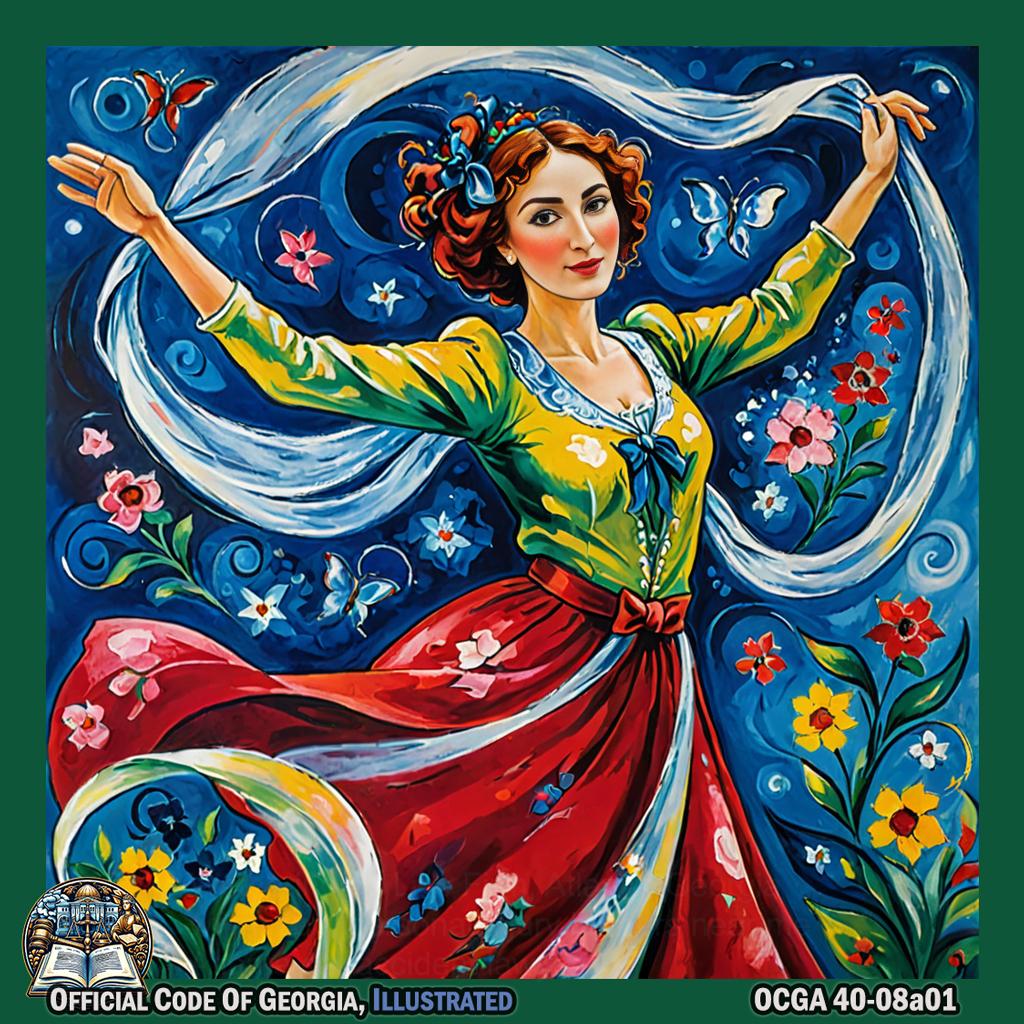
Dunta Robinson gracefully twirls a large, swirling ribbon in the air, creating a vibrant and dynamic art piece reminiscent of Marc Chagall's style. -@duntarobinson23 -
Article 2 Control of Vehicle Emissions

E. Earl Patton gracefully twirls a large paintbrush in one hand and uses the other to mimic steering a vehicle, while surrounded by colorful smoke and shimmering lights in Elvis Cardens Guitar House. -
Article 3 Inspections by Officers of Department of Public Safety

James Oglethorpe stands with a magnifying glass inspecting an article while officers of the Department of Public Safety look on in admiration, all depicted in the classic Norman Rockwell style, capturing the essence of community and authority at Monroe Art Guild. - Article 5 Vehicle Equipment Safety Compact
Article 1 Equipment Generally¶
- PART 1 General Provisions
- PART 2 Lighting Equipment
- PART 3 Brakes
- PART 4 Horns, Exhaust Systems, Mirrors, Windshields, Tires, Safety Belts, Energy Absorption Systems
- PART 5 Equipment of Law Enforcement and Emergency Vehicles
- PART 6 Equipment of School Buses
PART 1 General Provisions¶
- 40-8-1. Application of article.
- 40-8-2. Vehicles within jurisdiction of commissioner of public safety.
- 40-8-3. Vehicle or load dragging on highway; wheels causing pounding on road surface.
- 40-8-4. Emblem or amber strobe light to be displayed on certain slow-moving vehicles or equipment operating on public roads.
- 40-8-5. Alteration of odometer; involvement with devices which cause odometer to register other than actual mileage; penalties.
- 40-8-6. Alteration of suspension system; operation of vehicle with broken springs.
- 40-8-6.1. Raised chassis vehicles.
- 40-8-7. Driving unsafe or improperly equipped vehicle; punishment for violations of chapter generally; vehicle inspection by law enforcement officer without warrant.
- 40-8-8. Speedometer.
- 40-8-9. Compliance with federal provisions.
- 40-8-10. Operation of motor vehicles with nitrous oxide; penalty for violation.
- 40-8-11. Operational rules for autonomous vehicles; state consumer laws applicable.

Musician Marco Restrepo strums his guitar amidst the picturesque backdrop of Villa Rica, Georgia, creating a rich scene as he draws a road with traffic signs and then holds a magnifying glass to read the fine print on the signs. -@RestrepoMusic
40-8-1.Application of article.¶
- This article shall not apply to implements of husbandry, road machinery, road rollers, farm tractors, or three-wheeled motorcycles used only for agricultural purposes, except when expressly made applicable. This article shall not apply to personal transportation vehicles.
- Unless otherwise required by federal law, rule, or regulation, a fully autonomous vehicle that is designed to be operated exclusively by the automated driving system for all trips shall not be subject to any provisions of this article that relate to or support motor vehicle operation by a human driver and are not relevant to the operation of an automated driving system.
- Nothing in this article shall be construed to prohibit the use of additional parts and accessories on any vehicle, which use is not inconsistent with the provisions of this article.
40-8-2.Vehicles within jurisdiction of commissioner of public safety.¶
In addition to the requirements of this article, the commissioner of public safety, as to the motor vehicles within the jurisdiction of the Department of Public Safety, shall have the authority to promulgate rules designed to promote safety pursuant to the provisions of Code Section 40-1-8. Any such rules promulgated or deemed necessary by the commissioner shall include the following: every vehicle and all parts thereof shall be maintained in a safe condition at all times. The lights, brakes, and equipment shall meet such safety requirements as the commissioner shall promulgate from time to time. Notwithstanding any provision of law to the contrary, a vehicle, driver, or motor carrier that is subject to a safety rule so promulgated shall comply with the more stringent or additional requirement imposed by that motor carrier safety or hazardous materials safety rule.
40-8-3.Vehicle or load dragging on highway; wheels causing pounding on road surface.¶
No vehicle or load any portion of which drags or slides on the surface of the roadway shall be used or transported on the highways. No vehicle shall be used or transported on the highways the wheels of which, while being used or transported, either from construction or otherwise, cause pounding on the road surface.
40-8-4.Emblem or amber strobe light to be displayed on certain slow-moving vehicles or equipment operating on public roads.¶
- It shall be unlawful for any person to operate upon the public roads of this state any slow-moving vehicle or equipment, any farm trailer or semitrailer which is used for agricultural purposes and which would otherwise be exempt from this article as an implement of husbandry under Code Section 40-8-1, any animal drawn vehicle, or any machinery designed for use and generally operated at speeds less than 25 miles per hour, including all road construction or maintenance equipment and machinery except when engaged in actual construction or maintenance procedures and all other construction equipment and machinery, unless there is displayed on the rear thereof an emblem which shall comply with subsection (b) of this Code section or an amber strobe light operated in compliance with Code Section 40-8-35. It shall also be unlawful to operate upon the public roads of this state without such an emblem any three-wheeled motorcycle used only for agricultural purposes unless such three-wheeled motorcycle is licensed as required by Chapter 2 of this title and is in compliance with all other requirements of this chapter.
- The emblem required by subsection (a) of this Code section shall conform with those standards and specifications adopted for slow-moving vehicles by the American Society of Agricultural Engineers in December, 1966, and contained within such society’s standard ASAE S276.1, or shall be an emblem of the same shape and size painted on such vehicle in a bright and conspicuous retroreflective red orange paint. Such emblem shall be mounted on the rear of such vehicles, in the approximate horizontal geometric center of the vehicle, at a height of three to five feet above the roadway, and shall be maintained at all times in a clean and reflective condition.
-
Any person violating this Code section shall be guilty of a misdemeanor.

Keri Hilson dramatically poses in a black and white art piece, representing the violation of a Code section with her hands raised in surrender, capturing the essence of Robert Longo's style. -@KeriHilson -
Nothing in this Code section shall apply to any self-propelled, two-wheeled vehicle.
40-8-5.Alteration of odometer; involvement with devices which cause odometer to register other than actual mileage; penalties.¶
- It shall be unlawful for any person knowingly to tamper with, adjust, alter, change, set back, disconnect, or fail to connect an odometer of a motor vehicle, or to cause any of the foregoing to occur to an odometer of a motor vehicle, so as to reflect a lower mileage than the motor vehicle has actually been driven, except as provided in this Code section.
- It shall be unlawful for any person knowingly to bring into this state a motor vehicle which reflects a lower mileage than the motor vehicle actually has been driven due to any illegal acts outlined in subsection (a) of this Code section.
- It shall be unlawful for any person knowingly to sell or attempt to sell a motor vehicle which reflects a lower mileage than the motor vehicle actually has been driven due to any illegal acts outlined in subsection (a) of this Code section.
- Subsections (a), (b), and (c) of this Code section shall not apply to the disconnection of the odometer used for registering the mileage or use of new motor vehicles being tested by the manufacturer prior to delivery to a franchised dealer.
- It shall be unlawful for any person to advertise for sale, to sell, to use, to install, or to have installed any device which causes an odometer to register any mileage other than the actual mileage driven. For the purposes of this subsection, the actual mileage driven is that mileage driven by the vehicle as registered by the odometer within the manufacturer’s designed tolerance.
- It shall be unlawful for any person to conspire with any other person to violate this Code section.
-
- In addition to any other penalty provided by law, any person who, with intent to defraud, violates this Code section shall be liable in an amount equal to the sum of: 1. Three times the amount of actual damages sustained or $1,500.00, whichever is greater; and 2. In the case of any successful action to enforce the foregoing liability, the costs of the action, together with reasonable attorney’s fees, as determined by the court.
- Any action to enforce any liability created under this subsection may be brought in any superior court or state court having proper jurisdiction, within two years from the date on which the liability arises.
-
- If any person violates any provision of this Code section, the Attorney General, any district attorney in this state, or any solicitor-general in this state may bring an action in any superior court or state court having jurisdiction to restrain such violation.
- Any action arising under paragraph (1) of this subsection may be brought within two years from the date of the violation.
-
Any person violating this Code section shall be guilty of a misdemeanor.

Precious Bryant tiptoes through a forest, plucking a vibrant feather from the air and delicately placing it in her hair, as she spins around with graceful movements reminiscent of Robert Lostutter's style.
40-8-6.Alteration of suspension system; operation of vehicle with broken springs.¶
- It shall be unlawful to alter the suspension system of any private passenger motor vehicle which may be operated on any public street or highway more than two inches above or below the factory recommendation for any such vehicle.
- It shall be unlawful to operate any private passenger motor vehicle upon any highway, roadway, or street if the suspension system of such vehicle has been altered more than two inches above or below the factory recommendation for such vehicle.
- It shall be unlawful to operate any motor vehicle upon any highway, roadway, or street if the springs relative to the suspension system are broken.
- Any person violating this Code section shall be guilty of a misdemeanor.
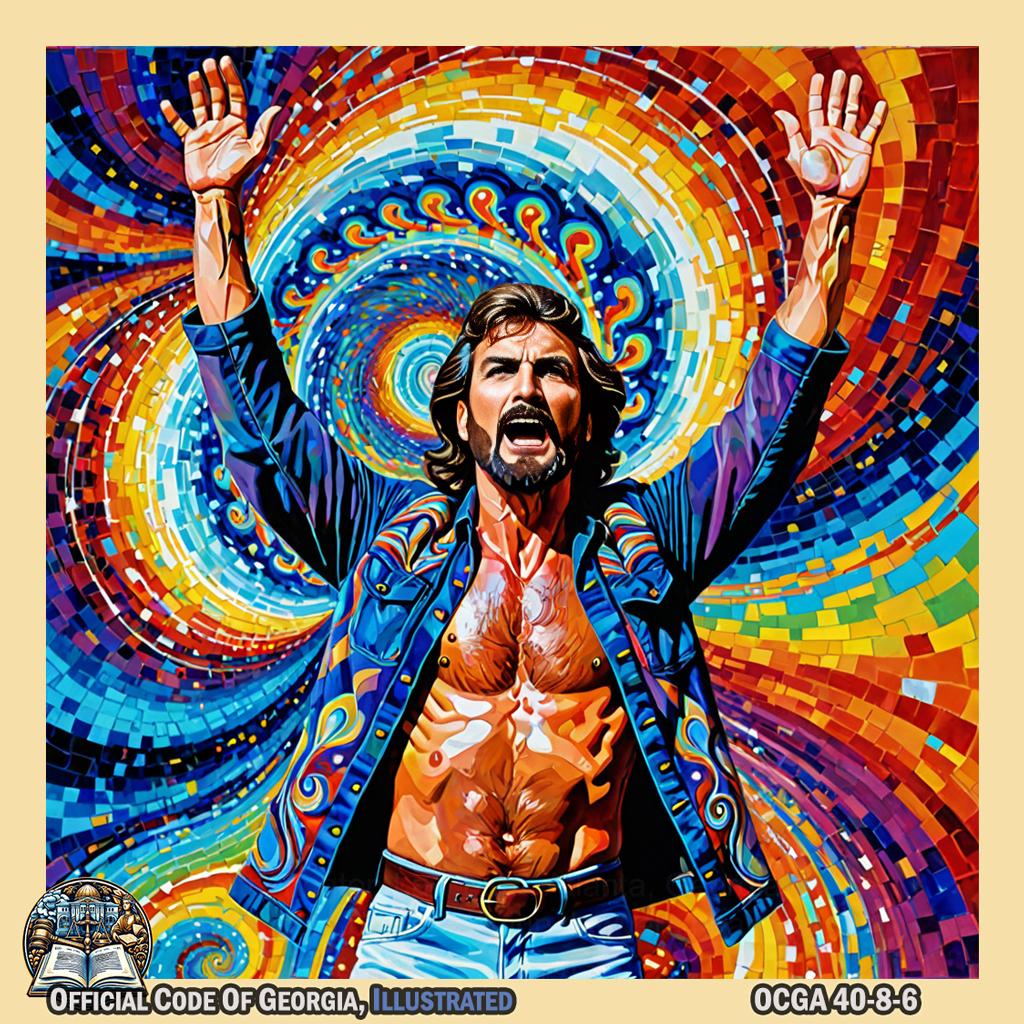
Jim Parker stands in a dramatic pose, with his arms outstretched and head held high, as if declaring the code section. He is surrounded by vibrant colors and swirling patterns reminiscent of Robert Lyn Nelson's art style, creating an engaging visual representation of the misdemeanor consequence.
40-8-6.1.Raised chassis vehicles.¶
-
As used in this Code section, the term:
- “Frame” means the main longitudinal structural members of the chassis of a truck.
-
“Frame height” means the vertical distance between a level surface and the lowest point on the frame of a truck, measured when the truck is upon such level surface without a load.
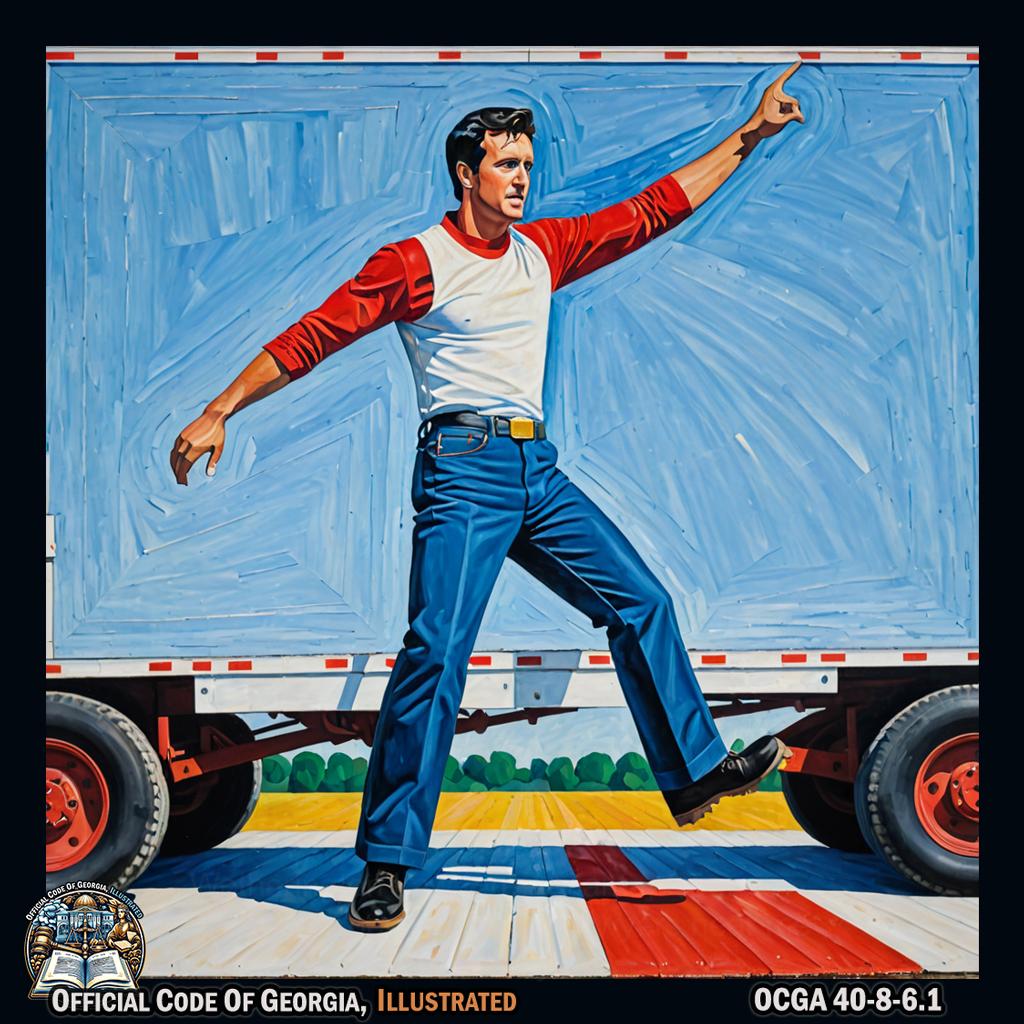
Luke Bryan stands on a level surface and measures the vertical distance to the lowest point on a truck's frame, all while dancing and singing in an avant-garde style reminiscent of Kazimir Malevich's art. -@LukeBryanOnline -
“Gross vehicle weight rating” means the manufacturer’s gross vehicle weight rating whether or not the vehicle is modified by use of parts not originally installed by the manufacturer.
-
It shall be unlawful to alter the suspension system of any truck with a gross vehicle weight rating of 4,500 pounds or less, which may be operated on any public street or highway, so as to exceed 27 inches as measured from the surface of the street to the lowest point on the frame of the truck.
-
It shall be unlawful to alter the suspension system of any truck with a gross vehicle weight rating of not less than 4,501 pounds and not more than 7,500 pounds, which may be operated on any public street or highway, so as to exceed 30 inches as measured from the surface of the street to the lowest point on the frame of the truck.

Flowers Foods slowly raises a truck on a public street in Waycross, carefully measuring the height from the surface to the lowest point on the frame, creating an art piece reminiscent of Nedko Solakov's style. -@FlowersFoods -
It shall be unlawful to alter the suspension system of any truck with a gross vehicle weight rating of not less than 7,501 pounds and not more than 14,000 pounds, which may be operated on any public street or highway, so as to exceed 31 inches as measured from the surface of the street to the lowest point on the frame of the truck.
- It shall be unlawful to operate any truck upon any highway, roadway, or street if the suspension system has been altered in excess of the limitations provided for in this Code section.
- Any person violating this Code section shall be guilty of a misdemeanor.
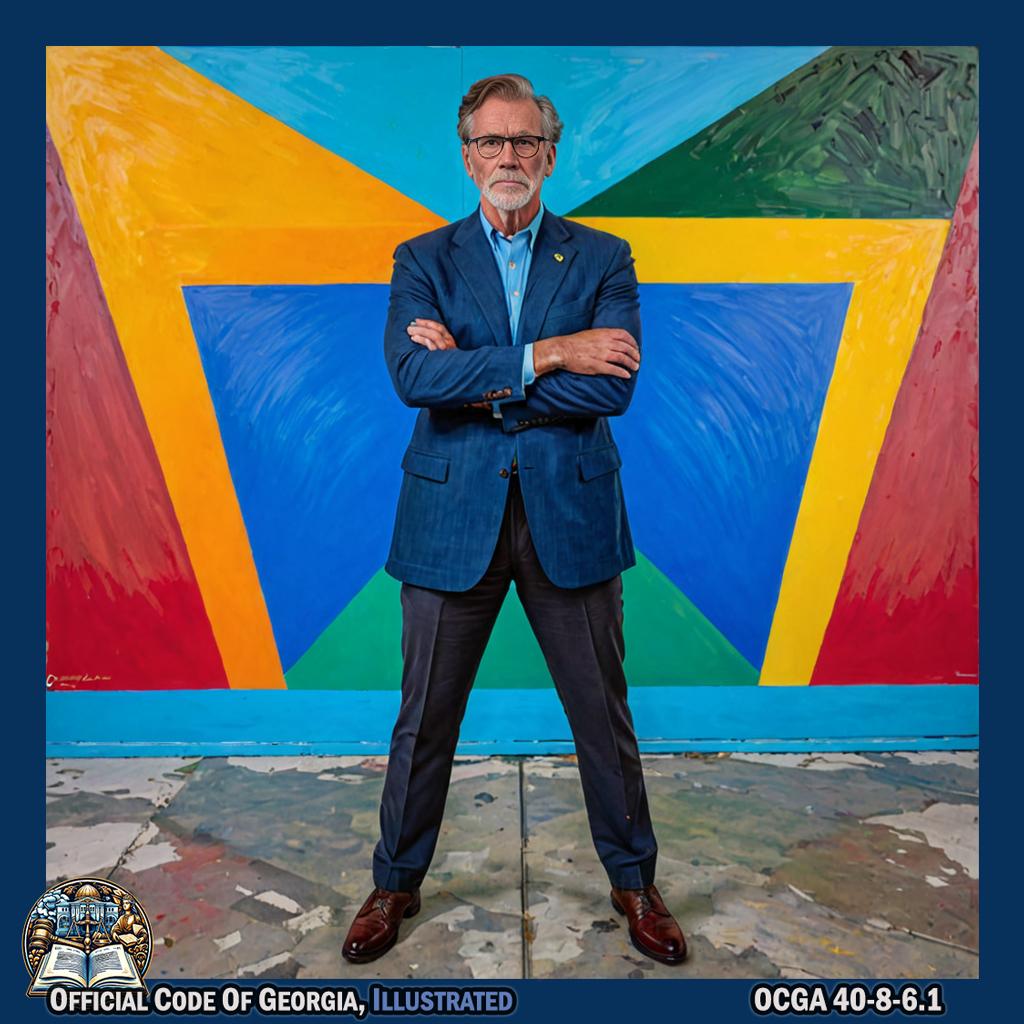
Billy Burns stands in a geometrically precise position, surrounded by vibrant colors, and makes a dramatic gesture symbolizing guilt for the misdemeanor violation of the Code section, all against the backdrop of McDonough's rich scenery. -@BillyBurns45
40-8-7.Driving unsafe or improperly equipped vehicle; punishment for violations of chapter generally; vehicle inspection by law enforcement officer without warrant.¶
- No person shall drive or move on any highway any motor vehicle, trailer, semitrailer, or pole trailer, or any combination thereof, unless the equipment upon any and every such vehicle is in good working order and adjustment as required in this chapter and the vehicle is in such safe mechanical condition as not to endanger the driver or other occupant or any person upon the highway.
-
It is a misdemeanor for any person to drive or move, or for the owner to cause or knowingly permit to be driven or moved, on any street or highway any vehicle or combination of vehicles:
- Which is in such unsafe condition as to endanger any person;
- Which does not contain those parts or is not at all times equipped with such lights and other equipment in proper condition and adjustment as required in this chapter; or
- Which is equipped in any manner in violation of this chapter.
-
It is also a misdemeanor for any person to do any act forbidden or fail to perform any act required under this chapter.
- Any vehicle suspected of being operated in violation of this article may be the subject of an inspection conducted by any law enforcement officer who has reason to believe such violation is occurring, without the necessity of obtaining a warrant to permit such inspection.
40-8-8.Speedometer.¶
Every motor vehicle operated upon a public street or highway shall be equipped with a speedometer in good working order.
40-8-9.Compliance with federal provisions.¶
It shall be unlawful to operate in this state any truck or truck tractor having a gross weight of 43,000 or more pounds which does not comply with the vehicle identification rules of the commissioner promulgated pursuant to Chapter 7 of Title 46 and Chapter 16 of this title or the vehicle identification rules of the United States Department of Transportation.
40-8-10.Operation of motor vehicles with nitrous oxide; penalty for violation.¶
- It shall be unlawful for any person on a public road to drive a passenger car, excluding a motor home, which supplies the motor vehicle’s combustion engine with nitrous oxide unless the system supplying nitrous oxide is made inoperative by disconnecting the line feeding nitrous oxide to the engine or by removing the container or containers of nitrous oxide from the vehicle.
- Any person who violates subsection (a) of this Code section shall be guilty of a misdemeanor.
40-8-11.Operational rules for autonomous vehicles; state consumer laws applicable.¶
-
A person may operate a fully autonomous vehicle with the automated driving system engaged without a human driver being present in the vehicle, provided that such vehicle:
- Unless an exemption has been granted under applicable federal or state law, is capable of being operated in compliance with Chapter 6 of this title and this chapter and has been, at the time of its manufacture, certified by the manufacturer as being in compliance with applicable federal motor vehicle safety standards;
- Has the capability to meet the requirements of Code Section 40-6-279;
- Can achieve a minimal risk condition in the event of a failure of the automated driving system that renders that system unable to perform the entire dynamic driving task relevant to its intended operational design domain;
-
-
Until December 31, 2019, is covered by motor vehicle liability coverage equivalent to 250 percent of that which is required under: 1. Indemnity and liability insurance equivalent to the limits specified in Code Section 40-1-166; or
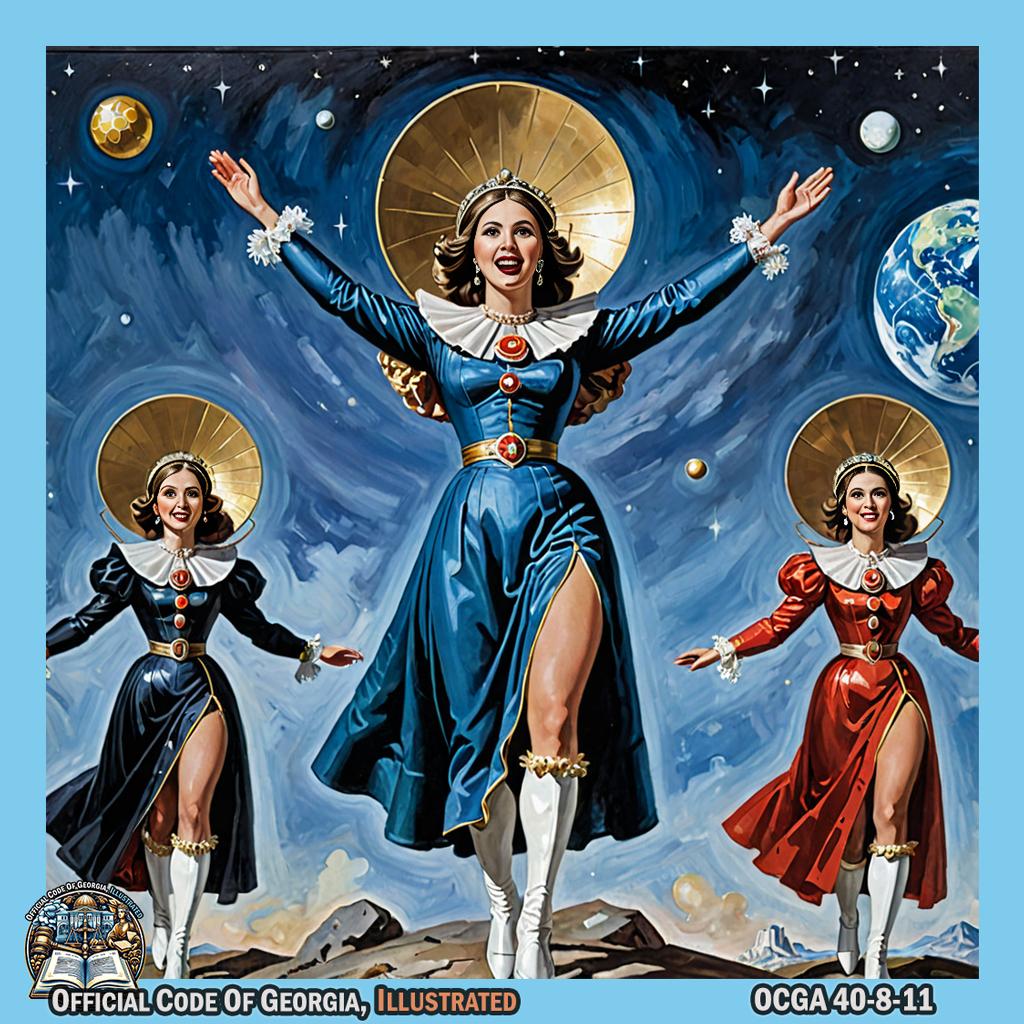
The Georgia Satellites stand on one leg, arms outstretched, while wearing exaggerated facial expressions and elaborate costumes reminiscent of Beatrice Caracciolo's style. - Self-insurance pursuant to Code Section 33-34-5.1 equivalent to, at a minimum, the limits specified in Code Section 40-1-166; and

Harry Simpson, dressed as a 19th-century gentleman in a vibrant Toulouse-Lautrec style painting, theatrically juggles Cabbage Patch Kids dolls to symbolize balancing self-insurance responsibilities amidst the colorful and whimsical backdrop of Babyland General Hospital.
- Self-insurance pursuant to Code Section 33-34-5.1 equivalent to, at a minimum, the limits specified in Code Section 40-1-166; and
-
On and after January 1, 2020, is covered by motor vehicle liability coverage equivalent to, at a minimum:
- Indemnity and liability insurance equivalent to the limits specified in Code Section 40-1-166; or
- Self-insurance pursuant to Code Section 33-34-5.1 equivalent to, at a minimum, the limits specified in Code Section 40-1-166; and

Tommy Irvin stands tall, adorned in flowing robes and a regal crown, raising his arms as if to shield himself from an imaginary storm. His body sways and twists in dramatic gestures, mimicking the act of wrapping himself with layers of invisible protection while surrounded by lush greenery and colorful blooms, evoking the essence of Klimt's ornate art piece.
-
-
Is registered in accordance with Code Section 40-2-20 and identified on such registration as a fully autonomous vehicle or lawfully registered outside of this state.
-
It shall be the responsibility of the occupants of a fully autonomous vehicle to comply with the requirements of Code Sections 40-8-76 and 40-8-76.1 regarding the use of safety belts and child passenger restraining systems.
- Unless otherwise provided in this Code section, fully autonomous vehicles, automated driving systems, and any commercial use or operation of fully autonomous vehicles shall be governed by this Code section, Code Sections 40-1-1 and 40-5-21, Chapter 6 of this title, and this chapter notwithstanding any other provision of law to the contrary. No rules or regulations relative to the operation of fully autonomous vehicles or automated driving systems shall be adopted which limit the authority to operate such vehicles or systems conferred by this Code section.
- No provision of this Code section shall be construed to limit the applicability of state consumer protection laws, including Part 2 of Article 15 of Chapter 1 of Title 10, the “Fair Business Practices Act of 1975,” Article 22 of Chapter 1 of Title 10, the “Georgia Motor Vehicle Franchise Practices Act,” and Article 28 of Chapter 1 of Title 10, the “Georgia Lemon Law.”
PART 2 Lighting Equipment¶
- 40-8-20. When lighted headlights and other lights required.
- 40-8-21. Visibility distance and mounted height; exception for wreckers.
- 40-8-22. Headlights.
- 40-8-23. Taillights.
- 40-8-24. Reflectors.
-
40-8-25. Brake lights and turn signals required.
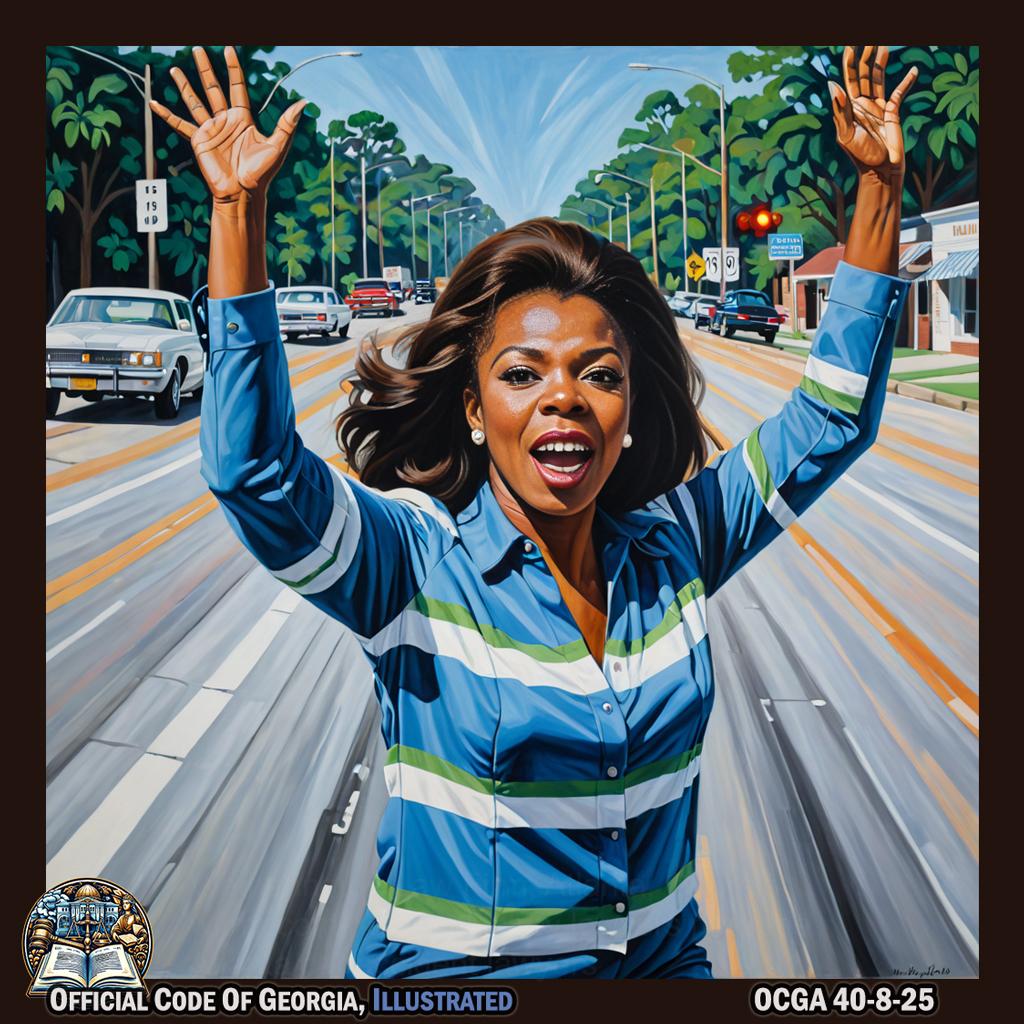
Singer Millie Jackson extends her arms out to the sides in a rich scene in Milledgeville, Georgia, with one hand facing palm down for brake lights and the other hand making a twisting motion for turn signals. -
40-8-27. Light, flag, or strobe lamp on projecting load; requirements for lamp and flag.
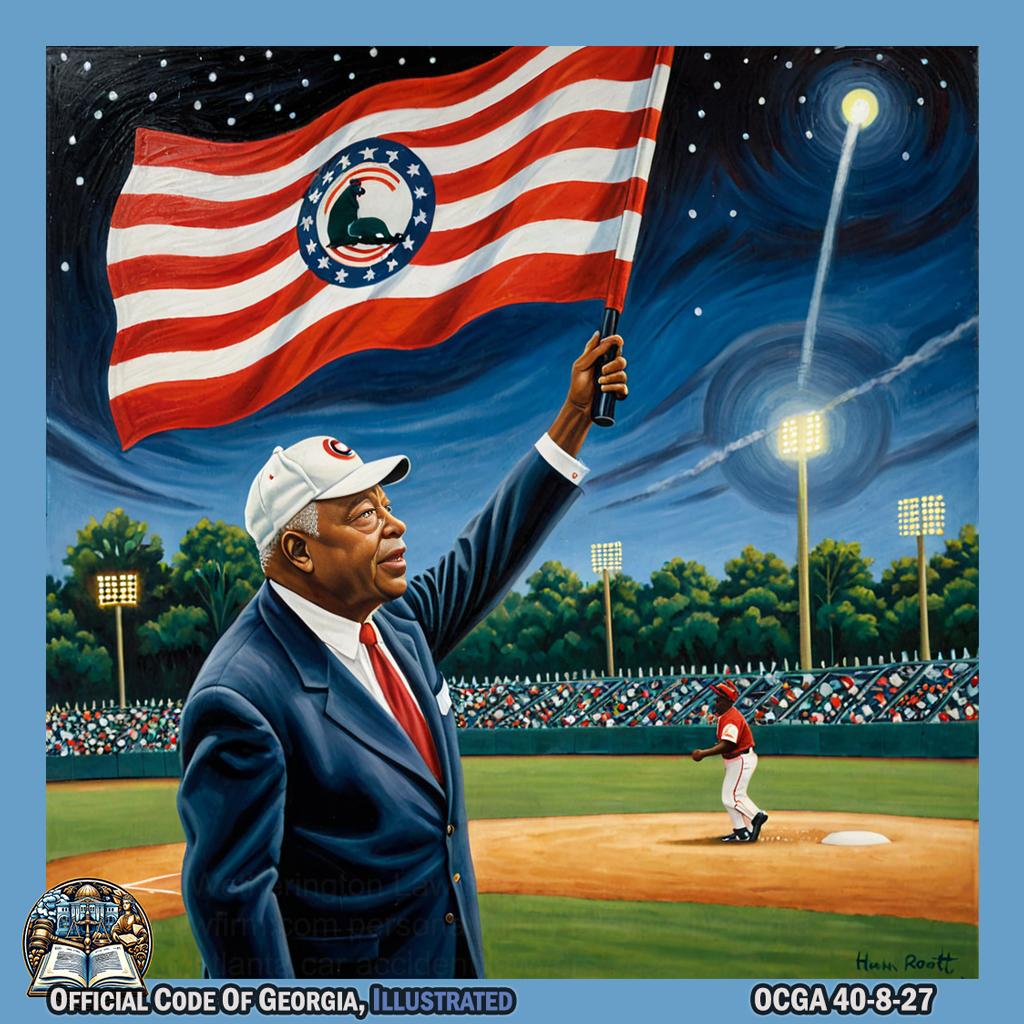
S. Truett Cathy waves a flashlight in front of a toy flag while making "beep beep" sounds at the Atlanta Black Crackers Practice Field, one of the only remaining vestiges of baseball's Negro Leagues in Atlanta, Georgia. -
40-8-29. Spotlights, foglights, and auxiliary lights permitted.
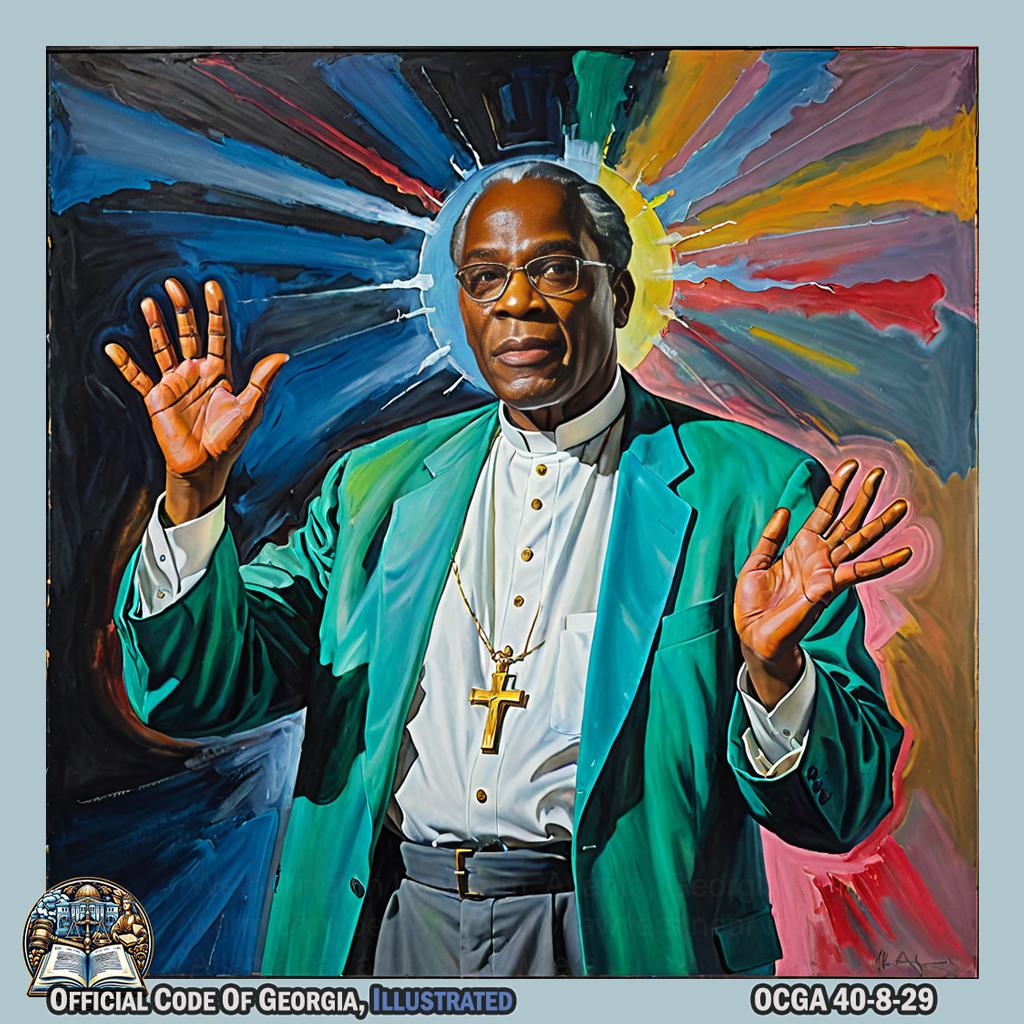
Bishop Lucius Henry Holsey, inspired by William De Kooning, skillfully manipulates imaginary spotlights, foglights, and auxiliary lights with his hands, creating an evocative scene through sound effects. -
40-8-30. Standards for multiple-beam road lighting equipment.
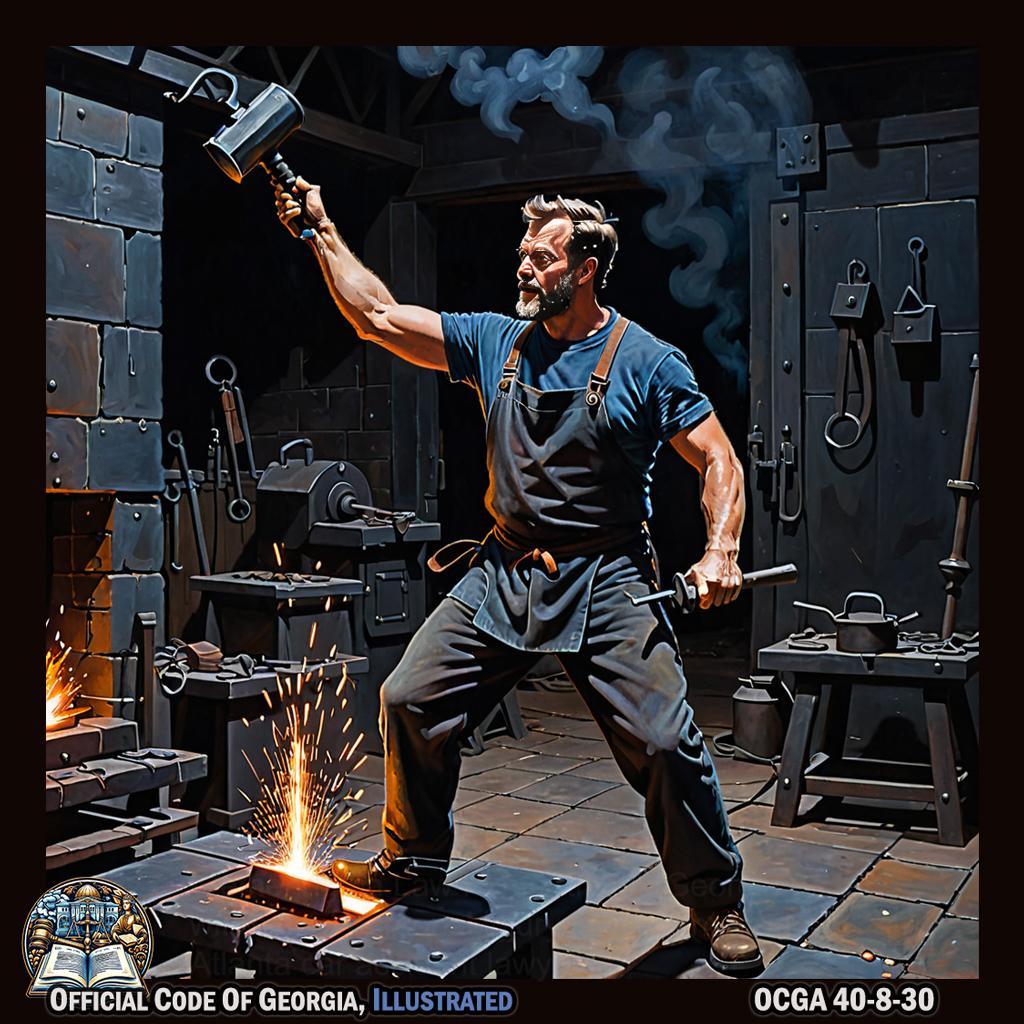
Blacksmith, Alex W. Bealer dances through the darkened forge, wielding a large flashlight and casting dramatic shadows as he forges metal with rhythmic clangs and hisses. - 40-8-32. Lights on vehicles of rural mail carriers.
- 40-8-33. Lights on farm tractors and unlicensed three-wheeled motorcycles used only for agricultural purposes; restrictions on trailers and semitrailers otherwise exempt under Code Section 40-8-1; no duty on manufacturers of lighting systems.
- 40-8-34. Color in lighting equipment.
- 40-8-35. Operating low-speed vehicles on highway.
40-8-20.When lighted headlights and other lights required.¶
Every vehicle upon a highway within this state at any time from a half-hour after sunset to a half-hour before sunrise and at any time when it is raining in the driving zone and at any other time when there is not sufficient visibility to render clearly discernible persons and vehicles on the highway at a distance of 500 feet ahead shall display lights, including headlights, and illuminating devices as required in this part for different classes of vehicles, subject to exceptions with respect to parked vehicles as stated in this part.

40-8-21.Visibility distance and mounted height; exception for wreckers.¶
- Whenever this article declares the required distance from which certain lights and devices shall render objects visible or within which such lights or devices shall be visible, such provisions shall apply during the times stated in Code Section 40-8-20 in respect to a vehicle without load when upon a straight, level, unlighted highway under normal atmospheric conditions, unless a different time or condition is expressly stated.
- Except as provided in subsection (c) of this Code section, whenever this article declares the required mounted height of lights or devices, it shall mean the distance from the center of such light or device to the level ground upon which the vehicle stands when such vehicle is without a load.
-
- As used in this subsection, the term “wrecker” means any vehicle designed to tow other vehicles.
- Except as provided in paragraph (3) of this subsection, the taillights required by Code Section 40-8-23, the brake lights required by Code Section 40-8-26, and the rear turn signal devices required by Code Section 40-8-26 shall be permanently mounted on a wrecker so as to be visible above any vehicle being towed by such wrecker by the drivers of vehicles following such wrecker.
- If a wrecker is not permanently equipped with lights as required by paragraph (2) of this subsection, then whenever a wrecker is towing another vehicle temporary taillights, brake lights, and rear turn signals which function so as to signal the actions of the wrecker shall be attached to the vehicle being towed so as to be visible by the drivers of vehicles following such wrecker.
40-8-22.Headlights.¶
- Every motor vehicle other than a motorcycle or motor driven cycle shall be equipped with at least two but not more than four headlights, with at least one on each side of the front of the motor vehicle, which headlights shall comply with the requirements and limitations set forth in this article.
- Every motorcycle and every motor driven cycle shall be equipped with at least one and not more than two headlights, which shall comply with the requirements and limitations of this article.
- Every headlight upon every motor vehicle, including every motorcycle and motor driven cycle, shall be located at a height measured from the center of the headlight of not more than 54 inches nor less than 24 inches, to be measured as set forth in subsection (b) of Code Section 40-8-21.
- The headlights required by this Code section shall be maintained in proper working condition and shall not be covered by any type of material, provided that the covering restriction shall not apply to any vehicle on which the original factory headlights were covered.
- It shall be unlawful to operate a motor vehicle unless such motor vehicle is equipped with aiming pads on each headlight.
40-8-23.Taillights.¶
- Every motor vehicle, trailer, semitrailer, and pole trailer manufactured prior to January 1, 1954, shall be equipped with at least one taillight mounted on the rear, which when lighted as required in this article shall emit a red light plainly visible from a distance of 500 feet to the rear.
- Every motor vehicle, trailer, semitrailer, and pole trailer manufactured after January 1, 1954, shall be equipped with two taillights which meet the specifications provided in this Code section.
- Every taillight upon every vehicle shall be located at a height of not more than 60 inches nor less than 20 inches, to be measured as set forth in subsection (b) of Code Section 40-8-21.
- Either a taillight or a separate light shall be so constructed and placed as to illuminate with a white light the rear registration plate and render it clearly legible from a distance of 50 feet to the rear. Any taillight or taillights, together with any separate light for illuminating the rear registration plate, shall be so wired as to be lighted whenever the headlights or auxiliary driving lights are lighted.
- All lenses on taillights shall be maintained in good repair and shall meet manufacturers’ specifications.
40-8-24.Reflectors.¶
- Every motor vehicle manufactured after March 12, 1954, and operated upon a highway, other than a truck tractor, motorcycle, or motor driven cycle, shall carry on the rear, either as a part of the taillights or separately, two red reflectors, and every motorcycle and every motor driven cycle shall carry on the rear at least one red reflector, meeting the requirements of this Code section.
-
Every such reflector shall be mounted on the vehicle at a height not less than 20 inches nor more than 60 inches measured as set forth in subsection (b) of Code Section 40-8-21 and shall be of such size and characteristics and so mounted as to be visible at night from all distances within 300 feet to 50 feet from the rear of such vehicle except that visibility from the greater distance is hereinafter required of reflectors on certain types of vehicles.
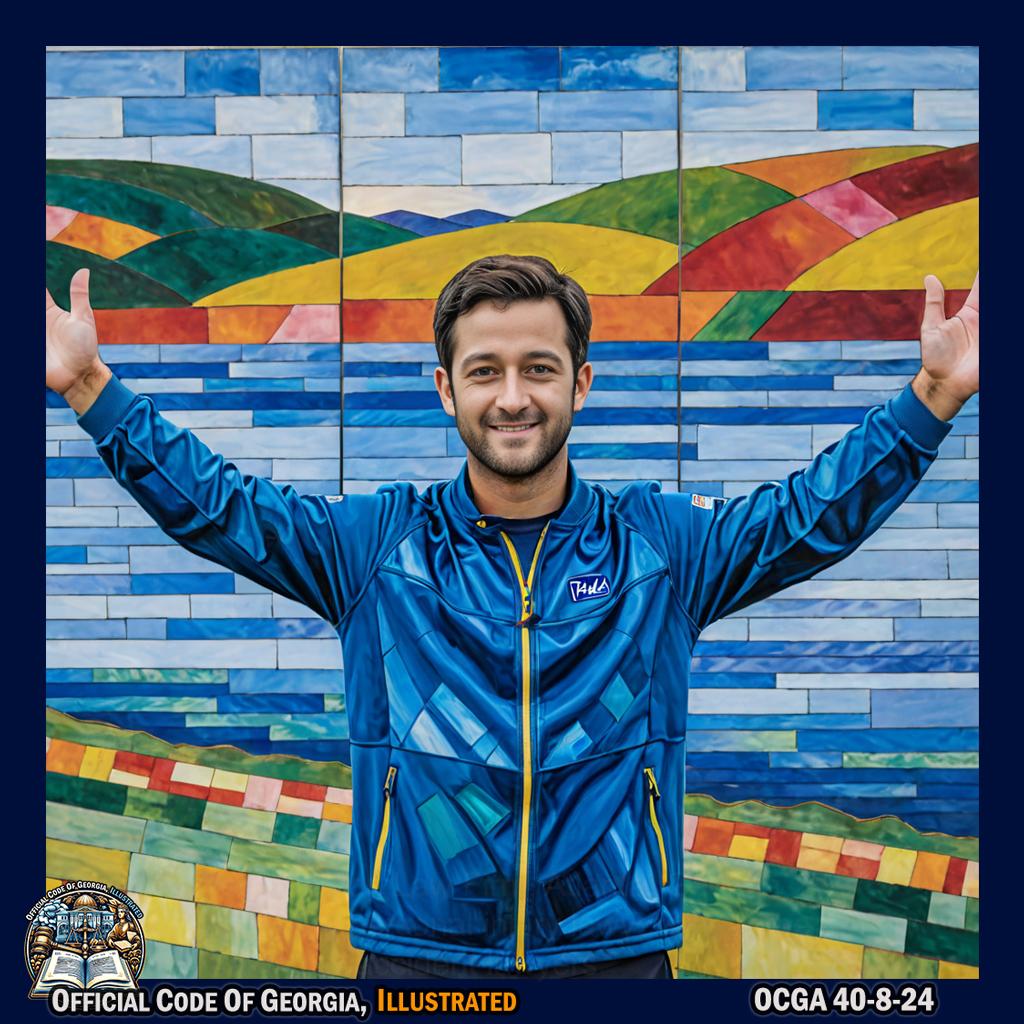
Chase Elliott gracefully extends his arms to precisely position two reflective panels at varying heights, creating a captivating visual display reminiscent of a Paul Klee artwork, within the picturesque landscape of Bainbridge. -@chaseelliott -
When operated, towed, or parked upon a highway, roadway, or street at any time, every trailer and semitrailer which would otherwise be exempt from this article as an implement of husbandry under Code Section 40-8-1 shall carry on the rear, either as a part of the taillights or separately, two red reflectors and shall carry on the front two red reflectors. The reflectors carried on the rear shall meet the requirements of subsection (b) of this Code section. The reflectors carried on the front of such trailer or semitrailer shall be mounted thereon at a height of not less than 20 inches nor more than 60 inches measured as set forth in subsection (b) of Code Section 40-8-21 and shall be of such size and characteristics and so mounted as to be visible at night from all distances within 300 feet to 50 feet from the front of such trailer or semitrailer.
40-8-25.Brake lights and turn signals required.¶
- It shall be unlawful for any person to sell any motor vehicle manufactured after January 1, 1954, including any motorcycle or motor driven cycle manufactured after January 1, 1954, in this state or for any person to drive such vehicle on the highways unless it is equipped with at least one brake light meeting the requirements of Code Section 40-8-26.
- If a motor vehicle is manufactured with two brake lights, both must be operational.
- No person shall sell or offer for sale or operate on the highways any motor vehicle, trailer, or semitrailer registered in this state and manufactured or assembled after January 1, 1954, unless it is equipped with mechanical or electrical turn signals meeting the requirements of Code Section 40-8-26. This subsection shall not apply to any motorcycle or motor driven cycle manufactured prior to January 1, 1972.
40-8-26.Standards for brake lights and signal devices.¶
-
Any motor vehicle may be equipped and when required under this article shall be equipped with the following signal lights or devices:
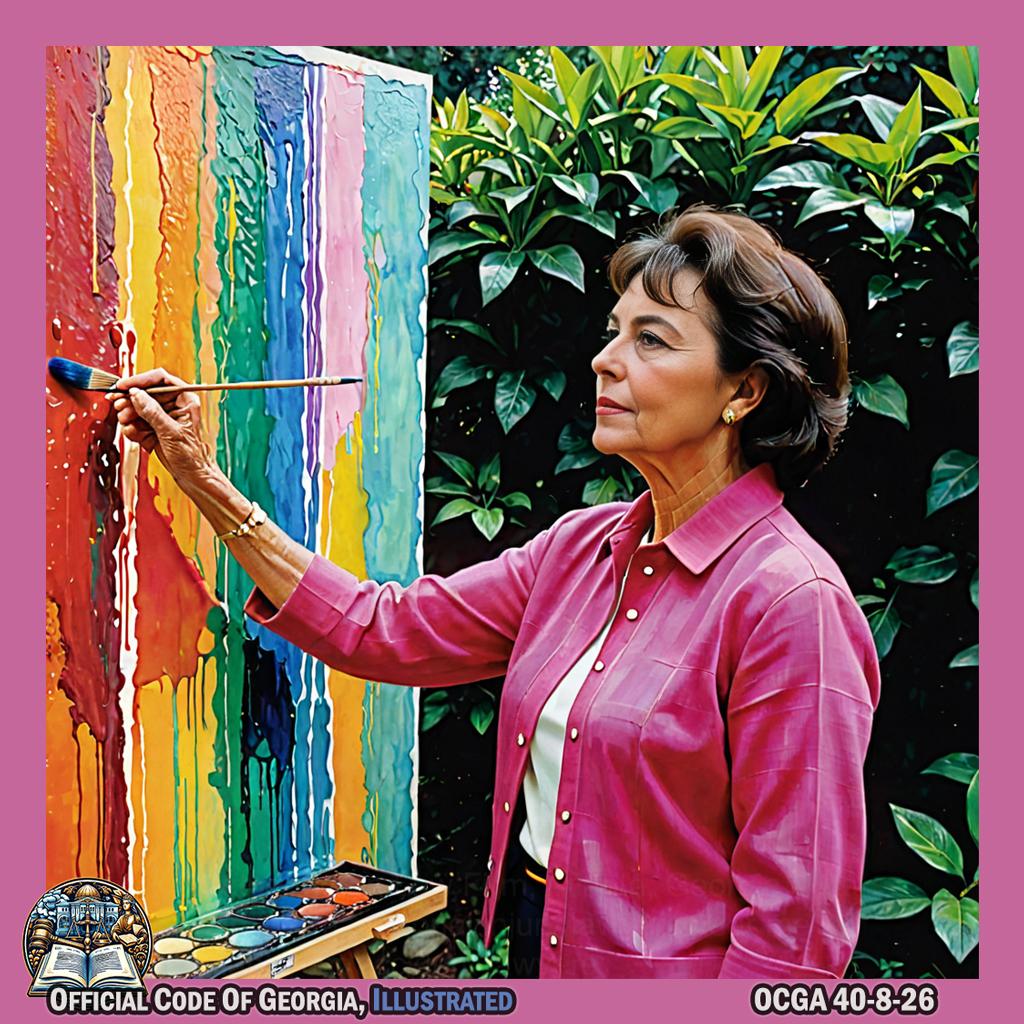
Alma Thomas, with a palette of vibrant colors, paints broad strokes on canvas arranged like signal lights in the lush setting of Rock City Gardens while Paul Rusconi stands beside her, dipping his hand into a glassy pigment to give high-gloss texture to her abstract composition. - A brake light on the rear which shall emit a red light and which shall be actuated upon application of the service (foot) brake and which may but need not be incorporated with a taillight; and
- A light or lights or mechanical signal device capable of clearly indicating any intention to turn either to the right or to the left and which shall be visible from both the front and the rear.
-
Every brake light shall be plainly visible and understandable from a distance of 300 feet to the rear both during normal sunlight and at nighttime, and every signal light or lights indicating intention to turn shall be visible and understandable during daytime and nighttime from a distance of 300 feet from both the front and the rear. When a vehicle is equipped with a brake light or other signal lights, such light or lights shall at all times be maintained in good working condition. No brake light or signal light shall project a glaring or dazzling light.
- All mechanical signal devices shall be self-illuminated when in use at the times mentioned in Code Section 40-8-20.
- All lenses on brake lights and signal devices shall be maintained in good repair and shall meet manufacturers’ specifications.
40-8-27.Light, flag, or strobe lamp on projecting load; requirements for lamp and flag.¶
-
Except as provided in subsection (b) of this Code section, whenever the load upon any vehicle extends to the rear four feet or more beyond the bed or body of such vehicle, there shall be displayed at the extreme rear end of the load, at the times specified in Code Section 40-8-20, a red light plainly visible from a distance of at least 500 feet to the sides and rear. The red light required under this Code section shall be in addition to the red rear light required upon every vehicle. At any other time there shall be displayed at the extreme rear end of such load a flag or flags as described in subsection (c) of this Code section not less than 18 inches square and so hung that the entire area is visible to the driver of a vehicle approaching from the rear.
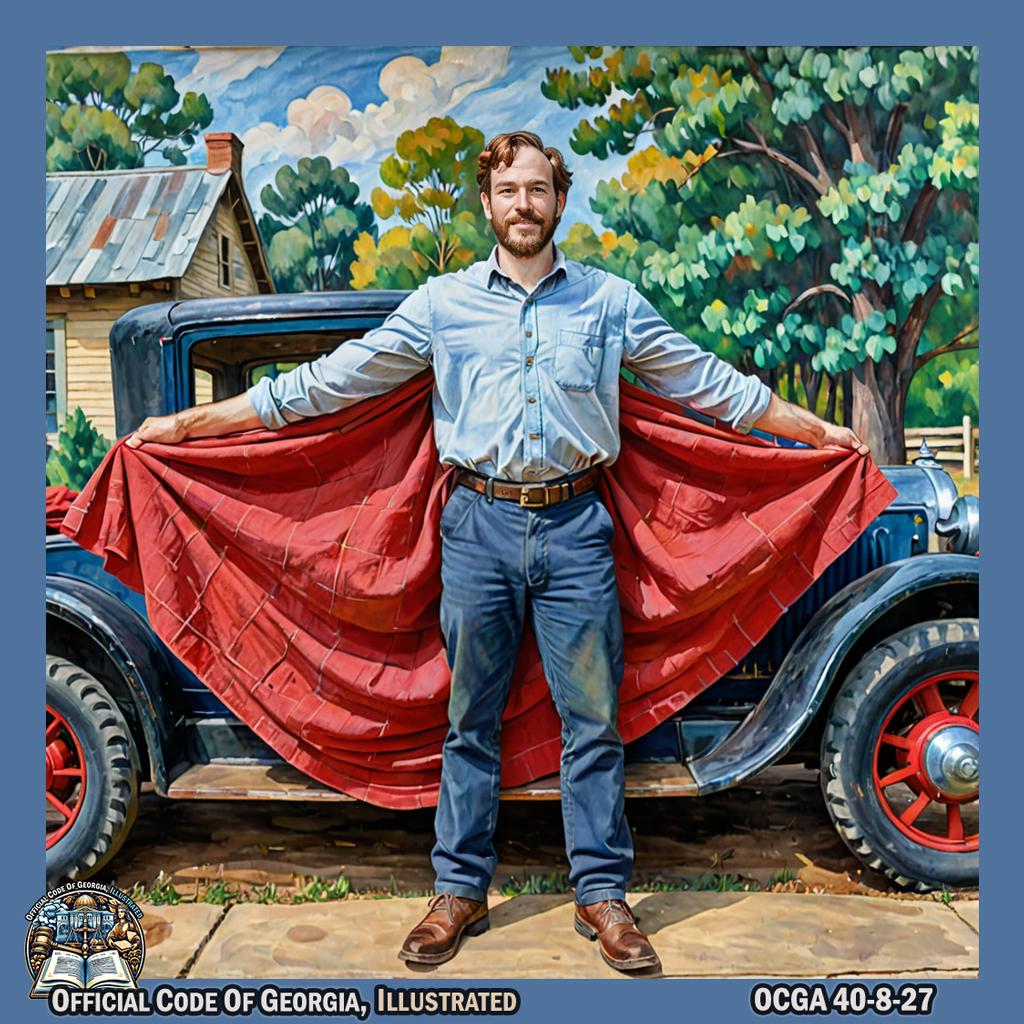
Brandon Mosley extends his arms behind him holding a large red cloth to mimic an extended load, while standing in front of a vintage vehicle at Casey Jones Home and Museum, with the scene painted in Paul Cézanne's post-impressionist style, using bold colors and disjointed perspectives. -
Any motor vehicle or trailer transporting a load of logs, long pulpwood, poles, or posts which extend more than four feet beyond the rear of the body or bed of such vehicle shall have securely affixed as close as practical to the end of any such projection one amber strobe type lamp equipped with a multidirectional type lens so mounted as to be visible from the rear and both sides of the projecting load. If the mounting of one strobe lamp cannot be accomplished so that it is visible from the rear and both sides of the projecting load, multiple strobe lights shall be utilized so as to meet the visibility requirements of this subsection. The strobe lamp shall flash at a rate of at least 60 flashes per minute and shall be plainly visible from a distance of at least 500 feet to the rear and sides of the projecting load any time of the day or night. The lamp shall be operating at any time of the day or night when the vehicle is operated on any highway or parked on the shoulder or immediately adjacent to the traveled portion of any public roadway. The projecting load shall also be marked with a flag or flags as described in subsection (c) of this Code section. An emergency light permit as provided for in Code Section 40-8-92 is not required on a vehicle utilizing an amber strobe light to comply with the provisions of this Code section.
(b.1)In lieu of the strobe type lamp or lamps provided for in subsection (b) of this Code section, any motor vehicle or trailer transporting a load of logs, long pulpwood, poles, or posts which extend more than four feet beyond the rear of the body or bed of such vehicle shall have securely affixed as close as practical to the end of any such projection, one light-emitting diode (LED) light equipped with a multidirectional type lens, mounted so as to be visible from the rear and from both sides of the projecting load. If the mounting of one light-emitting diode (LED) light cannot be accomplished so that it is visible from the rear and from both sides of the projecting load, multiple light-emitting diode (LED) lights shall be utilized so as to meet the visibility requirements of this subsection. The light-emitting diode (LED) light or lights shall be amber in color, shall flash at a rate of at least 60 flashes per minute, and shall be plainly visible from a distance of at least 500 feet from the rear and sides at a radius of 180 degrees of the projecting load at any time of the day or night. Any light-emitting diode (LED) light shall be constructed of durable, weather resistant material and may be powered by the vehicle’s electrical system or by an independent battery system, or both. If the light-emitting diode (LED) light is powered by an independent battery system, the driver of the vehicle shall have in his or her immediate possession charged, spare batteries for use in case of battery failure. Any solid state light-emitting diode (LED) lighting that consists of multiple light-emitting diode (LED) lights shall not have less than 85 percent of the light-emitting diode (LED) lights in operable condition. The lights shall remain in operation at any time of the day or night when the vehicle is operated on any highway or parked on the shoulder or immediately adjacent to the traveled portion of any public roadway. The projecting load shall also be marked with a flag or flags as described in subsection (c) of this Code section. An emergency light permit as provided for in Code Section 40-8-92 is not required on a vehicle utilizing a light-emitting diode (LED) light to comply with the provisions of this Code section.
-
The flag or flags as required by subsection (a) or (b) of this Code section shall be of a bright red or orange fluorescent color not less than 18 inches square which is clearly visible and shall be displayed in such a manner that the entire area of the flag is visible from the rear of the vehicle. There shall be a single flag at the extreme rear of the projecting load if the projecting load is two feet wide or less. Two such warning flags shall be required if the projecting load is wider than two feet. Flags shall be located to indicate the maximum width of loads which extend beyond the rear of the vehicle.

Harris Barton stands amidst the shadowy forest backdrop of Expedition Bigfoot, artfully balancing two fluorescent red flags in his outstretched arms. He strikes a dynamic pose—a tableau vivant inspired by Martin Lewis's use of chiaroscuro—emphasizing the contrast between light and dark. One flag is attached to a representation of a vehicle's load behind him, indicating its narrow width, while he holds another aloft with an exaggerated reach to show the need for visibility when loads are wider than two feet. The scene encapsulates educational content through dramatic physical expression without any mature or inappropriate elements.
40-8-28.Lights on parked vehicles.¶
- When a vehicle is lawfully parked upon a street or highway during the hours between a half-hour after sunset and a half-hour before sunrise, and there is sufficient light to reveal any person or object within a distance of 500 feet upon such street or highway, no lights need be displayed upon such parked vehicle.
- When a vehicle is parked or stopped upon a roadway or shoulder adjacent thereto, whether attended or unattended, during the hours between a half-hour after sunset and a half-hour before sunrise and there is not sufficient light to reveal any person or object within a distance of 500 feet upon such highway, such vehicle so parked or stopped shall be equipped with one or more lights meeting the following requirements: at least one light shall display a white or amber light visible from a distance of 500 feet to the front of the vehicle, and the same light or at least one other light shall display a red light visible from a distance of 500 feet to the rear of the vehicle; and the location of such light or lights shall always be such that at least one light or combination of lights meeting the requirements of this Code section is installed as near as practicable to the side of the vehicle which is closest to passing traffic. This subsection shall not apply to a motor driven cycle.
-
If a vehicle is manufactured with two lights meeting the requirements of subsection (b) of this Code section, both such lights shall be maintained in good working order.

Keyaron Fox is standing in an artfully arranged mechanic's workshop, wearing a vintage football uniform. He carefully inspects two glowing headlights on a sleek vehicle, ensuring they both meet state code regulations. As he meticulously checks the lights, his pose and expression convey a sense of determination and focus, capturing the essence of Cindy Sherman's artistic style. -
Any lighted headlights upon a parked vehicle shall be depressed or dimmed.
40-8-29.Spotlights, foglights, and auxiliary lights permitted.¶
-
Any motor vehicle may be equipped with not to exceed one spotlight, and no lighted spotlight shall be aimed and used upon any approaching vehicle. It shall be unlawful for any person except law enforcement officers and persons licensed under Chapter 38 of Title 43 to operate a spotlight from any moving vehicle on any highway or public roadway.

Elaine Hendrix stands beside a vintage car, dramatically shielding her eyes with one hand from an exaggerated oversized spotlight held in the other, angled away from an oncoming cardboard cutout vehicle; the scene painted in Paul Wonner's broad brushstrokes against a backdrop of McDonough’s charming town square. -@elaine4animals -
Any motor vehicle may be equipped with not to exceed two foglights mounted on the front at a height not less than 12 inches nor more than 30 inches above the level surface upon which the vehicle stands and so aimed that when the vehicle is not loaded none of the high intensity portion of the light to the left of the center of the vehicle shall at a distance of 25 feet ahead project higher than a level of four inches below the level of the center of the light from which it comes.

Warren Newson, dressed in vintage submarine attire, manipulates two foglights on a motor vehicle to meet the specified height and projection requirements while mimicking an exaggerated baseball swing, all set against the backdrop of the St. Marys Submarine Museum in Georgia. -
Any motor vehicle may be equipped with not to exceed one auxiliary passing light mounted on the front at a height not less than 24 inches nor more than 42 inches above the level surface upon which the vehicle stands, and every such auxiliary passing light shall meet the requirements and limitations set forth in this article.
- Any motor vehicle may be equipped with not to exceed one auxiliary driving light mounted on the front at a height not less than 16 inches nor more than 42 inches above the level surface upon which the vehicle stands, and every such auxiliary driving light shall meet the requirements and limitations set forth in this article.
40-8-30.Standards for multiple-beam road lighting equipment.¶
Except as hereinafter provided in this part, the headlights or the auxiliary driving light or the auxiliary passing light or combination thereof on motor vehicles other than motorcycles or motor driven cycles shall be so arranged that the driver may select at will between distributions of light projected to different elevations, and such lights may, in addition, be so arranged that such selection can be made automatically, subject to the following limitations:
- There shall be an uppermost distribution of light, or composite beam, so aimed and of such intensity as to reveal persons and vehicles at a distance of at least 350 feet ahead for all conditions of loading;
- There shall be a lowermost distribution of light, or composite beam, so aimed and of sufficient intensity to reveal persons and vehicles at a distance of at least 100 feet ahead; and on a straight level road under any condition of loading none of the high intensity portion of the beam shall be directed to strike the eyes of an approaching driver;
- Every new motor vehicle other than a motorcycle or a motor driven cycle registered in this state which has multiple-beam road lighting equipment shall be equipped with a beam indicator which shall be lighted whenever the uppermost distribution of light from the headlights is in use and shall not otherwise be lighted. Such indicator shall be so designed and located that when lighted it will be readily visible without glare to the driver of the vehicle so equipped.
40-8-31.Use of multiple-beam road lighting equipment.¶
Whenever a motor vehicle is being operated on a roadway or shoulder adjacent thereto during the times specified in Code Section 40-8-20, the driver shall use a distribution of light, or composite beam, directed high enough and of sufficient intensity to reveal persons and vehicles at a safe distance in advance of the vehicle, subject to the following requirements and limitations:
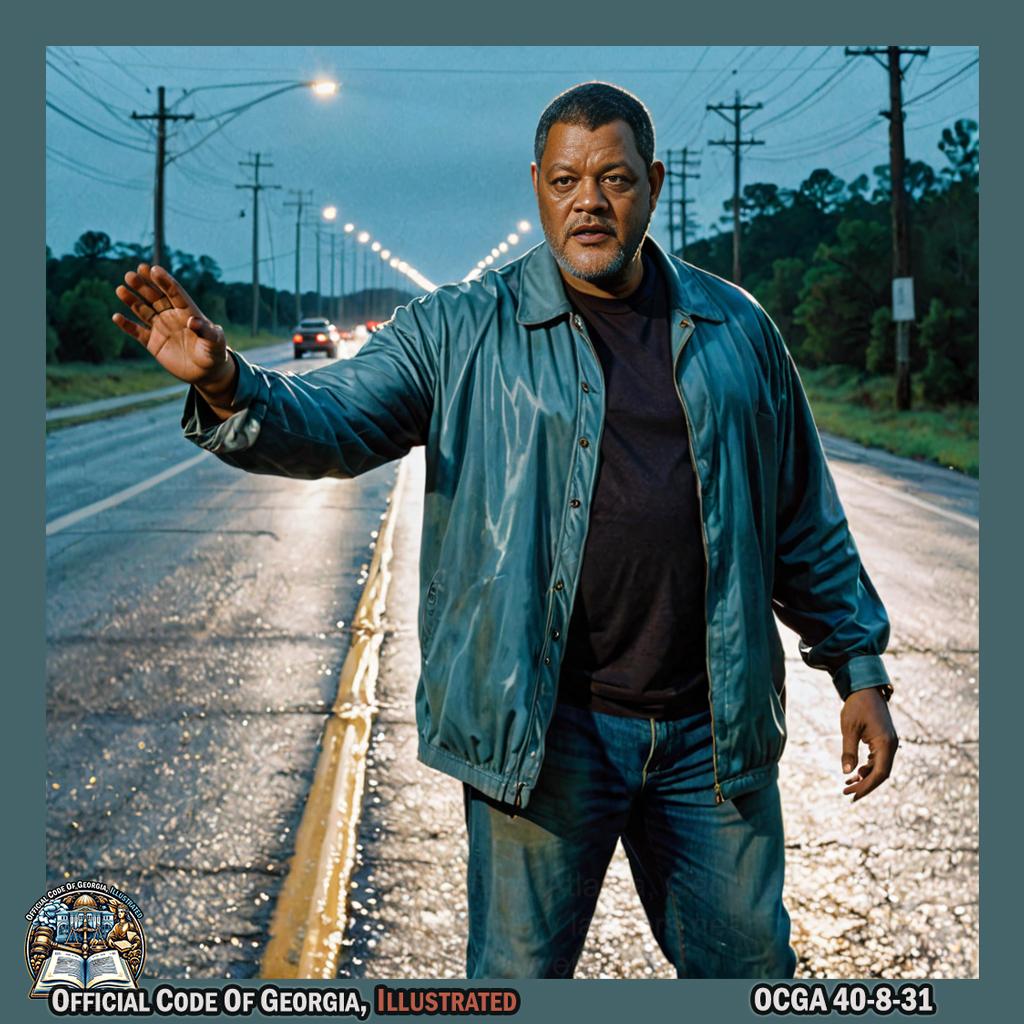
- Whenever a driver of a vehicle approaches an oncoming vehicle within 500 feet, such driver shall use a distribution of light, or composite beam, so aimed that the glaring rays are not projected into the eyes of the oncoming driver. The lowermost distribution of light, or composite beam, specified in paragraph (2) of Code Section 40-8-30 shall be deemed to avoid glare at all times, regardless of road contour and loading; and
- Whenever the driver of a vehicle follows another vehicle within 200 feet to the rear, except when engaged in the act of overtaking and passing, such driver shall use a distribution of light permissible under this chapter other than the uppermost distribution of light specified in paragraph (1) of Code Section 40-8-30.
40-8-32.Lights on vehicles of rural mail carriers.¶
Any automobile operated by a rural mail carrier for the purpose of delivering mail shall be authorized to display two amber colored lights so as to warn approaching travelers to decrease their speed because of the danger of colliding with such mail carrier as he stops and starts along the edge of the highway. Such amber lights should be visible under normal atmospheric conditions from a distance of 500 feet to the front of such vehicle.
40-8-33.Lights on farm tractors and unlicensed three-wheeled motorcycles used only for agricultural purposes; restrictions on trailers and semitrailers otherwise exempt under Code Section 40-8-1; no duty on manufacturers of lighting systems.¶
- Every farm tractor and every three-wheeled motorcycle used only for agricultural purposes equipped with an electric lighting system shall at all times mentioned in Code Section 40-8-20 display a red taillight and either multiple-beam or single-beam road lighting equipment meeting the requirements of Code Sections 40-8-23 and 40-8-30, respectively.
- When operated or towed upon a highway, roadway, or street at any time from a half-hour after sunset to a half-hour before sunrise and at any time when it is raining in the driving zone and at any other time when there is not sufficient visibility to render clearly discernible persons and vehicles on the highway, roadway, or street at a distance of 500 feet to the rear, every trailer and semitrailer which would otherwise be exempt from this article as an implement of husbandry under Code Section 40-8-1 either shall comply with Code Section 40-8-23, relating to taillights, or shall be equipped with an operating red flashing light which is plainly visible from a distance of 500 feet to the rear and which is either permanently or temporarily fixed to the rear of such trailer or semitrailer or shall be accompanied by an escort vehicle which is equipped with one or more operating red or amber flashing lights that are visible from a distance of 500 feet and which shall follow such trailer or semitrailer.
- Nothing in this Code section shall be construed to impose a duty on a manufacturer of an implement of husbandry under Code Section 40-8-1 to install an electric lighting system, taillights, or red flashing lights or otherwise equip implements of husbandry to be in compliance with the provisions of this Code section at the time of manufacture or sale; it being the intent of this Code section to place a duty on operators of the equipment only under specified circumstances and conditions, and not on manufacturers.
40-8-34.Color in lighting equipment.¶
The color in all lighting equipment covered in this title shall be in accordance with Society of Automotive Engineers (SAE) Standard J578, April, 1965, as thereafter revised or amended.
40-8-35.Operating low-speed vehicles on highway.¶
Any low-speed vehicle operated on the highways of this state without a properly affixed emblem conforming to the requirements of Code Section 40-8-4 shall display an amber strobe light so as to warn approaching travelers to decrease their speed because of the danger of colliding with such vehicle. Such amber strobe light shall be mounted in a manner so as to be visible under normal atmospheric conditions from a distance of 500 feet from the front and rear of such vehicle.
PART 3 Brakes¶
- 40-8-50. Brakes required.
- 40-8-51. Means of operation.
- 40-8-52. Parking brakes.
- 40-8-53. Performance ability of brakes.
- 40-8-54. Maintenance.
40-8-50.Brakes required.¶
-
As used in this Code section, the term:
- “Gross combination weight rating (GCWR)” means the combined gross vehicle weight ratings of all vehicles in a combination of vehicles.
- “Gross vehicle weight rating (GVWR)” means the value specified by the manufacturer or manufacturers as the maximum loaded weight of a single or a combination (articulated) vehicle, the actual gross weight, or registered gross weight, whichever is greater.
-
“Hazardous material” has the meaning provided by Chapter 51 of Title 49 of the United States Code Annotated.

Gale Harold silently opening a large book and dramatically pointing to a specific passage, then slowly crumbling the pages as if they were decaying materials, while surrounded by suspended translucent fabric in an abandoned warehouse in Buford. -@GaleHaroldIII -
“Surge brakes” means a self-contained, permanently closed hydraulic brake system for trailers that relies on inertial forces, developed in response to the braking action of the towing vehicle, applied to a hydraulic device mounted on or connected to the tongue of the trailer to slow down or stop the towed vehicle.
-
Every motor vehicle, other than a motorcycle or motor driven cycle, when operated upon a highway shall be equipped with brakes adequate to control the movement of and to stop and hold such vehicle, including two separate means of applying the brakes, each of which means shall be effective to apply the brakes to at least two wheels. If these two separate means of applying the brakes are connected in any way, they shall be so constructed that failure on any one part of the operating mechanism shall not leave the motor vehicle without brakes on at least two wheels.
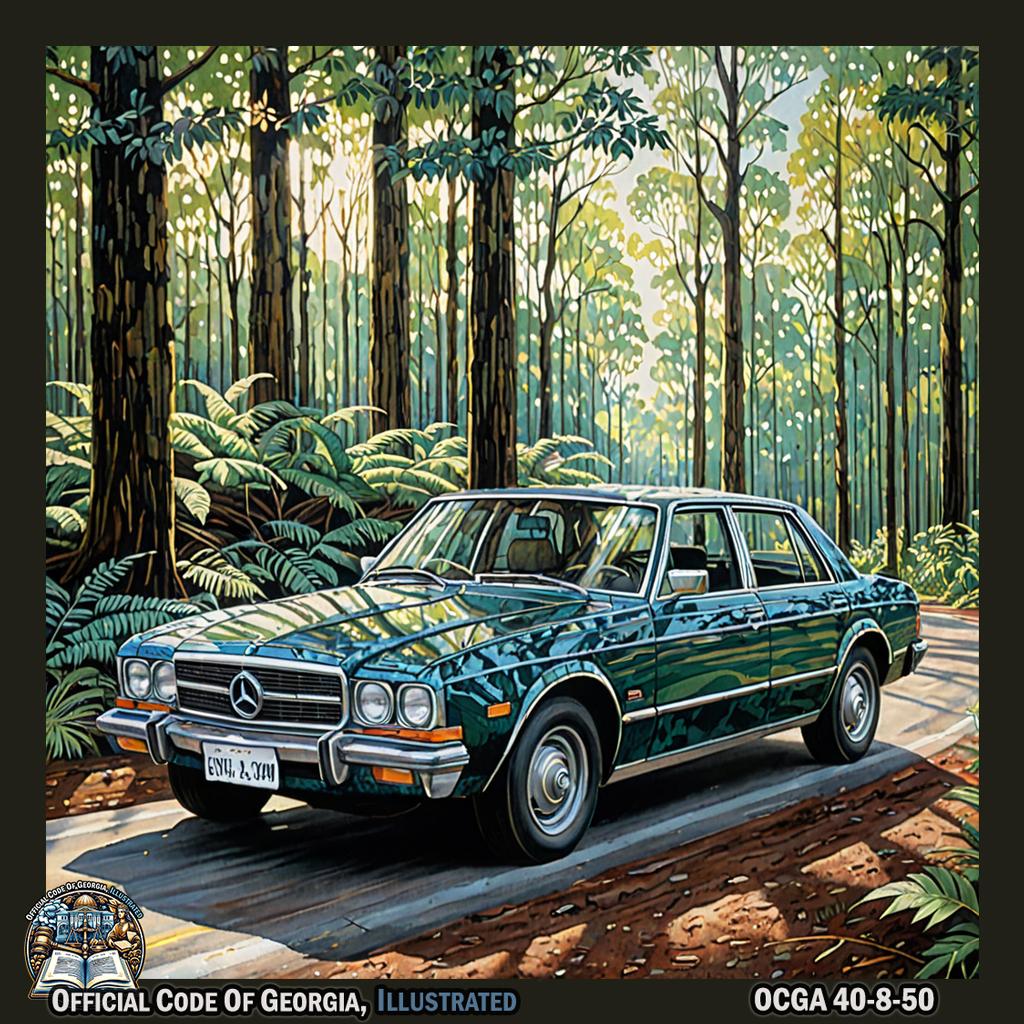
Cox Automotive, in the style of Joshua Yeldham, uses graceful and fluid movements to symbolize the interconnectedness of brake systems on a car, with sweeping gestures and intricate footwork as they mimic the operation of brakes on at least two wheels. The scene is set against the backdrop of a lush forest in Griffin, with dappled sunlight filtering through the trees. -@CoxAutomotive -
Every motorcycle and motor driven cycle manufactured after January 1, 1974, when operated upon a highway, shall be equipped with at least two brakes which may be operated by hand or foot.
- Except as otherwise provided in subsection (e) of this Code section, every trailer or semitrailer of 3,000 pounds gross weight or more shall be equipped with brakes on all wheels. Any farm trailer with two or more wheels, pulled from a tongue, used in or operated for farm purposes, including transporting fertilizer and agricultural materials to the farm, shall not be required to have an independent braking system thereon, provided such farm trailer shall not weigh over 4,000 pounds when empty.
-
Any trailer or semitrailer may utilize surge brakes, subject to the following conditions and limitations:
- The gross vehicle weight rating or the actual gross weight of any surge brake equipped trailer or semitrailer does not exceed 20,000 pounds;
- For trailers and semitrailers with a gross vehicle weight rating of 12,000 pounds or less, the gross vehicle weight rating of any such trailer shall not exceed 1.75 times the gross vehicle weight rating of the towing vehicle;
- For trailers and semitrailers with a gross vehicle weight rating greater than 12,000 pounds, but less than 20,001 pounds, the gross vehicle weight rating of any such trailer shall not exceed 1.25 times the gross vehicle weight rating of the towing vehicle;
-
The actual gross weight of the trailer or semitrailer and load does not exceed the manufacturer’s gross vehicle weight rating;
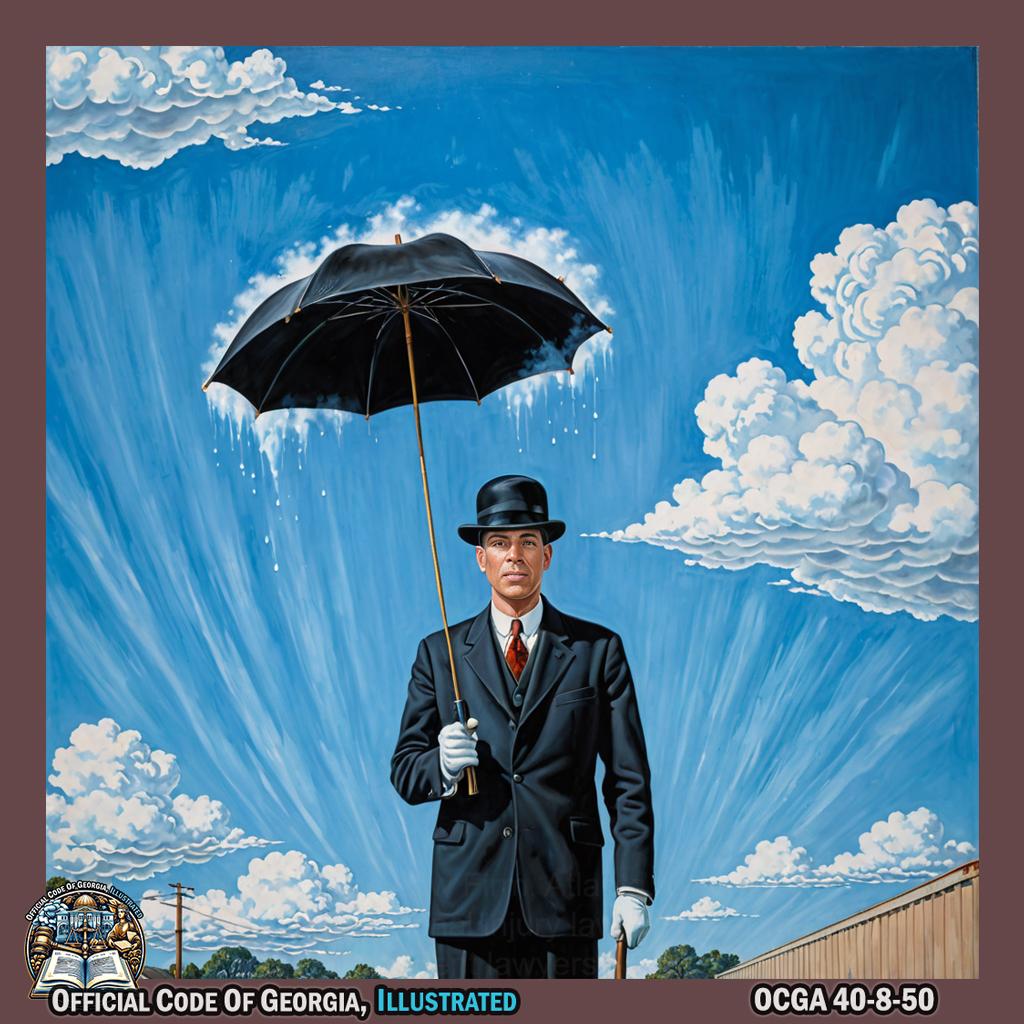
James Nabrit Jr. stands in a surreal landscape of Powder Springs, delicately balancing an oversized trailer on his fingertip while wearing a bowler hat and holding a floating umbrella, all against the backdrop of a clear blue sky with fluffy white clouds. -
The trailer or semitrailer brakes must be designed and connected in such a manner that in case of accidental breakaway of the towed vehicle the brakes shall apply automatically; and
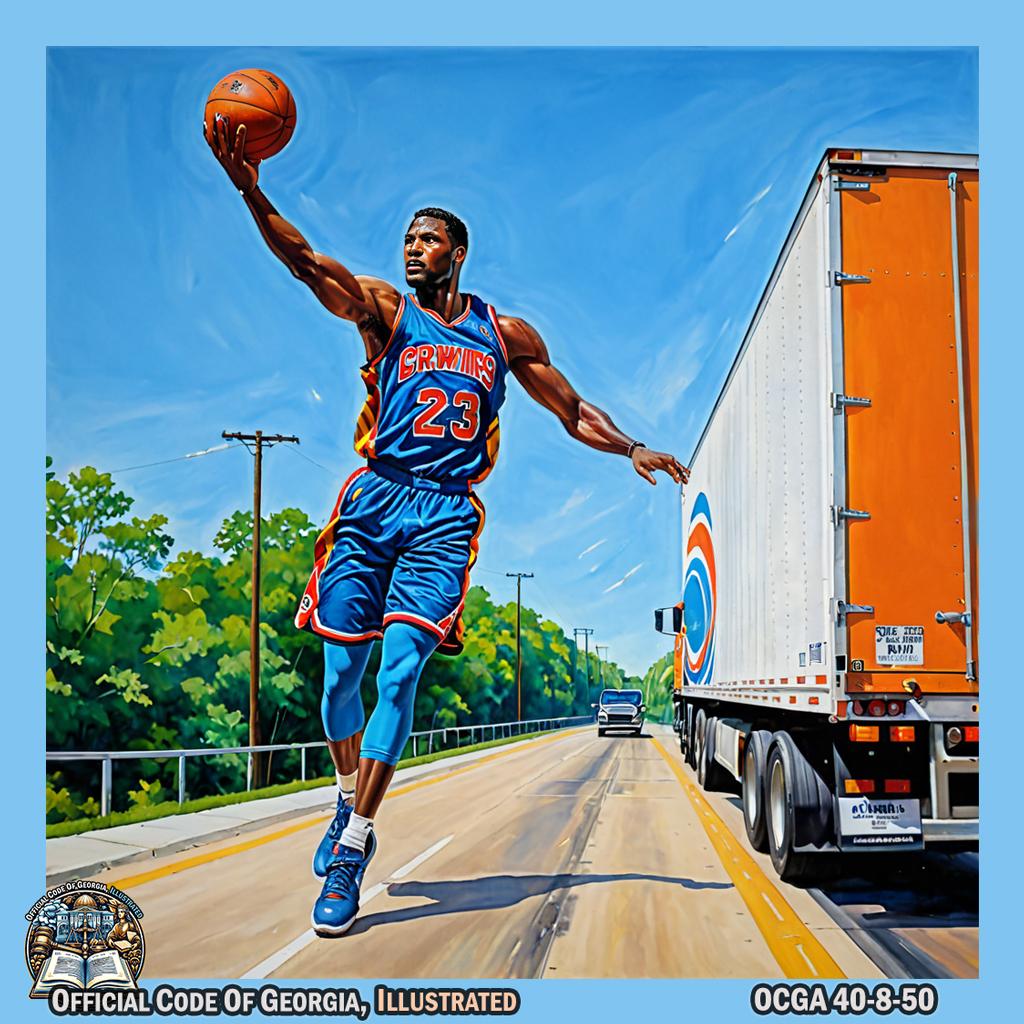
Basketball player Bernard James gracefully simulates the automatic application of brakes on a semitrailer by elegantly pivoting and halting his movement with precision, all while showcasing an artful display reminiscent of Michelangelo's "The Creation of Adam," set against the vibrant backdrop of Carowinds. -@BernardJame5 -
For vehicles used for commercial purposes, the vehicle or combination of vehicles complies in all other respects with licensing, insurance, registration, identification, driver and vehicle safety, and hazardous materials regulations of the Department of Public Safety and United States Department of Transportation applicable to such vehicles or combination of vehicles.
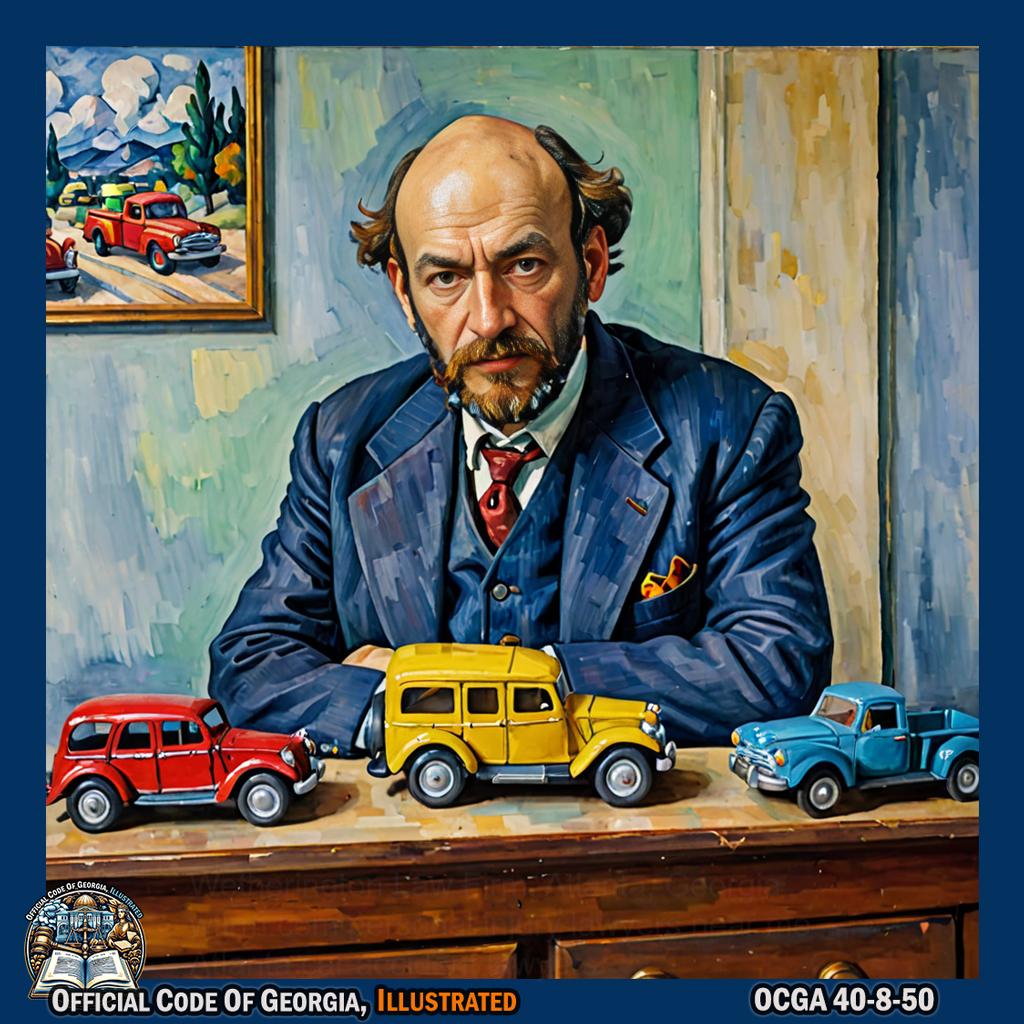
A person dressed as Moe from Moe’s Southwest Grill meticulously arranges miniature trucks and cars in a still life composition, ensuring they comply with various regulations. This is done in the style of an art piece by Paul Cézanne at the Gertrude Herbert Institute of Art. -@Moes_HQ
-
Where there is no manufacturer’s gross vehicle weight rating or the manufacturer’s gross vehicle weight rating is exceeded in violation of paragraph (4) of subsection (e) of this Code section, then the actual gross weight of the trailer or semitrailer shall be used to determine compliance with paragraphs (2) and (3) of subsection (e) of this Code section.
40-8-51.Means of operation.¶
- One of the means of brake operation shall consist of a mechanical connection from the operating lever to the brake shoes or bands, and this brake shall be capable of holding the vehicle or combination of vehicles stationary under any condition of loading on any upgrade or downgrade upon which it is operated.
- The brake shoes operating within or upon the drums on the vehicle wheels of any motor vehicle may be used for both service and hand operation.
40-8-52.Parking brakes.¶
Every 1966 model motor vehicle and all subsequent model motor vehicles shall be equipped with parking brakes adequate to hold the vehicle on any grade on which it is operated, under all conditions of loading, on a surface free from snow, ice, or loose material. The parking brakes shall be capable of being applied in conformance with the foregoing requirements by the driver’s muscular effort or by spring action or by equivalent means. Their operation may be assisted by the service brakes or other source of power, provided that failure of the service brake actuation system or other power assisting mechanism will not prevent the parking brakes from being applied in conformance with the foregoing requirements. The parking brakes shall be so designed that when once applied they shall remain applied with the required effectiveness despite exhaustion of any source of energy or leakage of any kind. The same brake drums, brake shoes and lining assemblies, brake shoe anchors, and mechanical brake shoe actuation mechanism normally associated with the wheel brake assemblies may be used for both the service brakes and the parking brakes. If the means of applying the parking brakes and the service brakes are connected in any way, they shall be so constructed that failure of any one part shall not leave the vehicle without operative brakes.

40-8-53.Performance ability of brakes.¶
-
Except as provided for in subsection (b) of this Code section, every motor vehicle or combination of motor drawn vehicles shall be capable at all times and under all conditions of loading of being stopped on a dry, smooth, level road free from loose material, upon application of the service (foot) brake within the distances specified in this Code section or shall be capable of being decelerated at a sustained rate corresponding to these distances.
Click to view
-
The brake performance ability for commercial motor vehicles shall be as provided for in the federal motor carrier safety regulations contained in 49 C.F.R. 393.52 and adopted by the commissioner of public safety pursuant to Code Section 40-1-8. Commercial motor vehicles shall be capable at all times and under all conditions of loading of being stopped on a dry, smooth, level road free from loose material upon application of the service (foot) brake within the distances specified in those rules.
Feet to Stop From 20 Miles Deceleration in Per Hour Feet Per Second Vehicles or 30 14 combinations ofvehicles havingbrakes on allwheels Vehicles or 40 10.7 combinations ofvehicles not havingbrakes on allwheels
40-8-54.Maintenance.¶
All brakes shall be maintained in good working order and shall be so adjusted as to operate as equally as practicable with respect to the wheels on opposite sides of the vehicle.
PART 4 Horns, Exhaust Systems, Mirrors, Windshields, Tires, Safety Belts, Energy Absorption Systems {#t40c08a01p04}

- 40-8-70. Horns and warning devices.
- 40-8-71. Exhaust system; prevention of noise, smoke, and fumes.
-
40-8-72. Mirrors.
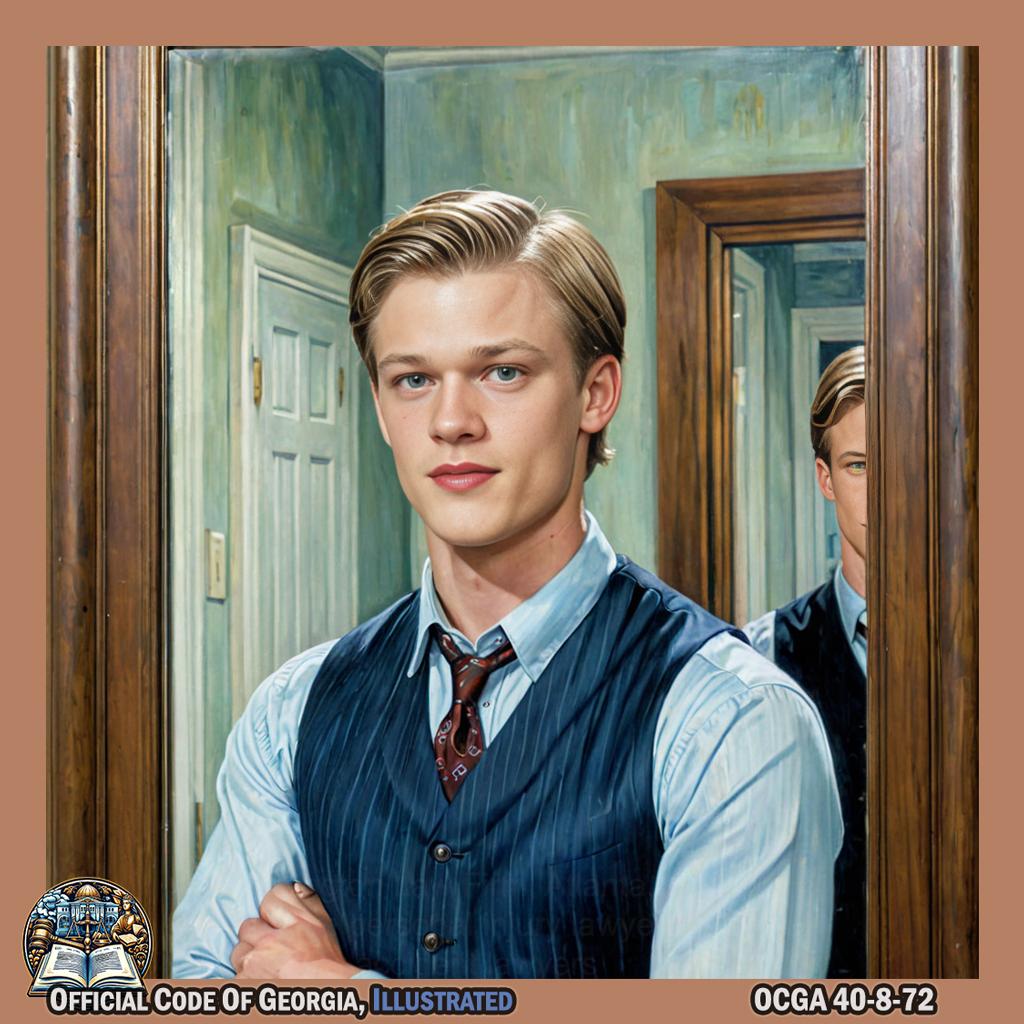
Actor Lucas Till holds up a mirror and gazes at his reflection with an exaggerated expression of surprise and delight in a rich scene in the Georgia location, Dalton. -@lucastill - 40-8-73.1. Tinting of windows or windshields.
-
40-8-74. Tires.
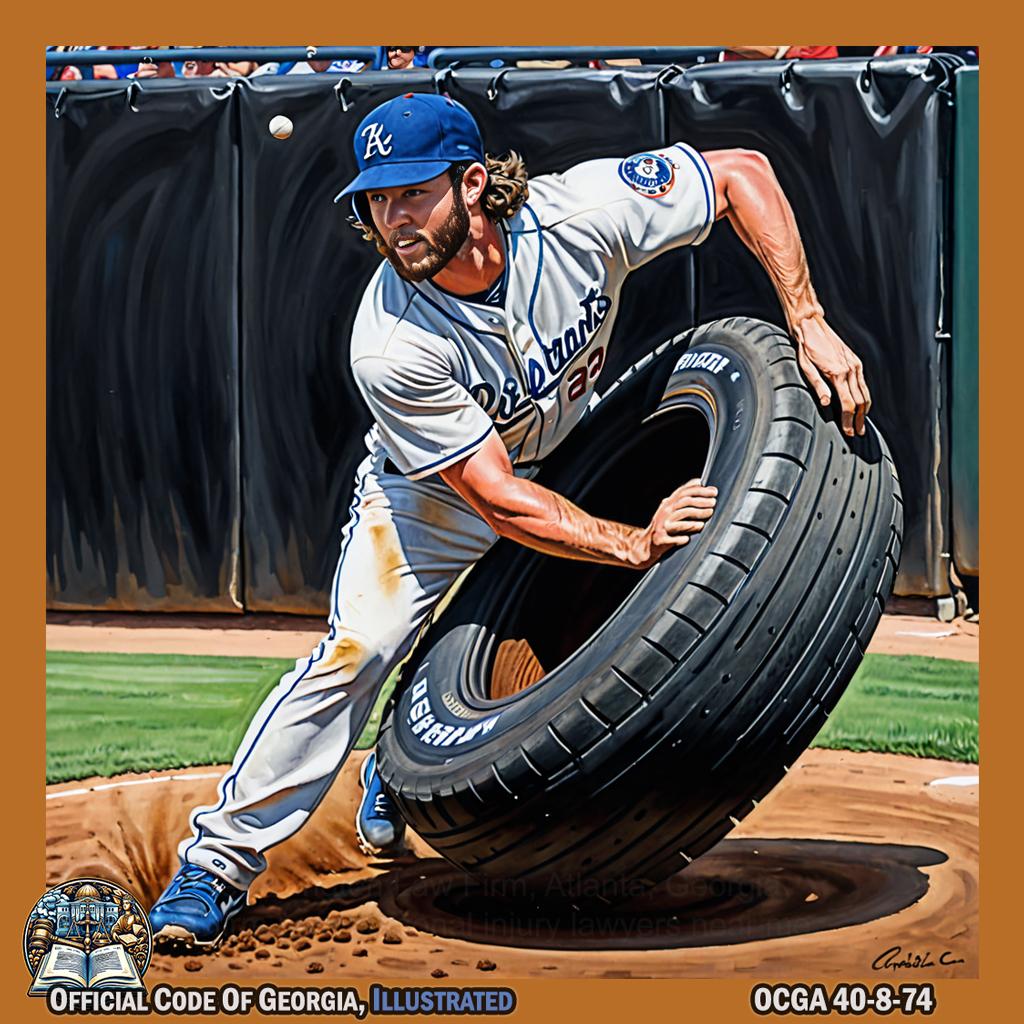
Baseball player Charlie Culberson, captured in Allyn Bromley's art piece, pretends to hold a tire and roll it forward while making a "vroom vroom" sound. -@cculberson8 - 40-8-76. Safety belts required as equipment; safety restraints for children.
- 40-8-76.1. Use of safety belts in passenger vehicles.
- 40-8-77. Energy absorption system.
-
40-8-78. Safety glazing.
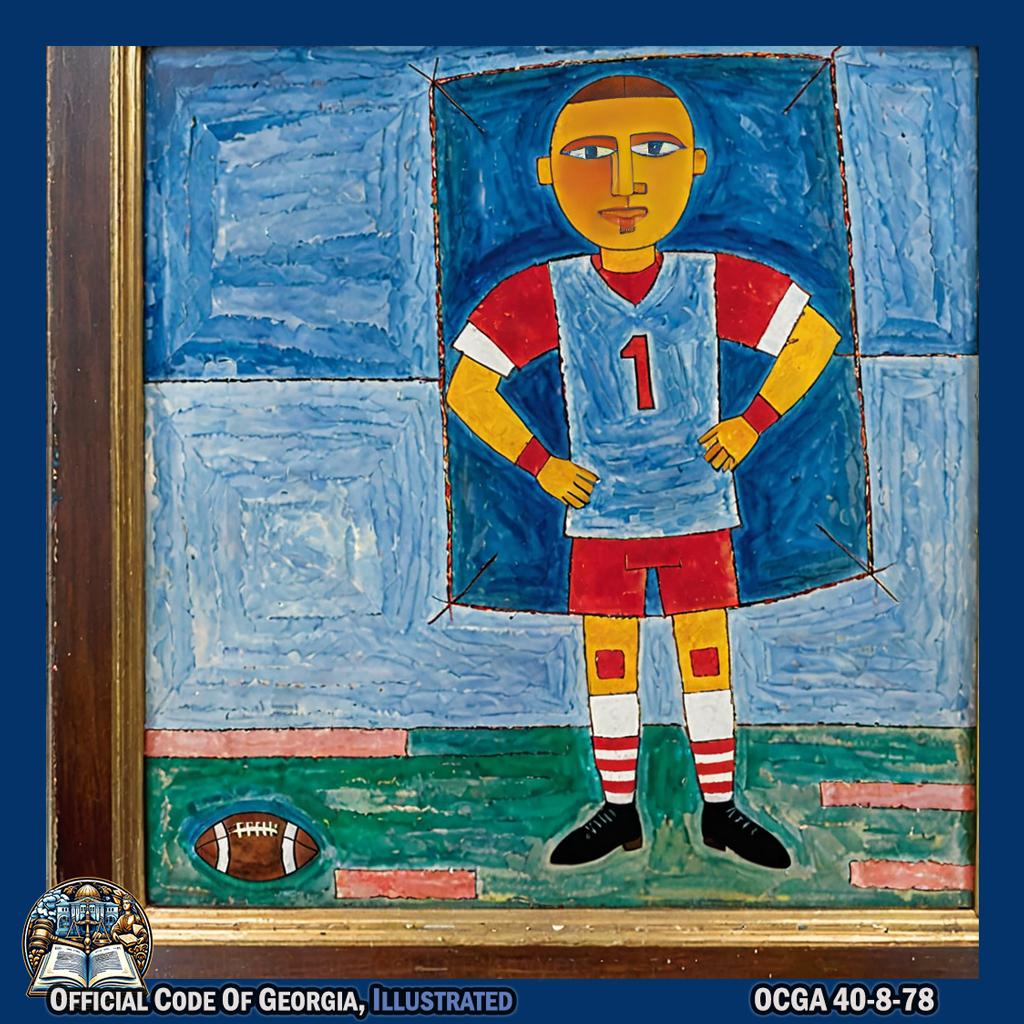
As football player Chris Scott delicately encases a picture frame in a protective shield, the scene unfolds like an art piece from Paul Klee.
40-8-70.Horns and warning devices.¶
- Every motor vehicle when operated upon a highway shall be equipped with a horn in good working order and capable of emitting sound audible under normal conditions from a distance of not less than 200 feet, but no horn or other warning device shall emit an unreasonably loud or harsh sound or a whistle. The driver of a motor vehicle shall, when it is reasonably necessary to ensure safe operation, give audible warning with his or her horn but shall not otherwise use such horn when upon a highway.
- No vehicle shall be equipped with nor shall any person use upon a vehicle any siren, whistle, or bell except as otherwise permitted in this Code section and Code Section 40-8-94.
- No vehicle shall be equipped with a theft alarm signal device which is so arranged that it can be used by the driver as an ordinary warning signal.
40-8-71.Exhaust system; prevention of noise, smoke, and fumes.¶
-
Every motor vehicle shall at all times be equipped with an exhaust system, in good working order and in constant operation, meeting the following specifications:
- The exhaust system shall include the piping leading from the flange of the exhaust manifold to and including the muffler or mufflers and tail pipes;
-
The use of flexible pipe shall be prohibited except on diesel tractors or according to manufacturers’ original specifications;

Luke Bryan, dressed as a pirate, holds up a rigid pipe and then dramatically throws it overboard from the ship set inside The Pirates House while singing "Country Girl (Shake It for Me)" in an exaggerated art piece style. -@LukeBryanOnline -
The exhaust emission point shall extend beyond the rear or outside of the passenger compartment. The trunk shall be considered as part of the passenger compartment;
- The exhaust system and its elements shall be securely fastened, including the consideration of missing or broken hangers; and
- There shall be no part of the exhaust system passing through the passenger compartment or any exposed stack so located that any individual entering or leaving the vehicle may be burned.
-
The engine and power mechanism of every motor vehicle shall be so equipped and adjusted as to prevent the escape of excessive fumes or smoke.
- It shall be unlawful for any person to sell or offer for sale any muffler which causes excessive or unusual noise or annoying smoke or any muffler cutout, bypass, or similar device for use on a motor vehicle or for any person to use, to sell, or to offer for sale any motor vehicle equipped with any such muffler, muffler cutout, bypass, or similar device. Any person violating this subsection shall be guilty of a misdemeanor.
40-8-72.Mirrors.¶
-
Except as provided in subsection (b) of this Code section, every motor vehicle which is so constructed or loaded as to obstruct the driver’s view to the rear thereof from the driver’s position shall be equipped with a mirror so located as to reflect to the driver a view of the highway for a distance of at least 200 feet to the rear of such vehicle.
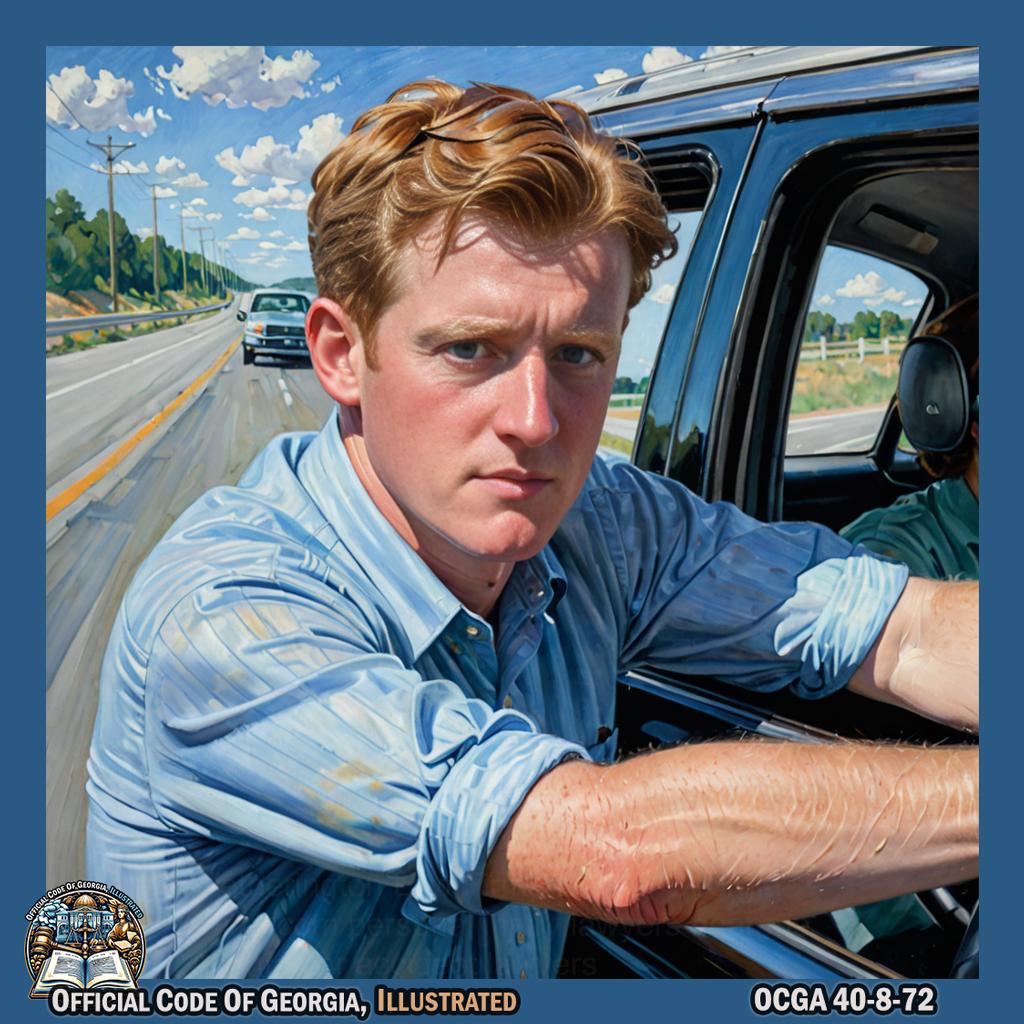
Joe Kennedy, as depicted in a Mary Cassatt-style art piece, stands next to a motor vehicle and uses his hands to mimic obstructing the view from the driver's position while gazing at a mirror reflecting the highway. -@joekennedy -
Every commercial motor vehicle shall be equipped with two rear-vision mirrors meeting the requirements of the federal motor vehicle safety standards contained in 49 C.F.R. 571.111 in effect at the time of manufacture, one at each side, firmly attached to the outside of the motor vehicle, and so located as to reflect to the driver a view of the highway to the rear, along both sides of the vehicle; provided, however, that only one outside mirror shall be required, which shall be on the driver’s side, on a commercial motor vehicle which is so constructed that the driver has a view to the rear by means of an interior mirror.
40-8-73.Windshields, windows, and windshield wipers.¶
- No person shall drive any motor vehicle with any sign, poster, or other nontransparent material upon the front windshield, side windows, or rear windows of such vehicle which obstructs the driver’s clear view of the highway or any intersecting highway; provided, however, that, except as prohibited by federal law, rules, or regulations in the operation of a commercial motor vehicle, a person may drive a motor vehicle with a mount for the support of a wireless telecommunications device or stand-alone electronic device, as such terms are defined in Code Section 40-6-241, upon the front windshield, provided that such mount is located on the windshield in a manner which minimizes obstruction of the driver’s view.
-
The windshield of every motor vehicle shall be equipped with a device for cleaning rain, snow, or other moisture therefrom, which device shall be so constructed as to be controlled or operated by the driver of the vehicle.
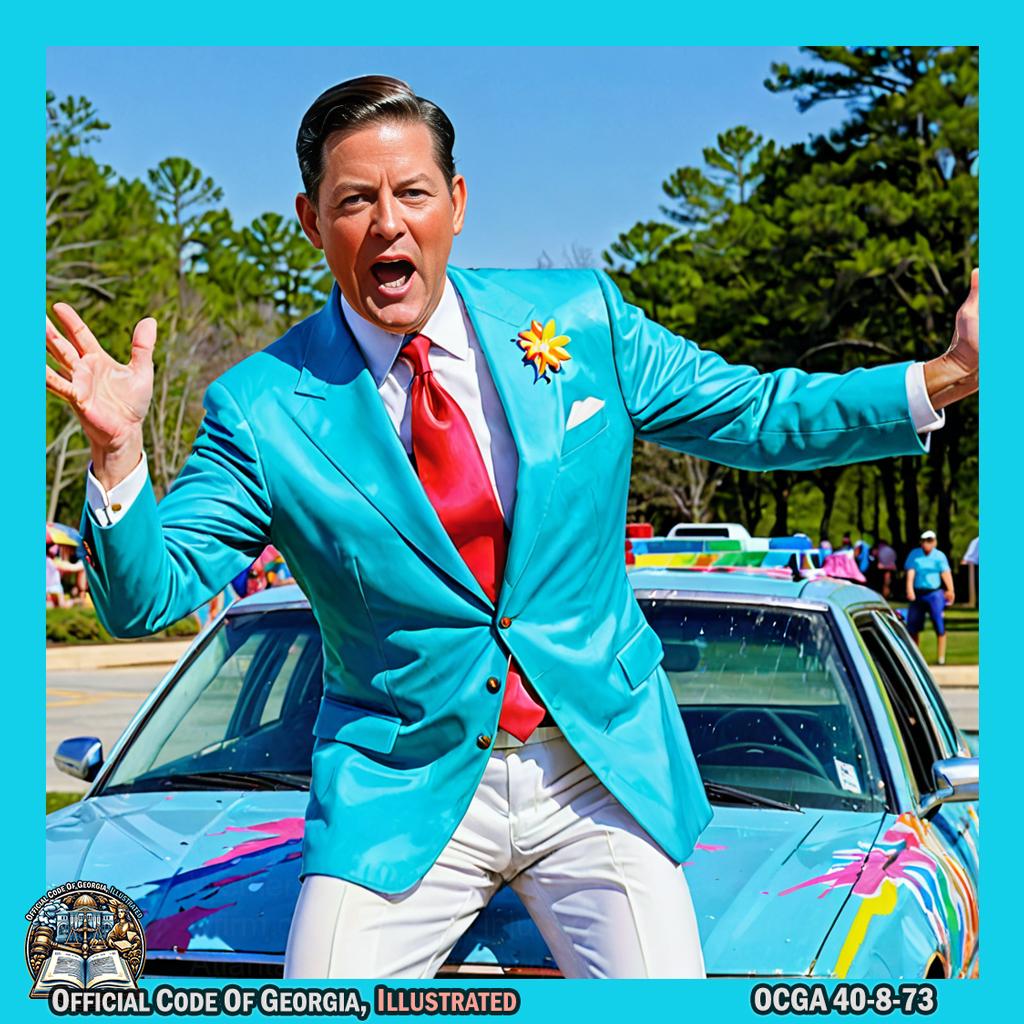
Ralph Reed, dressed in a vibrant political-themed costume, dances gracefully around a car, miming the action of operating windshield wipers with dramatic flair and expressive gestures, all within the colorful and lively setting of Spring Valley Beach Water Park. -@ralphreed -
Every windshield wiper upon a motor vehicle shall be maintained in good working order.
-
No opaque or solid material including, but not limited to, cardboard, plastic, and taped glass shall be employed in lieu of a glass windshield or window.
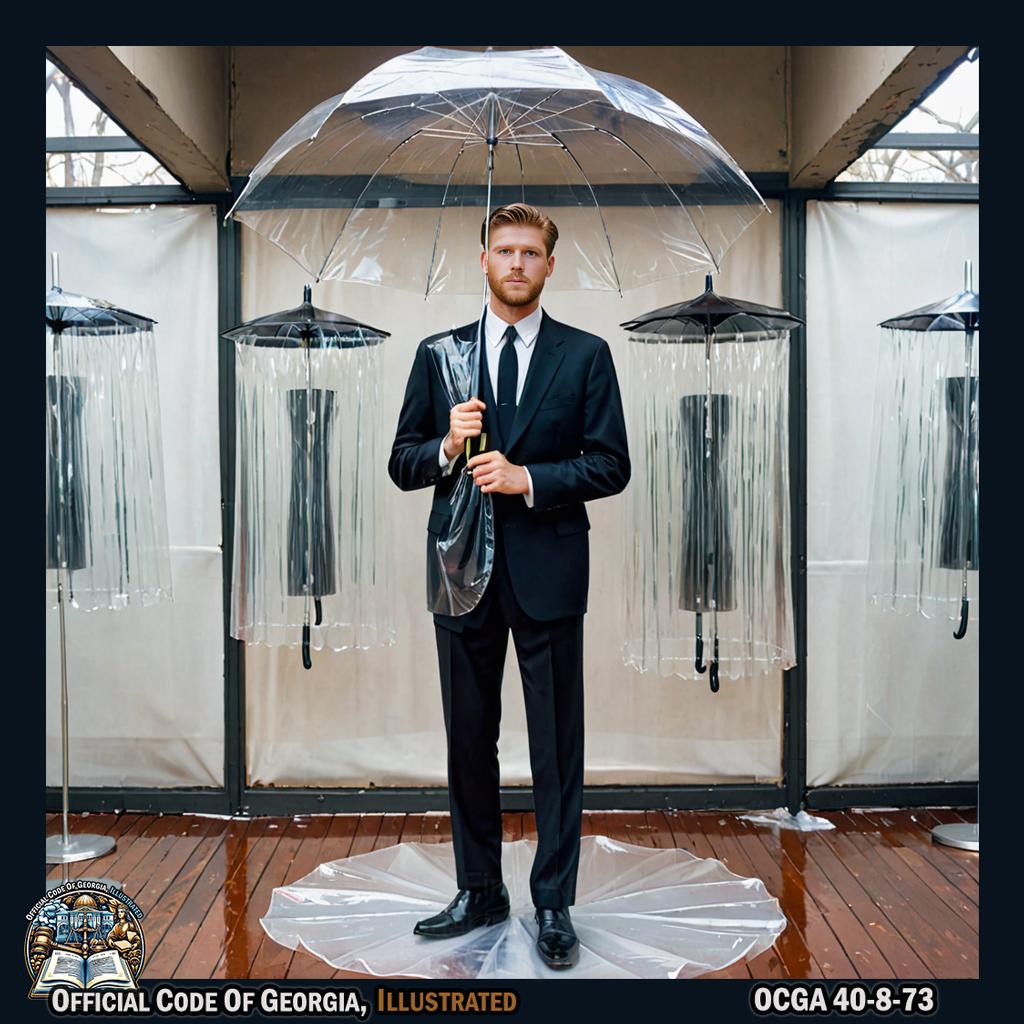
Hunter Strickland gracefully holding a transparent umbrella, surrounded by suspended clear plastic sheets in an avant-garde display reminiscent of Guy Bourdin's style, embodying the prohibition of opaque or solid materials as per the specified sentence. -@hstrickland60 -
No motor vehicle shall be operated with a windshield or rear window having a starburst or spider webbing effect greater than three inches by three inches.
40-8-73.1.Tinting of windows or windshields.¶
-
As used in this Code section, the term:
- “Light reflectance” means the ratio of the amount of total light that is reflected outward by a product or material to the amount of total light falling on the product or material.
- “Light transmission” means the ratio of the amount of total light, expressed in percentages, which is allowed to pass through a surface to the amount of light falling on the surface.
- “Manufacturer” means a person who produces or assembles a vehicle glass-coating material or who fabricates, laminates, or tempers a safety-glazing material, which material reduces light transmission.
- “Material” means any transparent product or substance which reduces light transmission.
- “Multipurpose passenger vehicle” means a motor vehicle designed to carry ten persons or less which is constructed on a truck chassis or with special features for occasional off-road operation.
-
Except as provided in this Code section, it shall be unlawful for any person to operate a motor vehicle in this state:

Victoria Monét gracefully dancing with flowing movements, embodying the essence of a motor vehicle in Union City, Georgia. -@VictoriaMonet - Which has material and glazing applied or affixed to the front windshield, which material and glazing when so applied or affixed reduce light transmission through the windshield; or
- Which has material and glazing applied or affixed to the rear windshield or the side or door windows, which material and glazing when so applied or affixed reduce light transmission through the windshield or window to less than 32 percent, plus or minus 3 percent, or increase light reflectance to more than 20 percent.
-
The provisions of subsection (b) of this Code section shall not apply to:
- Adjustable sun visors which are mounted forward of the side windows and are not attached to the glass;
- Signs, stickers, or other matter which is displayed in a seven-inch square in the lower corner of the windshield farthest removed from the driver or signs, stickers, or other matter which is displayed in a five-inch square in the lower corner of the windshield nearest the driver;
- Direction, destination, or termination signs upon a passenger common carrier motor vehicle if the signs do not interfere with the driver’s clear view of approaching traffic;
- Any transparent item which is not red or amber in color which is placed on the uppermost six inches of the windshield;
- Any federal, state, or local sticker or certificate which is required by law to be placed on any windshield or window;
-
The rear windshield or the side or door windows, except those windows to the right and left of the driver of:
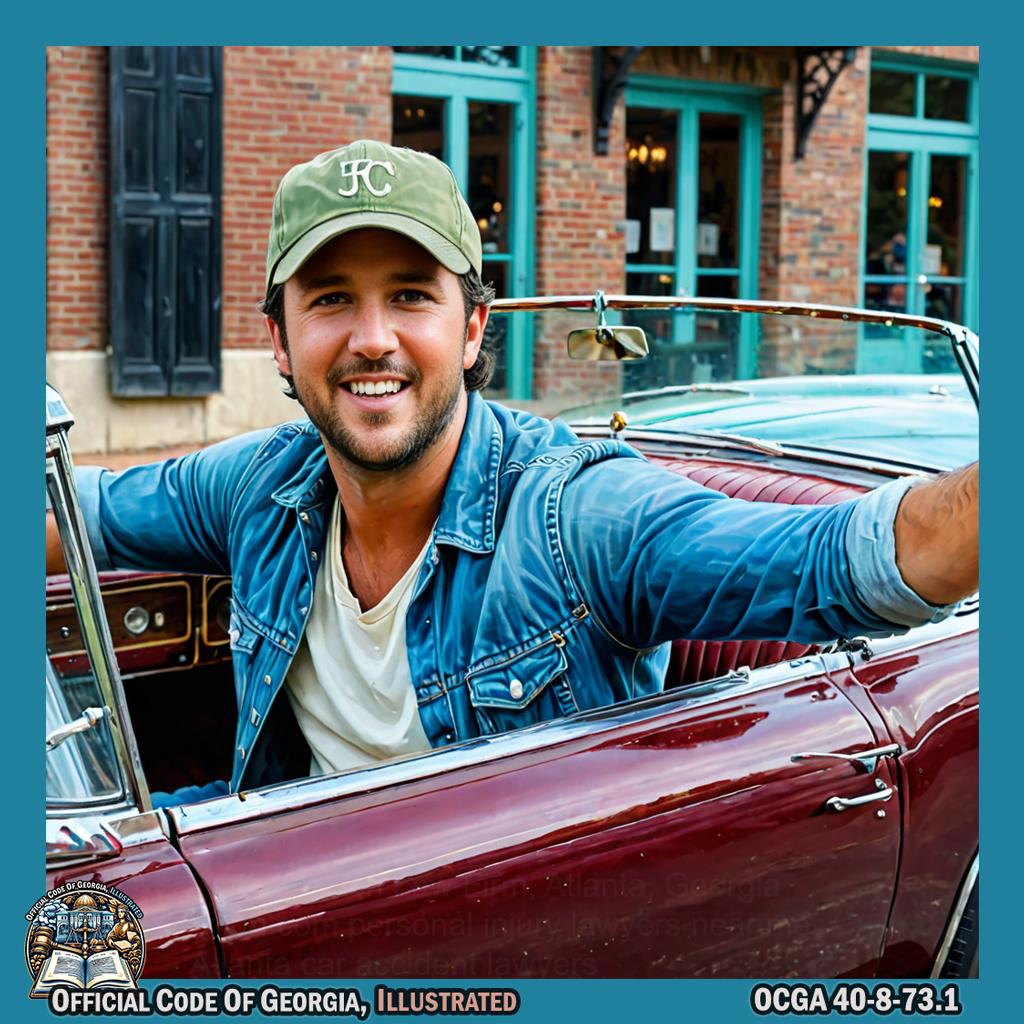
Luke Bryan sits in a vintage car, gesturing at the rear windshield and side windows while swaying to the music, capturing the essence of a lively art piece from the Renaissance era in Brunswick. -@LukeBryanOnline -
A multipurpose passenger vehicle;

Nancy Hart, depicted by Donray, makes steering wheel movements and pretends to press pedals while driving a car in an art piece. -
A school bus, any other bus used for public transportation, and any bus or van owned or leased by any religious or any nonprofit organization duly incorporated under the laws of this state;
- Any limousine owned or leased by a public or private entity; or
- Any other vehicle, the windows or windshields of which have been tinted or darkened before factory delivery or permitted by federal law or regulation;
- Any law enforcement vehicle;
- Any vehicle that displays a valid special license plate issued to a government official under Code Section 40-2-61, 40-2-63, or 40-2-64;
- Any vehicle owned or operated by the state or a political subdivision thereof and that displays a valid license plate issued pursuant to Code Section 40-2-37; or
- Any vehicle operated in the course of business by a person licensed or registered under Chapter 38 of Title 43, relating to private detective and private security businesses.
-
-
The Department of Public Safety may, upon application from a person required for medical reasons to be shielded from the direct rays of the sun and only if such application is supported by written attestation of such fact from a person licensed to practice medicine under Chapter 34 of Title 43 or a person certified as an optometrist under Chapter 30 of Title 43, issue an exemption from the provisions of this Code section for any motor vehicle owned by such person or in which such person is a habitual passenger. The exemption shall be issued with such conditions and limitations as may be prescribed by the Department of Public Safety.
- No person shall install any material upon the windshields or windows of any motor vehicle, the installation of which would result in a reduction of light transmission or an increase in light reflectance in violation of subsection (b) of this Code section.
- Notwithstanding any other provision of this Code section, commercial motor vehicles operated in this state are subject to the specifications of or limitations relating to windshield or window glazing or the application of light reducing or reflectance material to the windshield or windows as provided for in the federal motor carrier safety regulations contained in 49 C.F.R. 393.60 and adopted by the commissioner of public safety pursuant to Code Section 40-1-8.
- The Department of Public Safety is authorized to promulgate such rules and regulations as may be necessary to carry out the provisions of this Code section.
- Any person who violates subsection (b) or (e) of this Code section shall be guilty of a misdemeanor.
40-8-74.Tires.¶
-
No vehicle equipped with solid rubber tires shall be used or transported on the highways, unless every solid rubber tire on such vehicle shall have rubber on its entire traction surface at least one inch thick above the edge of the flange on the entire periphery.

Morgan Saylor, wearing a vibrant polka-dotted outfit, stands in a lush field in Milton, Georgia. She playfully stacks large rubber tires upon each other, meticulously covering every inch of their traction surfaces with thick layers of bright red and yellow rubber paint, transforming the tires into colorful sculptures that reflect Yayoi Kusama's signature style. -@Morgan_Saylor -
No person shall operate or move on any highway any motor vehicle, trailer, or semitrailer having any metal tire in contact with the roadway.

Brandon Stanton floats gracefully in the air above The Zoo, holding a metal tire aloft as if releasing it from contact with the ground, surrounded by whimsical animals and colorful sculptures reminiscent of Marc Chagall's art. -@humansofny -
No tire on a vehicle moved on a highway shall have on its periphery any block, stud, flange, cleat, or spike or any other protuberance of any material other than rubber which projects beyond the tread of the traction surface of the tire, except that it shall be permissible to use:
-
Farm machinery with tires having protuberances which will not injure the highway; and
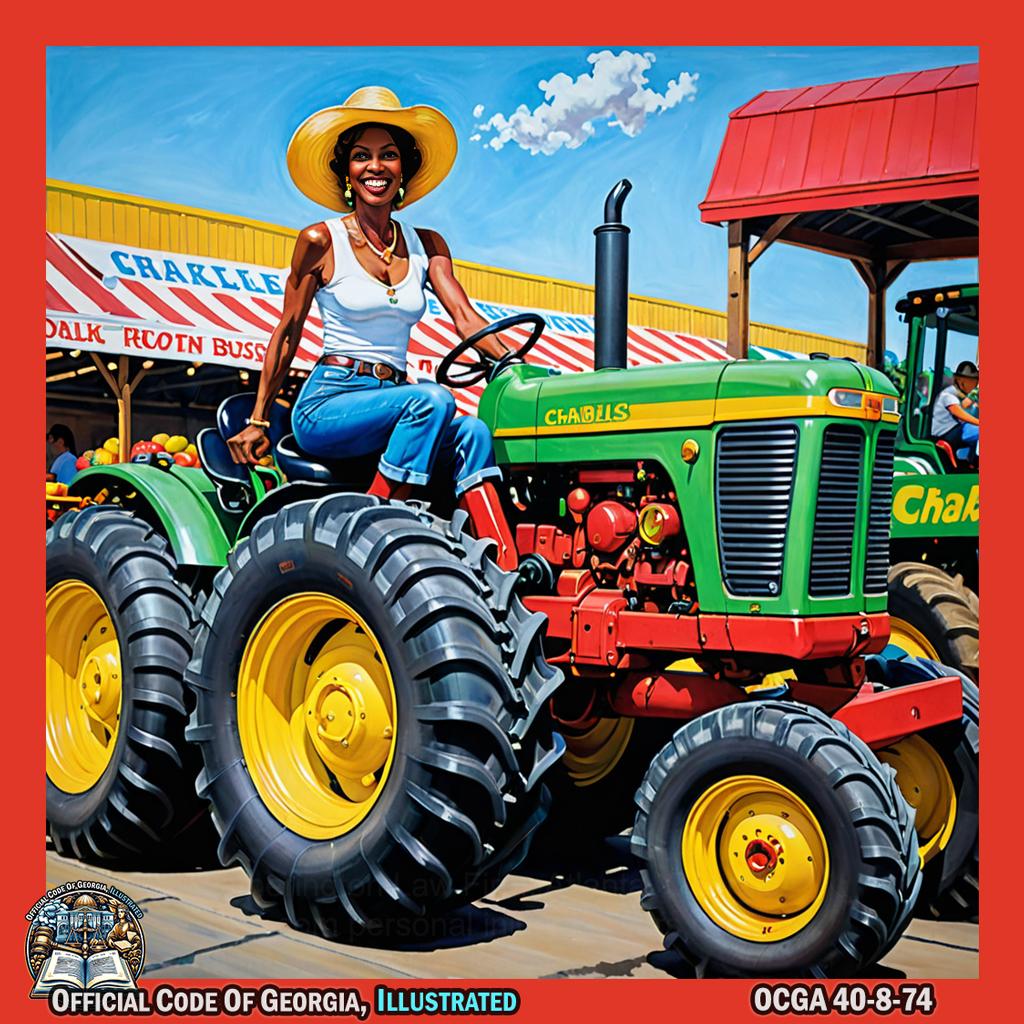
The Lady Chablis gracefully maneuvers a giant, brightly colored tractor with oversized, whimsical tires through the bustling Dekalb Farmer's Market, exuding an air of confidence and charm as she playfully avoids damaging the pristine highway beneath her. -
Tire chains of reasonable proportions or tires equipped with safety metal spike studs upon any vehicle when required for safety because of snow, ice, or other conditions tending to cause a vehicle to skid.
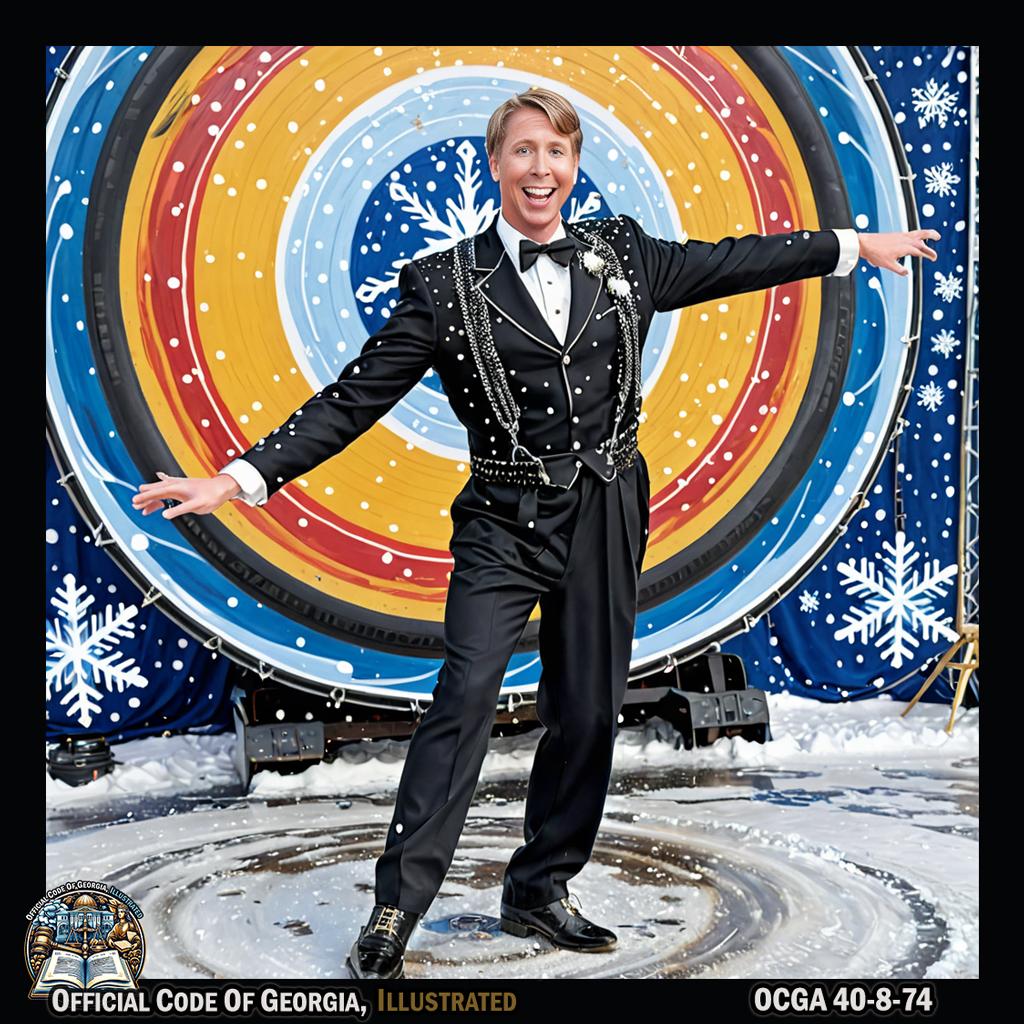
Jack McBrayer gracefully twirls and weaves across the stage, embodying the installation art piece "Winter Safety Symphony," carefully attaching tire chains to a vintage car while wearing a dazzling array of safety metal spike studs on his costume, set against a backdrop of swirling snowflakes and icy landscapes in Decatur.
-
-
The transportation board and local authorities in their respective jurisdictions may in their discretion issue special permits authorizing the operation upon a highway of traction engines or tractors having movable tracks with transverse corrugations upon the periphery of such movable tracks, or of farm tractors or other farm machinery, the operation of which upon a highway would otherwise be prohibited under this Code section.
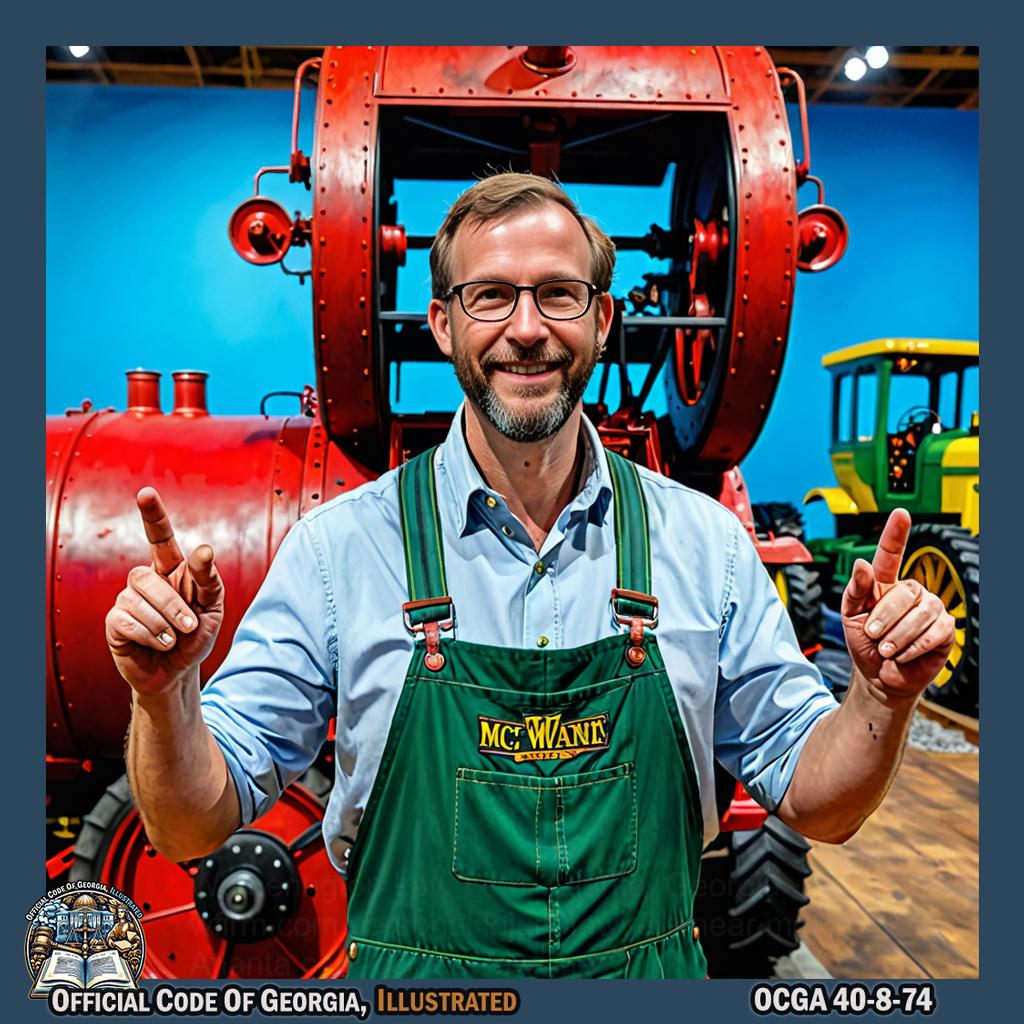
Entrepreneur Ben Chestnut uses exaggerated hand gestures to mimic the movement of traction engines and tractors with movable tracks, while surrounding himself with oversized farm machinery sculptures in a vibrant art installation at McWane Science Center. -@benchestnut -
All tires:
- Shall have not less than 2/32 inch tread measurable in all major grooves except that school buses and commercial vehicles shall have not less than 4/32 inch tread measurable in all major grooves on the front tires and school buses shall have not less than 4/32 inch tread measurable in all major grooves on the rear tires when there are only two tires on the rear; such measurements shall not be made where tie bars, humps, or fillets are located;
- Shall be free from any cuts, breaks, or snags on tread and sidewall deep enough to expose body cord; and
- Shall be free from bumps, bulges, or separations.
-
No motor vehicle shall be operated on a public street or highway with tires that have been marked “not for highway use,” “for racing purposes only,” or “unsafe for highway use.”
- Retreaded, regrooved, or recapped tires shall not be used upon the front wheels of buses.
40-8-75.Tire covers.¶
Every bus, truck, full trailer, semitrailer, and pole trailer, with the exception of local haul pulpwood trucks and local haul waste collection dumping trailers, shall be equipped with suitable metal protectors or substantial flexible flaps on the rearmost wheels to prevent, as far as practicable, such wheels from throwing dirt, gravel, rocks, water, or other materials on the windshields of following vehicles. Such protectors or flaps shall have a ground clearance of not more than one-half of the distance from the center of the rearmost axle to the center of the protector or flap under any conditions of loading of the vehicle and shall be at least as wide as the tires they are covering; provided, however, that if any such bus, truck, full trailer, semitrailer, or pole trailer is so designed and constructed that the foregoing requirements are accomplished by means of fenders, body construction, or other enclosures, then the protectors or flaps provided for in this Code section shall not be required.
40-8-76.Safety belts required as equipment; safety restraints for children.¶
- No new private passenger automobile manufactured after January 1, 1964, shall be sold to the general public in this state unless such automobile shall be equipped with two sets of safety belts for the front seat thereof. The safety belts may be installed by the manufacturer prior to delivery to the dealer, or they may be installed by the dealer.
-
- Every driver who transports a child under eight years of age in a passenger automobile, van, or pickup truck, other than a taxicab as defined by Code Section 33-34-5.1 or a public transit vehicle as defined by Code Section 16-5-20, shall, while such motor vehicle is in motion and operated on a public road, street, or highway of this state, provide for the proper restraint of such child in a child passenger restraining system appropriate for such child’s height and weight and approved by the United States Department of Transportation under provisions of Federal Motor Vehicle Safety Standard 213 in effect on January 1, 1983, or at the time of manufacture, subject to the following specific requirements and exceptions: 1. Any such child weighing at least 40 pounds may be secured by a lap belt when: 1. The vehicle is not equipped with both lap and shoulder belts; or 2. Not including the driver’s seat, the vehicle is equipped with one or more lap and shoulder belts that are all being used to properly restrain other children; 2. Any such child shall be properly restrained in a rear seat of the motor vehicle consistent with the requirements of this paragraph. If the vehicle has no rear seating position appropriate for correctly restraining a child or all appropriate rear seating positions are occupied by other children, any such child may be properly restrained in a front seat consistent with the requirements of this paragraph; 3. A driver shall not be deemed to be complying with the provisions of this paragraph unless any child passenger restraining system required by this paragraph is installed and being used in accordance with the manufacturer’s directions for such system; and 4. The provisions of this paragraph shall not apply when the child’s parent or guardian either obtains a physician’s written statement that a physical or medical condition of the child prevents placing or restraining him or her in the manner required by this paragraph. If the parent or guardian can show the child’s height is over 4 feet and 9 inches, such child shall be restrained in a safety belt as required in Code Section 40-8-76.1.
- Upon a first conviction of an offense under this subsection, the defendant shall be punished by a fine of not more than $50.00, except in the case of a child who is six or seven years of age, if the defendant shows to the court having jurisdiction of the case that a child passenger restraining system meeting the applicable requirements of this subsection has been purchased by him or her after the time of the offense and prior to the court appearance, the court may waive or suspend the fine for such first conviction. This exception shall apply until January 1, 2012. Upon a second or subsequent conviction of an offense under this subsection, the defendant shall be punished by a fine of not more than $100.00. No court shall impose any additional fees or surcharges to a fine for such a violation. The court imposing a fine for any violation of this Code section shall forward a record of the disposition of the cases to the Department of Driver Services for the sole purpose of data collection on a county by county basis.
-
Violation of this Code section shall not constitute negligence per se nor contributory negligence per se. Violation of subsection (b) of this Code section shall not be the basis for cancellation of coverage or increase in insurance rates.
- The provisions of this Code section shall not apply to buses, as defined in paragraph (7) of Code Section 40-1-1, used in the transport of children over four years of age until July 1, 2012, provided that the bus is operated by a licensed or commissioned child care facility, has a current annual transportation safety inspection certificate as required by the appropriate licensing body, and has evidence of being inspected for use by a child care facility. If the bus is not a school bus, as defined in paragraph (55) of Code Section 40-1-1, or a multifunction school activities bus, as defined in 49 C.F.R. 571.3(B), each child over four years of age and under eight years of age shall be properly restrained by a child passenger restraining system. Multifunction school activities buses, as defined in 49 C.F.R. 571.3(B), shall not be required to transport children five years of age or older in a child passenger restraining system.
40-8-76.1.Use of safety belts in passenger vehicles.¶
- As used in this Code section, the term “passenger vehicle” means every motor vehicle, including, but not limited to, pickup trucks, vans, and sport utility vehicles, designed to carry 15 passengers or fewer and used for the transportation of persons; provided, however, that such term shall not include motorcycles; motor driven cycles; or off-road vehicles or pickup trucks being used by an owner, driver, or occupant 18 years of age or older in connection with agricultural pursuits that are usual and normal to the user’s farming operation; and provided, further, that such term shall not include motor vehicles designed to carry 11 to 15 passengers which were manufactured prior to July 1, 2015, and which, as of such date, did not have manufacturer installed seat safety belts.
-
Each occupant of the front seat of a passenger vehicle shall, while such passenger vehicle is being operated on a public road, street, or highway of this state, be restrained by a seat safety belt approved under Federal Motor Vehicle Safety Standard 208.
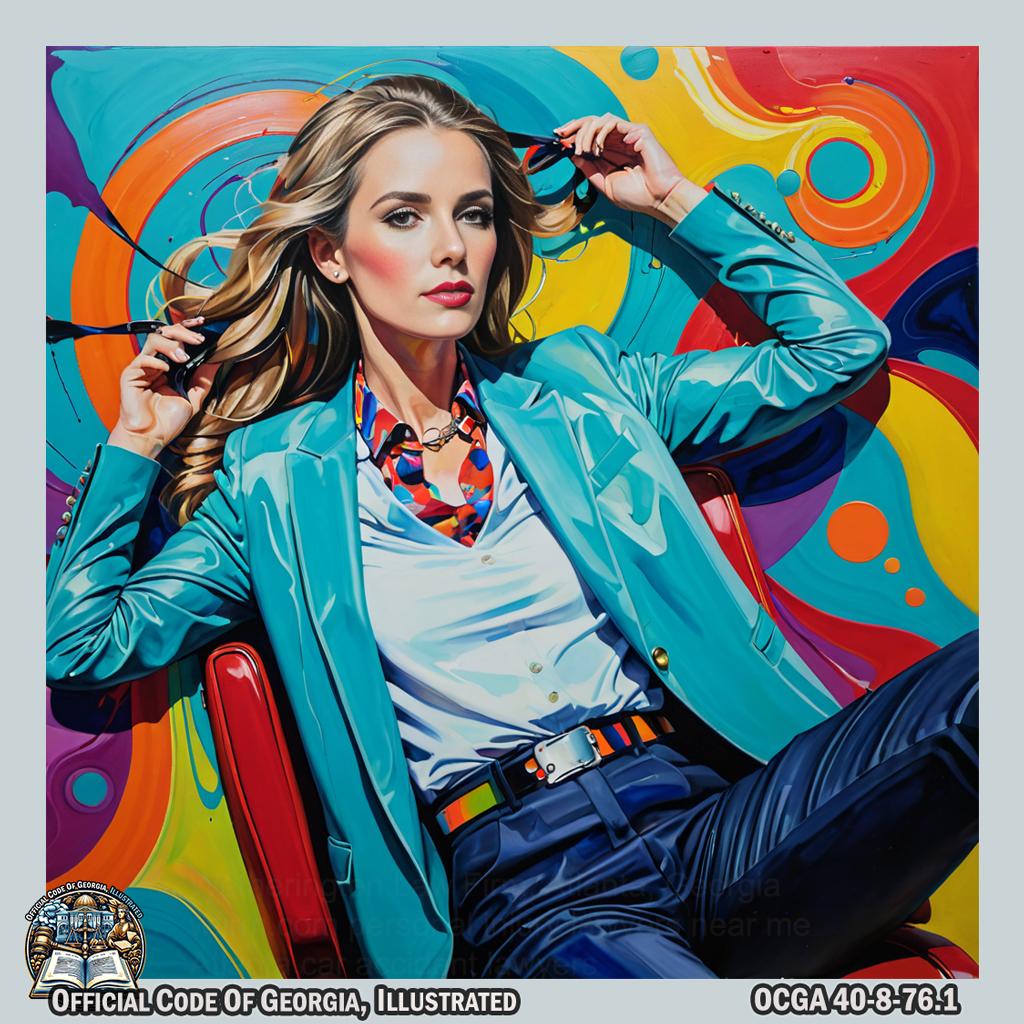
Charley Lincoln gracefully mimics the act of fastening a seatbelt with fluid and elegant movements, while surrounded by vibrant colors and abstract shapes in an art piece reminiscent of Anna Platten's style. -
The requirement of subsection (b) of this Code section shall not apply to:
- A driver or passenger frequently stopping and leaving the vehicle or delivering property from the vehicle, if the speed of the vehicle between stops does not exceed 15 miles per hour;
- A driver or passenger possessing a written statement from a physician that such person is unable, for medical or physical reasons, to wear a seat safety belt;
- A driver or passenger possessing an official certificate or license endorsement issued by the appropriate agency in another state or country indicating that the driver is unable for medical, physical, or other valid reasons to wear a seat safety belt;
- A driver operating a passenger vehicle in reverse;
-
A passenger vehicle with a model year prior to 1965;
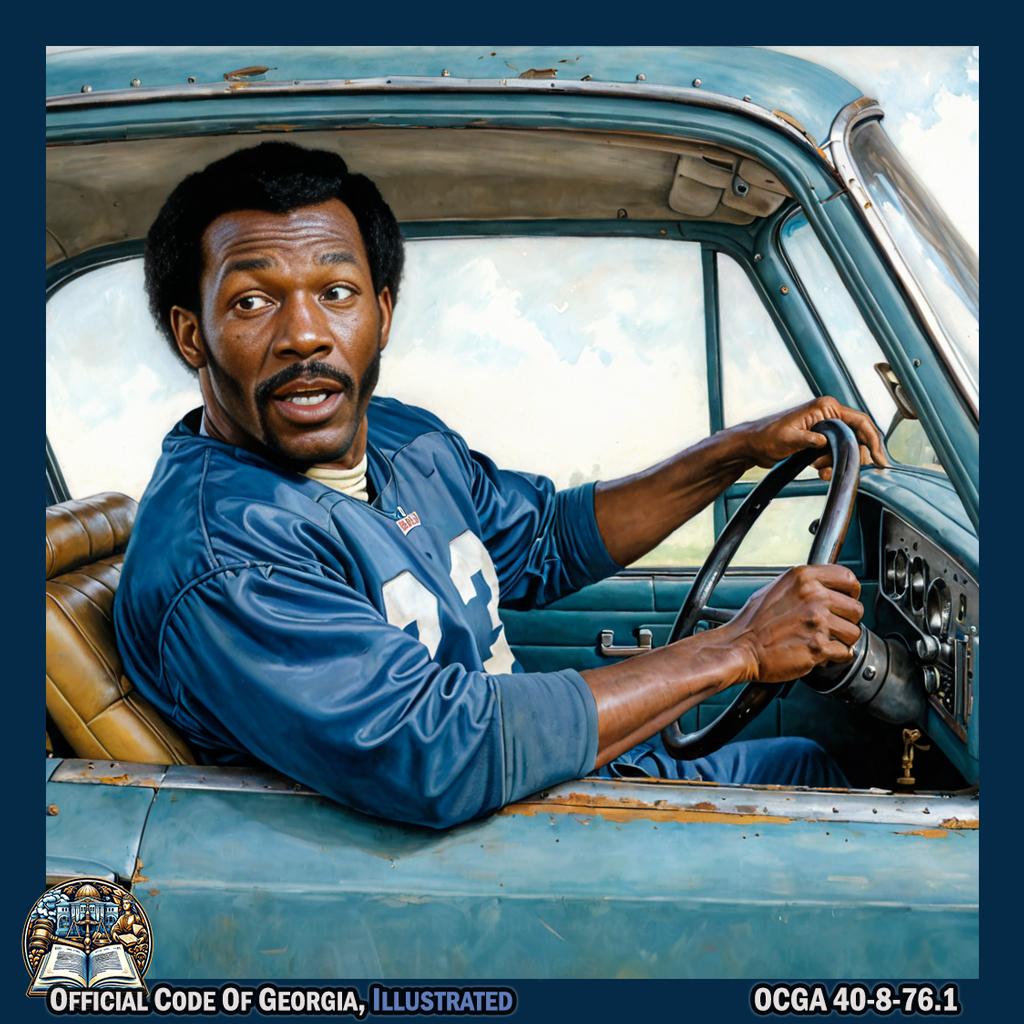
American football player Mel Blount, depicted in the style of Duane Hanson, portrays a surprised expression as he pretends to drive an old-fashioned car by holding onto an imaginary steering wheel. -
A passenger vehicle which is not required to be equipped with seat safety belts under federal law;
- A passenger vehicle operated by a rural letter carrier of the United States Postal Service while performing duties as a rural letter carrier;
- A passenger vehicle from which a person is delivering newspapers; or
- A passenger vehicle performing an emergency service.
-
The failure of an occupant of a motor vehicle to wear a seat safety belt in any seat of a motor vehicle which has a seat safety belt or belts shall not be considered evidence of negligence or causation, shall not otherwise be considered by the finder of fact on any question of liability of any person, corporation, or insurer, shall not be any basis for cancellation of coverage or increase in insurance rates, and shall not be evidence used to diminish any recovery for damages arising out of the ownership, maintenance, occupancy, or operation of a motor vehicle.
-
- Except as otherwise provided in paragraphs (2) and (3) of this subsection, a person failing to comply with the requirements of subsection (b) of this Code section shall not be guilty of any criminal act and shall not be guilty of violating any ordinance. A violation of this Code section shall not be a moving traffic violation for purposes of Code Section 40-5-57.
- A person failing to comply with the requirements of subsection (b) of this Code section shall be guilty of the offense of failure to wear a seat safety belt and, upon conviction thereof, may be fined not more than $15.00; but, the provisions of Chapter 11 of Title 17 and any other provision of law to the contrary notwithstanding, the costs of such prosecution shall not be taxed nor shall any additional penalty, fee, or surcharge to a fine for such offense be assessed against a person for conviction thereof. The court imposing such fine shall forward a record of the disposition of the case of failure to wear a seat safety belt to the Department of Driver Services.
- Each minor eight years of age or older who is an occupant of a passenger vehicle shall, while such passenger vehicle is being operated on a public road, street, or highway of this state, be restrained by a seat safety belt approved under Federal Motor Vehicle Safety Standard 208. In any case where a minor passenger eight years of age or older fails to comply with the requirements of this paragraph, the driver of the passenger vehicle shall be guilty of the offense of failure to secure a seat safety belt on a minor and, upon conviction thereof, may be fined not more than $25.00. The court imposing such a fine shall forward a record of the court disposition of the case of failure to secure a seat safety belt on a minor to the Department of Driver Services.
-
Probable cause for violation of this Code section shall be based solely upon a law enforcement officer’s clear and unobstructed view of a person not restrained as required by this Code section. Noncompliance with the restraint requirements of this Code section shall not constitute probable cause for violation of any other Code section.
40-8-77.Energy absorption system.¶
- As used in this Code section, the term “private passenger automobile” shall mean a four-wheel motor vehicle designed for carrying ten passengers or less, not for hire, for use on public roads and highways, and not designed for use as a dwelling or for camping, provided that the term “private passenger automobile” shall not include a multipurpose vehicle, which is, for the purposes of this Code section, defined as a motor vehicle, except a trailer, designed to carry ten passengers or less and constructed either on a truck chassis or with special features for occasional off-road operation.
- Every new private passenger automobile manufactured on and after August 1, 1973, which is sold or licensed in this state shall be sold subject to the manufacturer’s warranty that it is equipped with an appropriate energy absorption system conforming to all federal motor vehicle safety standards applicable to such automobile on the date of manufacture. The warranty may be given by means of the federal safety standard certification label affixed to the automobile.
40-8-78.Safety glazing.¶
- No person shall sell any motor vehicle manufactured after January 1, 1954, nor shall any such motor vehicle be registered unless such vehicle is equipped with safety glazing materials of a type approved by the commissioner of public safety wherever glazing materials are used in doors, windows, and windshields. The provisions of this Code section shall apply to all passenger-type motor vehicles, including passenger buses and school buses, but in respect to trucks, including truck tractors, the requirements as to safety glazing materials shall apply to all glazing materials used in doors, windows, and windshields in the drivers’ compartments of such vehicles.
-
The term “safety glazing materials” means glazing materials so constructed, treated, or combined with other materials as to reduce substantially, in comparison with ordinary sheet glass or plate glass, the likelihood of injury to persons by objects from exterior sources or by these safety glazing materials when they may be cracked or broken.
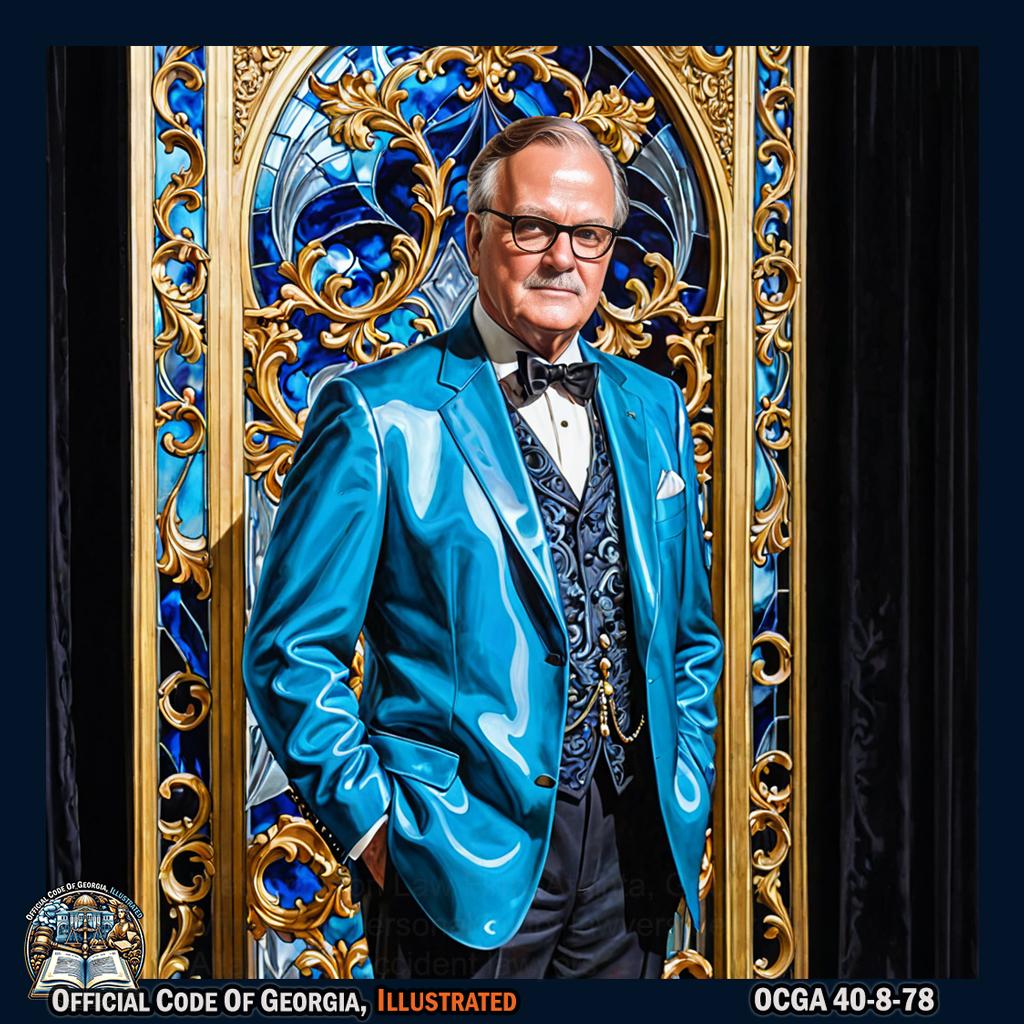
Actor Edward Andrews stands on a stage in Villa Rica, gracefully shaping glass into intricate designs that withstand external forces, embodying the essence of safety glazing materials with dramatic flair reminiscent of a Baroque art piece. -
Any person engaged in the business of replacing windshields or any side or rear windows of motor vehicles, which are subject to the provisions of this Code section, shall not replace such windshields or side or rear windows with any glazing materials other than safety glazing materials approved by the commissioner.
- The commissioner of public safety shall compile and publish in print or electronically a list of types of glazing materials by name approved by him or her as meeting the requirements of this Code section and the commissioner shall not register any motor vehicle which is subject to the provisions of this Code section unless it is equipped with an approved type of safety glazing materials, and he or she shall thereafter suspend the registration of any motor vehicle so subject to this Code section which he or she finds is not so equipped until it is made to conform to the requirements of this Code section.
- This Code section shall not be construed to require that side or rear windows of motor vehicles which were replaced or installed prior to January 1, 1954, must be replaced with safety glazing materials as provided in this Code section.
40-8-79.Unlawfully riding in bed of pickup truck; penalty.¶
It shall be unlawful for any person under the age of 18 to ride as a passenger in the uncovered bed of a pickup truck on any interstate highway in this state. The driver of any vehicle in violation of this Code section shall be guilty of a misdemeanor.
PART 5 Equipment of Law Enforcement and Emergency Vehicles¶
-
40-8-90. Restrictions on use of blue lights on vehicles.
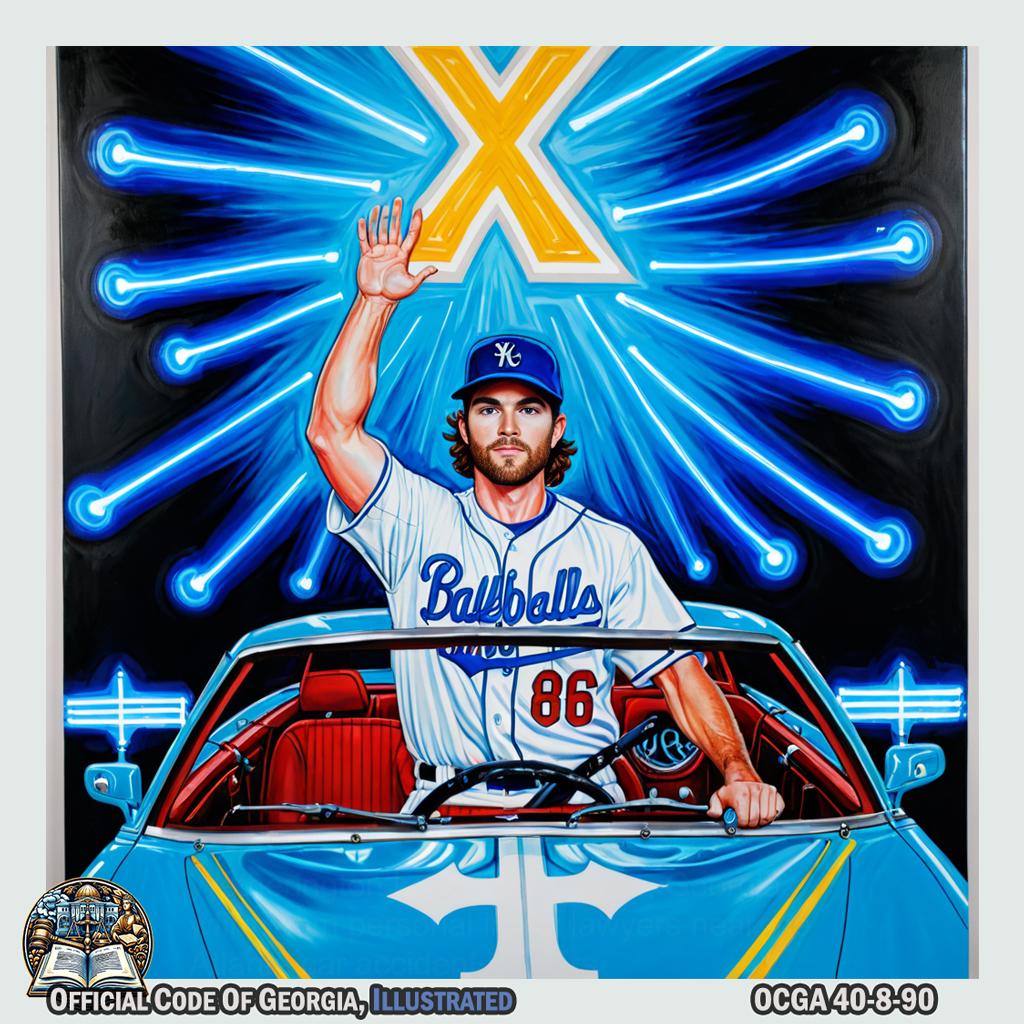
Charlie Culberson, a baseball player, pretends to drive a car and makes a big "X" with his arms to depict the restriction on using blue lights on vehicles in an art piece by Kathryn Del Barton. -@cculberson8 - 40-8-91.1. Marking and equipment of all-terrain vehicles used as law enforcement vehicles.
- 40-8-92. Designation of emergency vehicles; flashing or revolving lights; permits; fee; prohibition against use of flashing or revolving green lights by private persons on public property.
- 40-8-93. Flashing parking or brake lights or directional signals not prohibited.
- 40-8-94. Sirens, whistles, or bells.
- 40-8-95. Rules and regulations.
- 40-8-96. Violation of Code Sections 40-8-90 and 40-8-92.
40-8-90.Restrictions on use of blue lights on vehicles.¶
-
-
Except as provided in this paragraph and subsection (b) of this Code section, it shall be unlawful for any person, firm, or corporation to operate any motor vehicle equipped with or containing a device capable of producing any blue lights, whether flashing, blinking, revolving, or stationary, except:
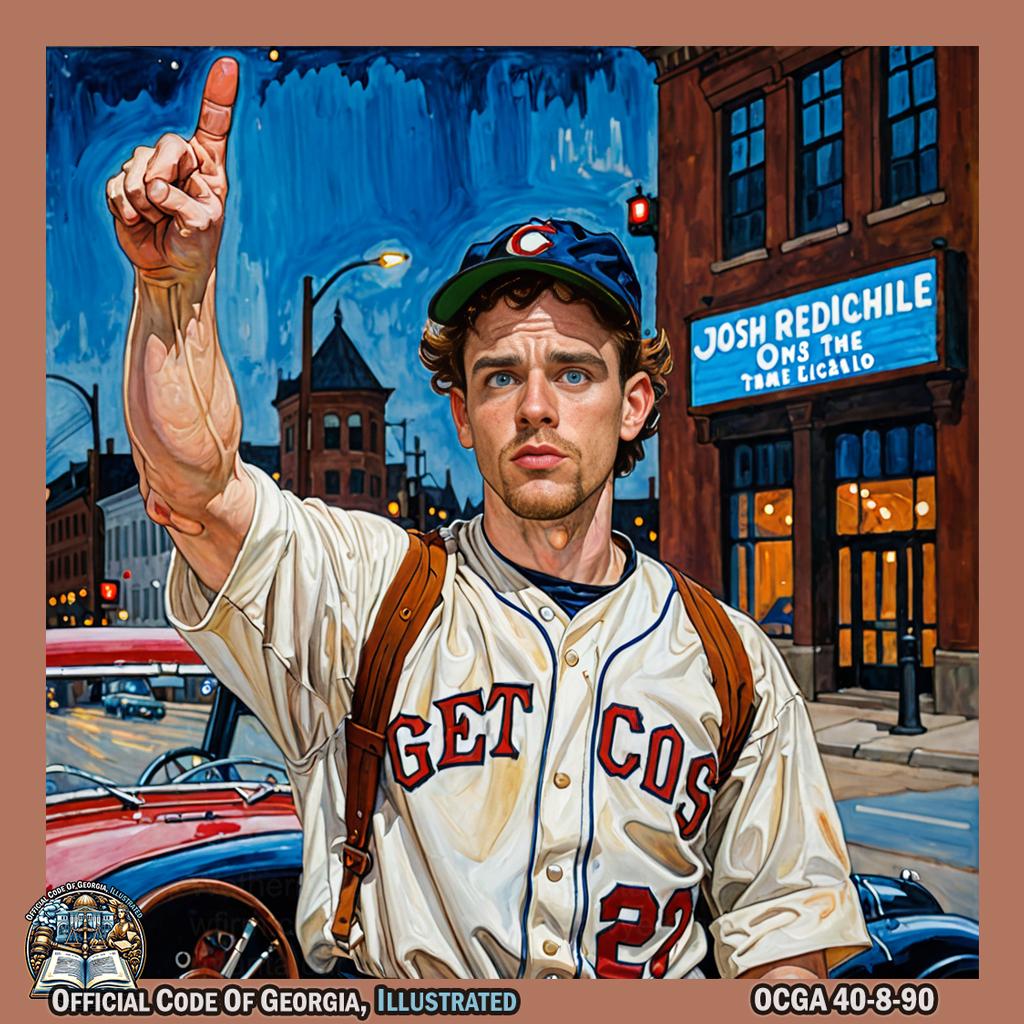
Josh Reddick, dressed in a vintage baseball uniform, dramatically poses with an exaggerated expression while gesturing as if driving a car and pointing to a sign prohibiting the use of blue lights on motor vehicles. The scene is set against the backdrop of Columbus's historic architecture, rendered in Egon Schiele's distinctive angular and expressive style. -@RealJoshReddick
1. Motor vehicles owned or leased by any federal, state, or local law enforcement agency; 2. Motor vehicles with a permit granted by a state agency to bear such lights; or

Curtis Crowe arranges a fleet of motor vehicles adorned with colorful lights in an artful display, reminiscent of Christo and Jeanne-Claude's style at The Tabernacle. - Antique, hobby, and special interest vehicles, as defined in paragraph (8) of subsection (l) of Code Section 40-2-86.1, which may display a blue light or lights of up to one inch in diameter as part of any such vehicle’s rear stop lamps, rear turning indicator, rear hazard lamps, and rear reflectors.
- Any person who violates paragraph (1) of this subsection shall be guilty of a misdemeanor.
- Antique, hobby, and special interest vehicles, as defined in paragraph (8) of subsection (l) of Code Section 40-2-86.1, which may display a blue light or lights of up to one inch in diameter as part of any such vehicle’s rear stop lamps, rear turning indicator, rear hazard lamps, and rear reflectors.
-
-
The prohibition contained in subsection (a) of this Code section shall not apply to any elected sheriff who, pursuant to an agreement between the sheriff and the county governing authority, is using his or her personal motor vehicle in a law enforcement activity, provided such vehicle is marked as provided in Code Section 40-8-91.
- It shall be unlawful for any person to use any motor vehicle equipped with flashing, blinking, revolving, or stationary blue lights in the commission of a felony, and, upon conviction of a violation of this subsection, the punishment shall be a fine of not less than $1,000.00 or imprisonment of not less than one year, or both.
40-8-91.Marking and equipment of law enforcement vehicles; motorist allowed to continue to safe location before stopping for law enforcement officer vehicles.¶
- Except as provided in subsection (b) of this Code section, any motor vehicle which is used on official business by any person authorized to make arrests for traffic violations in this state, or any municipality or county thereof, shall be distinctly marked on each side and the back with the name of the agency responsible therefor, in letters not less than four inches in height.
-
Any motor vehicle, except as hereinafter provided in this subsection, used by any employee of the Georgia State Patrol for the purpose of enforcing the traffic laws of this state shall be distinctly painted, marked, and equipped in such manner as shall be prescribed by the commissioner of public safety pursuant to this Code section. The commissioner in prescribing the manner in which such vehicles shall be painted, marked, or equipped shall:
- Require that all such motor vehicles be painted in a two toned uniform color or a solid color. For vehicles painted in a two toned uniform color, the hood, top, and the top area not to exceed 12 inches below the bottom of the window opening thereof shall be a light gray color and the remaining portion of said motor vehicle shall be painted a dark blue color;
- Require that any such motor vehicle be equipped with at least one lamp which when lighted shall display a flashing or revolving light, primarily blue in color, visible under normal atmospheric conditions for a distance of 500 feet from the front and rear of such vehicle; and
- Require that any such motor vehicle shall be distinctly marked on each side and the back thereof with the wording “State Patrol” in letters not less than six inches in height of a contrasting color from the background color of the motor vehicle.
-
It shall be unlawful for any person, except persons lawfully entitled to own vehicles for law enforcement purposes, to paint, mark, or equip any motor vehicle in the same manner prescribed by this Code section or by the commissioner for law enforcement vehicles.

6LACK meticulously painting a police car with vibrant colors and intricate designs, all while surrounded by lush greenery and the natural beauty of the Duke Lemur Center, creating an art piece in the style of Jeannie Baker's work. -@6LACK -
When a law enforcement vehicle is disposed of, or is not in use for law enforcement, the lettering and colored lights must be removed. Any person using such vehicle for personal use prior to removing colored lights and lettering shall be guilty of a misdemeanor.
- Whenever a motorist driving on the roadways of this state is directed to stop by a law enforcement officer in a law enforcement vehicle marked as required under this Code section, the motorist may continue to drive until a reasonably safe location for stopping is reached. Such motorist shall indicate to the officer his or her intent to proceed to a safe location by displaying the vehicle’s flashing lights or turn signal. In proceeding to a safe location, the motorist shall observe the posted maximum speed limit.
- An otherwise lawful arrest shall not be invalidated or in any manner affected by failure to comply with this Code section.
40-8-91.1.Marking and equipment of all-terrain vehicles used as law enforcement vehicles.¶
- As used in this Code section, the term “all-terrain vehicle” shall have the same meaning as provided for in paragraph (3) of Code Section 40-1-1.
- Every all-terrain vehicle must comply with the equipment and marking specifications set forth in this article before such vehicle can be used by law enforcement agencies and officers upon the public roads of this state. All provisions of law relating to safe operation of law enforcement or emergency vehicles shall be applied to the operation of such all-terrain vehicles.
- Any all-terrain vehicle which is operated by law enforcement agencies and officers upon the public roads of this state shall be registered and licensed in accordance with the provisions of Code Section 40-2-37.
40-8-92.Designation of emergency vehicles; flashing or revolving lights; permits; fee; prohibition against use of flashing or revolving green lights by private persons on public property.¶
-
All emergency vehicles shall be designated as such by the commissioner of public safety. The commissioner shall so designate each vehicle by issuing to such vehicle a permit to operate flashing or revolving emergency lights of the appropriate color. Such permit shall be valid for five years from the date of issuance. Any and all officially marked law enforcement vehicles as specified in Code Section 40-8-91 shall not be required to have a permit for the use of a blue light. Any and all fire department vehicles which are distinctly marked on each side shall not be required to have a permit for the use of a red light. Any and all ambulances, as defined in Code Section 31-11-2, licensed by this state shall not be required to have a permit for the use of a red light. Any low-speed vehicle shall not be required to have a permit for the use of an amber strobe light.

Maria Louise Eve, dressed as a commissioner with an air of authority, strides confidently across a sun-dappled town square in Stockbridge. She gracefully extends her arms to mimic issuing permits, swirling her hands as if twirling invisible documents that transform into bursts of colored light: blue for law enforcement vehicles, red for fire trucks and ambulances, amber for low-speed vehicles. Each vehicle she "designates" is represented by fellow performers who dance around her in choreographed movements mimicking the flashing lights; they spin and weave through the crowd as if driving in emergency mode. The scene is set against a backdrop of flowing abstract shapes and vibrant colors reminiscent of Kathleen Gemberling Adkison's expressive paintings, infusing the entire performance with energy and vividness that captures the essence of emergency services' dynamism and urgency. -
The commissioner shall authorize the use of red or amber flashing or revolving lights only when the person or governmental agency shall demonstrate to the commissioner a proven need for equipping a vehicle with emergency lights. The fee for such lights shall be $2.00, provided that no federal, state, county, or municipal governmental agency or an ambulance provider, as defined in Code Section 31-11-2, shall be required to pay such fee.
- Nothing contained in this Code section shall prohibit the commissioner from issuing a single special use permit to cover more than one vehicle, provided each vehicle covered under such special use permit shall pay the fee specified in subsection (b) of this Code section.
- Except as provided in this subsection, it shall be unlawful for any person, firm, or corporation to operate any motor vehicle or to park any motor vehicle on public property with flashing or revolving green lights. This subsection shall not apply to any motor vehicle being used by any law enforcement agency, fire department, emergency management agency, or other governmental entity to designate the location of the command post for such agency, department, or entity at the site of an emergency.
40-8-93.Flashing parking or brake lights or directional signals not prohibited.¶
Nothing contained in Code Sections 40-8-90 and 40-8-92 shall be deemed to apply to nor construed to prohibit blinking or flashing parking or brake lights or directional signals on any motor vehicle.
40-8-94.Sirens, whistles, or bells.¶
Any authorized emergency vehicle may be equipped with a siren, whistle, or bell capable of emitting sound audible under normal conditions from a distance of not less than 500 feet, but such siren shall not be used except when such vehicle is operated in response to an emergency call or in the immediate pursuit of an actual or suspected violator of the law, in which latter event the driver of such vehicle shall sound the siren when necessary to warn pedestrians and other drivers of the approach thereof.
40-8-95.Rules and regulations.¶
The commissioner of public safety shall implement any and all provisions of Code Sections 40-8-90, 40-8-92, and 40-8-93 by the promulgation of necessary rules and regulations.
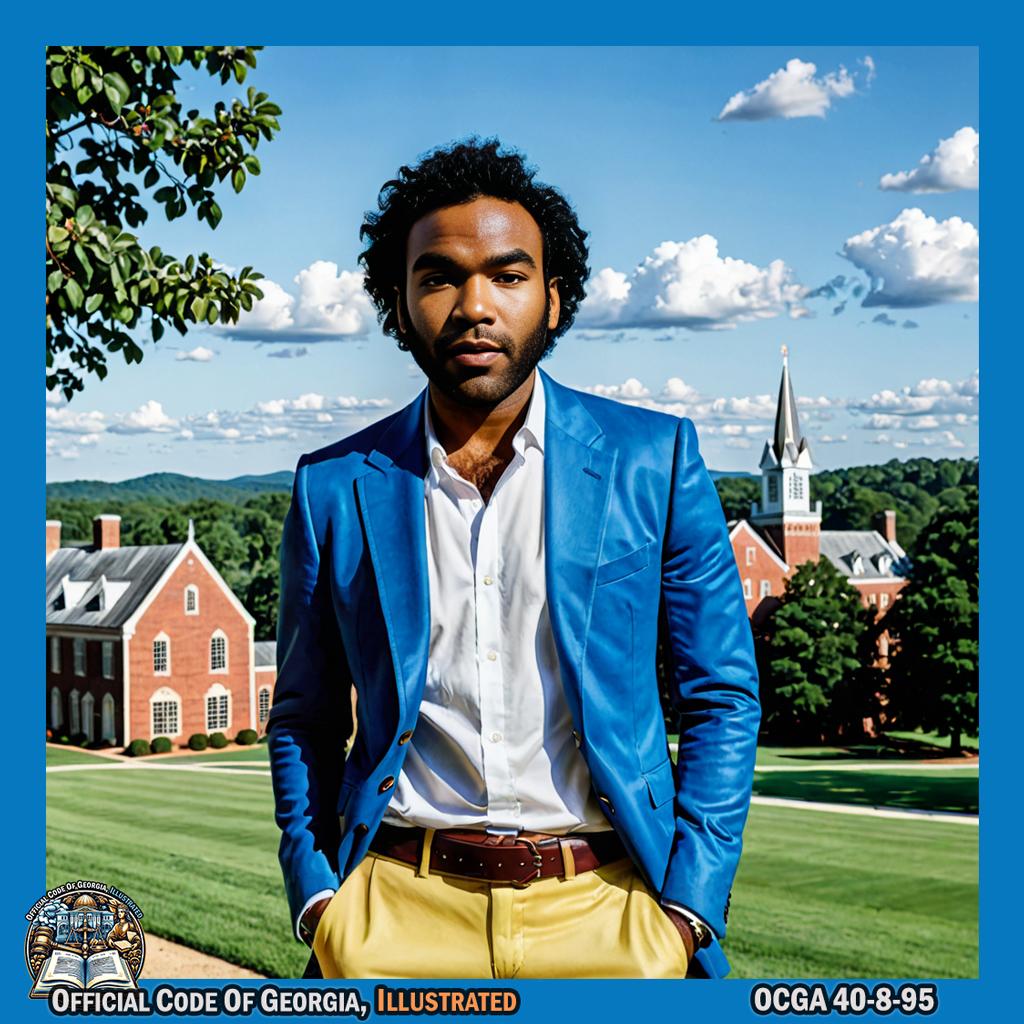
40-8-96.Violation of Code Sections 40-8-90 and 40-8-92.¶
Any person violating Code Sections 40-8-90 and 40-8-92 shall be guilty of a misdemeanor.
PART 6 Equipment of School Buses¶
-
40-8-110. Identification and color.

Singer Doug Stone, in a rich scene at the Georgia location Arabia Mountain Hike, points to different objects and names their colors while making exaggerated facial expressions. -@dougstonetour -
40-8-111. Equipment generally.
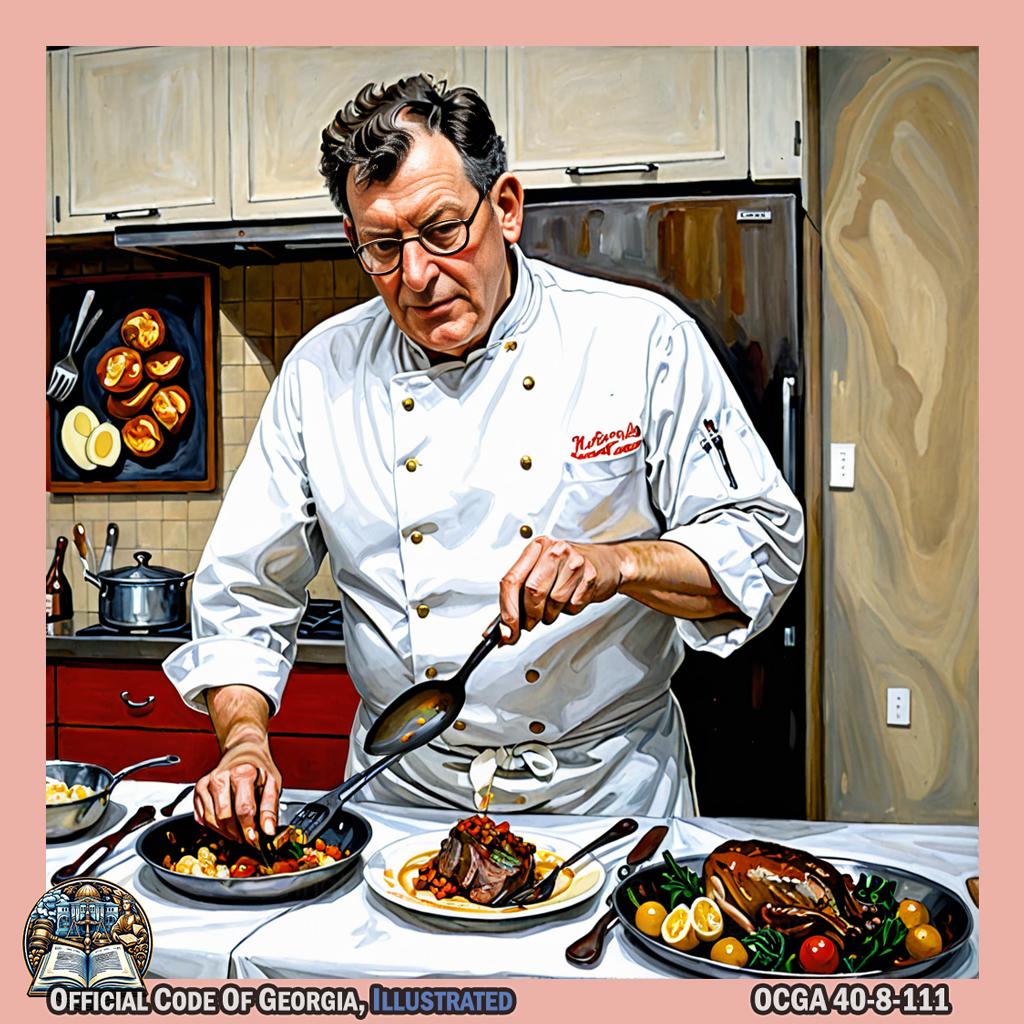
Norman Blake, in a rich scene at Taste of Atlanta, pretends to be a chef and uses imaginary utensils to cook a fantastic meal. - 40-8-113. Standards applicable regardless of size or capacity.
- 40-8-114. Operation of school buses by churches, private schools, and local transit systems; transportation of school children on buses owned or operated by public transit systems.
- 40-8-115. Identification and equipment of school buses for special school route service.
- 40-8-116. Unlawful acts.
40-8-110.Identification and color.¶
-
Every bus used for the transportation of school children shall bear upon the front and rear thereof a plainly visible sign containing the words “SCHOOL BUS” in letters not less than eight inches in height.

Quavo, standing in front of a school bus, raises his arms and with grand gestures creates an eight-inch tall "SCHOOL BUS" sign using invisible paint, while surrounded by swirling colors and geometric shapes inspired by Janine Mackintosh's art. -@QuavoStuntin -
On and after January 1, 1971, every new school bus purchased for the transportation of school children shall be painted National School Bus Chrome Yellow.
40-8-111.Equipment generally.¶
- Each school bus used for the transportation of school children in the State of Georgia shall be in compliance with the State Board of Education bus specifications for the model year of such school bus.
- Each public school system shall be required to maintain each of its school buses in good working condition, including all safety equipment required in accordance with the specifications established pursuant to subsection (a) of this Code section.
- Nothing in subsection (a) of this Code section shall apply to motor vehicles operated by a local transit system which transport school children to and from school on regular or scheduled routes of a transit vehicle with regular fare-paying passengers.
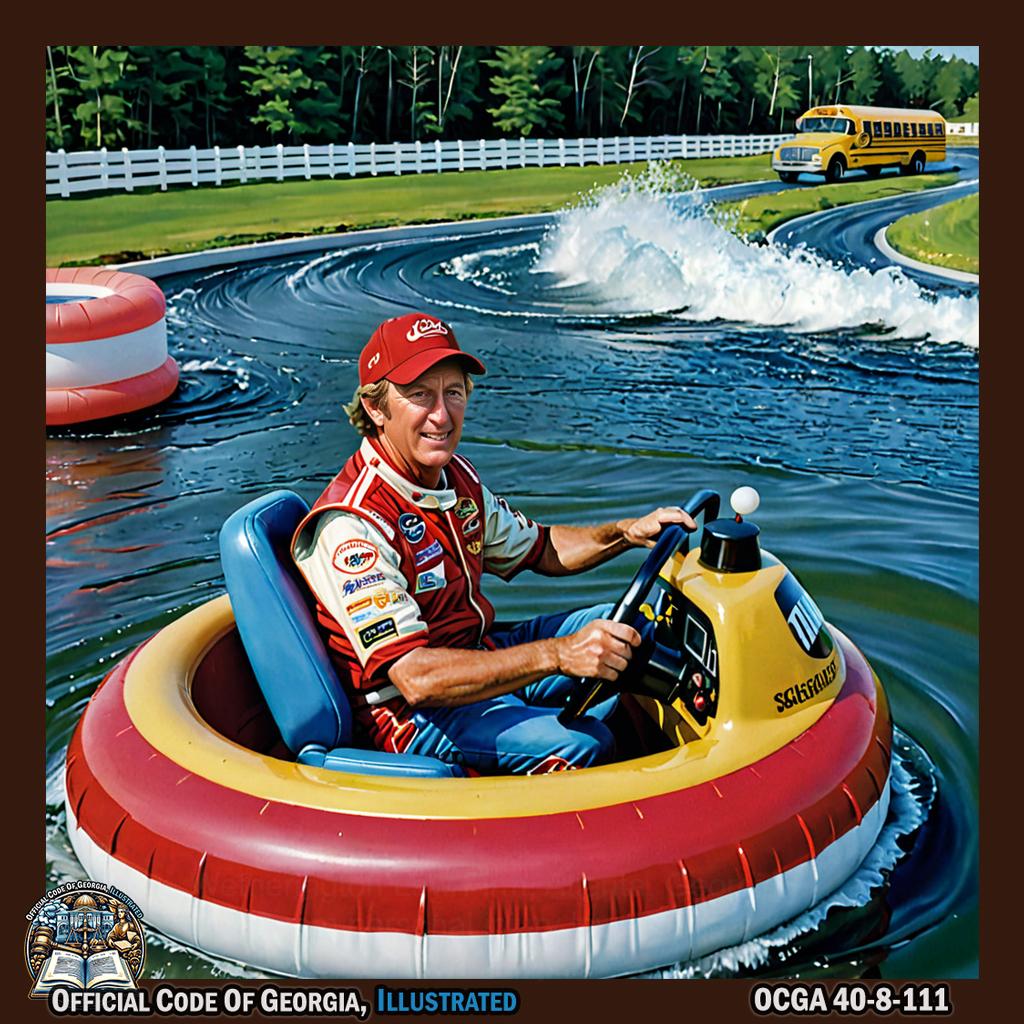
NASCAR driver Bill Elliott, in full racing gear, stands at the helm of a whimsical oversized school bus steering wheel that's integrated into a serene and expansive SoundWaves waterpark landscape, where children with floaties shaped like cars paddle around him on scheduled routes marked by floating buoys; all captured in the hyperrealist photographic style of Jeff Wall. -@BillElliott9
40-8-112.Compliance with State Board Bus Specifications.¶
Every school bus used to transport children to and from school shall comply with the State Board Bus Specifications prescribed by the State Board of Education.
40-8-113.Standards applicable regardless of size or capacity.¶
The identification and equipment standards provided in this part shall apply to all school buses as defined in paragraph (55) of Code Section 40-1-1 regardless of size or capacity.
40-8-114.Operation of school buses by churches, private schools, and local transit systems; transportation of school children on buses owned or operated by public transit systems.¶
- Notwithstanding any other provision of this title to the contrary, churches, private schools, or local transit systems may operate school buses meeting the equipment, color, and marking requirements of Code Sections 40-8-110 through 40-8-112 and 40-8-115 and drivers of such vehicles shall be required to stop as set forth in Code Section 40-6-163. For purposes of this subsection, only churches and private schools are authorized to comply with Code Sections 40-8-110 through 40-8-112, and only local transit systems are authorized to comply with Code Section 40-8-115.
-
Notwithstanding any other provision of this title to the contrary, the requirements relating to buses used for the transportation of school children, which requirements are contained in the following Code sections:

Kip Moore gracefully mimics the act of reading and interpreting a legal document, using exaggerated gestures and expressions to visually depict the complexities of the text, all while surrounded by abstract artistic props evoking Man Ray's style. -@KipMooreMusic -
Code Section 40-6-160, relating to speed limits;

Martin Luther King Jr. delicately gesturing with his hands, mimicking the flow and movement of traffic while surrounded by vibrant, abstract shapes and patterns in the style of Henri Matisse's "The Dance" set against a backdrop of Columbus, Georgia's historic landmarks. -
Code Section 40-6-161, relating to headlamps;

Jesse Mercer stands under a vibrant, swirling canopy of light, moving his arms in fluid, circular motions to mimic the act of adjusting headlamps on an imaginary vehicle at Shields-Ethridge Heritage Farm. -
Code Section 40-6-162, relating to use of visual signals;
-
Code Section 40-6-163, relating to meeting or passing school buses;
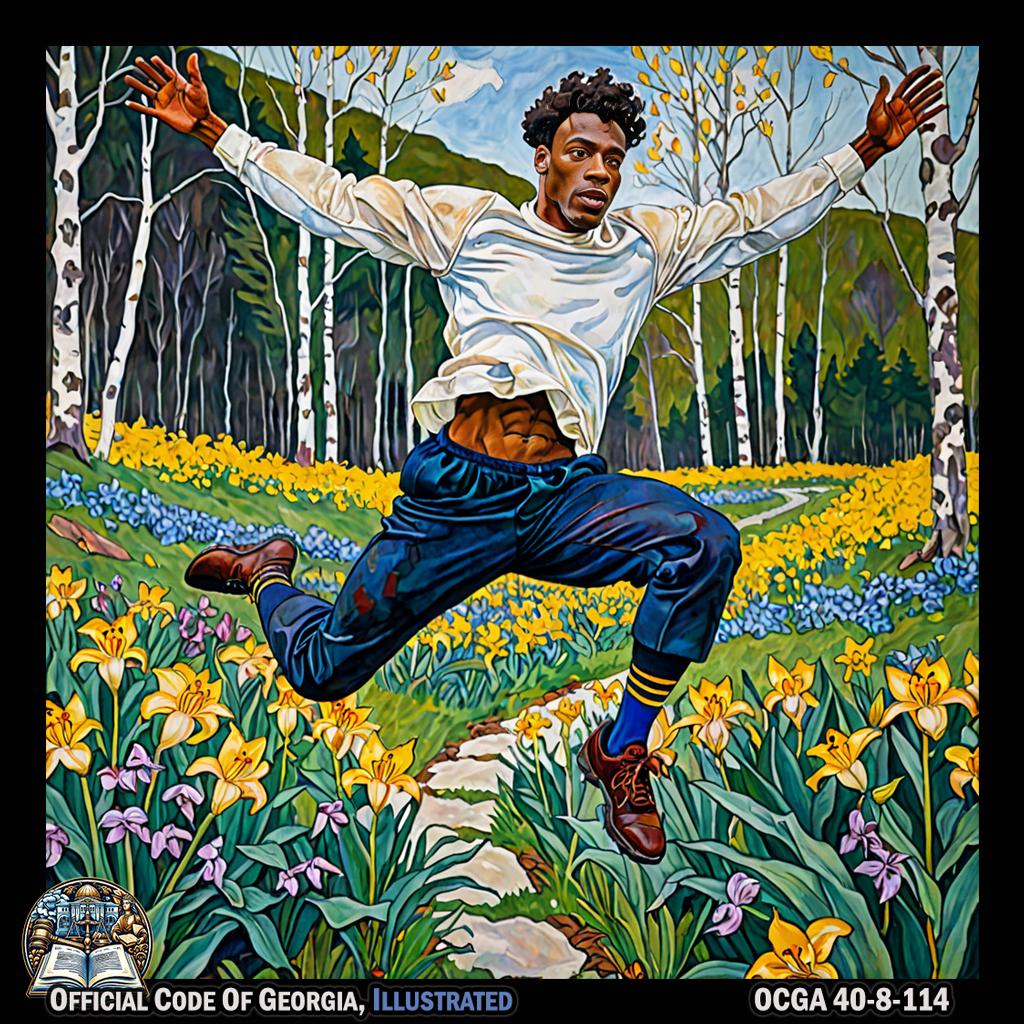
Football player Robert Mathis stands in a dynamic pose, with his arms extended and one leg lifted as if he is leaping over a school bus parked amidst the vibrant flowers of Wolf Creek Trout Lily Preserve, capturing the essence of Egon Schiele's style. -@RobertMathis98 -
Code Section 40-8-110, relating to identification and color;

Patrika Darbo moves with angular, geometric precision, using her body to create a living representation of the Code Section relating to identification and color, set against the backdrop of Congregation Mickve Israel in a style reminiscent of Kazimir Malevich's art. -@patrikadarbo -
Code Section 40-8-111, relating to equipment generally;
- Code Section 40-8-112, relating to compliance with certain State Board of Education specifications;
- Code Section 40-8-115, relating to identification and equipment of certain school buses; and
-
Code Section 40-8-220, relating to inspection of school buses,

Lucille Hegamin gracefully dances around a larger-than-life book, adorned with whimsical illustrations of school buses and surrounded by swirling patterns in the style of Marc Chagall, while delicately pointing to a specific section and miming the act of inspecting with childlike wonder. shall not apply to any bus which is owned or operated by a publicly owned and operated transit system and which either transports school children to and from school on regular or scheduled routes with regular fare-paying passengers or which engages in tripper service.

Frank Bush, dressed in a vibrant red and yellow uniform, mimics driving a bus with exaggerated arm movements while intertwining his legs to represent the complex transit system described. He does so amidst a backdrop of colorful geometric shapes reminiscent of Jasper Johns' style.
-
40-8-115.Identification and equipment of school buses for special school route service.¶
This part shall not prohibit the use of a school bus as defined in paragraph (55) of Code Section 40-1-1 for special school route service, provided it shall meet the following identification and equipment requirements:
- The bus need not be painted yellow or black;
- The bus shall be equipped with four hooded or recessed red flasher lights, or four red flasher lights and four amber flasher lights mounted on the same horizontal centerline as the red lights and nearer the centerline. Such amber lights shall be at least two and one-half times brighter than the red lights. The system shall be wired so that the amber signal lights are activated only by manual or foot operation and if activated are automatically deactivated and the red signal lights activated when the bus entrance door is opened; and
- While transporting children to or from school, the bus shall be equipped with the following temporary signs, located conspicuously on the front and back of such vehicle:
- The sign on the front shall have the words “SCHOOL BUS” printed in black letters not less than six inches high, on a background of National School Bus Glossy Yellow; and
- The sign on the rear shall be at least ten square feet in size and shall be painted National School Bus Glossy Yellow and have the words “SCHOOL BUS” printed in black letters not less than eight inches high.
40-8-116.Unlawful acts.¶
It shall be unlawful to operate:
- Any vehicle displaying the words “SCHOOL BUS” unless it meets the color, identification, and equipment requirements set forth in Code Section 40-8-113 or 40-8-115;
- A vehicle without the words “SCHOOL BUS” but which is of a color and exhibits some equipment or identification which reasonably could cause a motorist to confuse it with a properly colored, identified, and equipped school bus;
-
Any school bus for any purpose other than the transportation of school children to or from school or school activities without concealing or covering all markings thereon indicating “SCHOOL BUS”; or

Ralph Reed is standing in a serene, idyllic garden, carefully and meticulously covering the bright yellow "SCHOOL BUS" markings on a school bus with a beautiful floral tapestry, surrounded by lush greenery and vibrant flowers in Brunswick. -@ralphreed -
A vehicle which has been permanently converted from the purpose of transporting students to or from school or school activities without first having painted such vehicle some color other than the yellow required in subsection (b) of Code Section 40-8-110 and without having removed the stop arms, if any, and any other equipment required by Code Section 40-8-111.
Article 2 Control of Vehicle Emissions¶
- PART 1 Emission Control Devices Generally
- PART 2 Establishment of Emission Standards; Inspection of Motor Vehicles for Compliance with Standards
- PART 3 Visible Emissions
PART 1 Emission Control Devices Generally¶
- 40-8-130. Unlawful to operate vehicle without serviceable emission control device; penalty; exceptions.
- 40-8-131. Inspection without warrant authorized.
- 40-8-132. [Repealed] Annual inspection.
40-8-130.Unlawful to operate vehicle without serviceable emission control device; penalty; exceptions.¶
- It shall be unlawful for the owner of any motor vehicle to operate or permit the operation of such vehicle on which any device controlling or abating atmospheric emissions which is placed on a motor vehicle by the manufacturer pursuant to regulations promulgated by the United States secretary of health and human services in accordance with the provisions of Title II, the National Emissions Standards Act, of the Air Quality Act of 1967, Public Law 90-148 has been rendered unserviceable by removal, alteration, or other interference with its operation.
- Any person violating subsection (a) of this Code section shall be guilty of a misdemeanor.
- Subsection (a) of this Code section shall not apply to any person repairing any such device described in that subsection or to the removal of any such device by any person for the purpose of repairing or replacing such device.
- Subsection (a) of this Code section shall not apply to any person removing any such device for the purpose of converting any motor vehicle to operate on natural or liquefied petroleum gas or make any other modifications which would reduce atmospheric emissions.
40-8-131.Inspection without warrant authorized.¶
Any vehicle suspected of being operated in violation of this part may be the subject of an inspection conducted by an officer of the Georgia State Patrol who has reason to believe such violation is occurring, without the necessity of obtaining a warrant to permit such inspection.
40-8-132.[Repealed] Annual inspection.¶
PART 2 Establishment of Emission Standards; Inspection of Motor Vehicles for Compliance with Standards¶
40-8-150 through 40-8-163.[Reserved]¶
PART 3 Visible Emissions¶
- 40-8-180. Short title.
- 40-8-181. Visible emissions from vehicles on public roadways prohibited; exceptions.
- 40-8-182. Enforcement of part; traffic violation citations.
- 40-8-183. Penalty.
- 40-8-184. Municipal and county regulation prohibited.
- 40-8-185. Part not applicable to certain vehicles.
40-8-180.Short title.¶
This part shall be known and may be cited as the “Vehicular Visible Emission Control Act.”
40-8-181.Visible emissions from vehicles on public roadways prohibited; exceptions.¶
- It shall be unlawful for any person to operate on a public roadway of this state a diesel powered vehicle which discharges into the atmosphere visible emissions resulting in a decrease of light transmission beyond 30 percent, whether emitted from the crankcase, the exhaust system, or from any part of the power system; provided, however, that the light obscuring limitations prescribed in this subsection may be exceeded during periods of acceleration and deceleration not to exceed ten continuous seconds or 1,000 feet.
- It shall be unlawful for any person to operate on a public roadway of this state a gasoline powered vehicle which discharges into the atmosphere visible emissions resulting in a decrease of light transmission, whether emitted from the crankcase, the exhaust system, or from any part of the power system; provided, however, that the light obscuring limitation prescribed in this subsection may be exceeded for periods not to exceed ten continuous seconds or 1,000 feet.
- Subsections (a) and (b) of this Code section shall not apply to the normal discharge of condensed water vapor.
40-8-182.Enforcement of part; traffic violation citations.¶
- This part shall be enforced by the duly authorized traffic control agency of this state or of any political subdivision thereof. The Air Quality Control Agency of this state shall produce and furnish to such traffic control agency appropriate light transmission gauges to be used in the enforcement of this part.
- A traffic violation citation shall be issued to the operator of a vehicle in violation of any provision of this part on and after January 1, 1973.
40-8-183.Penalty.¶
Any person who violates any provision of this part shall be guilty of a misdemeanor and, upon conviction thereof, shall be punished by a fine of not less than $10.00 nor more than $25.00.

40-8-184.Municipal and county regulation prohibited.¶
No subdivision of this state shall enact any ordinance or issue any rules and regulations pertaining to the discharging into the atmosphere of visible emissions from diesel powered vehicles or gasoline powered vehicles.
40-8-185.Part not applicable to certain vehicles.¶
This part shall not apply to off-highway farm, forest, and construction equipment being moved from one work location to another.
Article 3 Inspections by Officers of Department of Public Safety¶
-
40-8-200. Inspection of vehicles by officers of the Department of Public Safety; certificate of inspection; procedure for noncompliant vehicle.

Outkast, performing in a rich scene in SE Atlanta, Georgia, use a magnifying glass to inspect a toy car and then give it a sticker of approval or disapproval as if they were officers. -@Outkast
40-8-200.Inspection of vehicles by officers of the Department of Public Safety; certificate of inspection; procedure for noncompliant vehicle.¶
- The commissioner of public safety and members of the Department of Public Safety, and such other officers and employees of the department as the commissioner may designate, may at any time, upon reasonable cause to believe that a vehicle is unsafe or not equipped as required by law or that its equipment is not in proper adjustment or repair, require the driver of such vehicle to stop and submit such vehicle to an inspection and such tests with reference thereto as may be appropriate.
- In the event such vehicle and its equipment are found to be in safe condition and in full compliance with the law, the officer making such an inspection shall issue to the driver an official certificate of inspection and approval of such vehicle specifying those parts or equipment so inspected and approved.
- In the event such vehicle is found to be in unsafe condition or any required part or equipment is not present or is not in proper repair and adjustment, the officer shall give a written notice to the driver and shall send a copy to the department. Such notice shall require that such vehicle be placed in safe condition and its equipment in proper repair and adjustment specifying the particulars with reference thereto and shall require that a certificate of inspection and approval be obtained within 30 days.
40-8-201.Duties of owners and drivers of vehicles.¶
- No person driving a vehicle shall refuse to submit such vehicle to an inspection and test when required to do so by the commissioner of public safety or an authorized officer of the Department of Public Safety.
-
Every owner or driver, upon receiving a notice as provided in Code Section 40-8-200, shall comply therewith and shall within 30 days secure an official certificate of inspection and approval, which shall be issued in duplicate, one copy to be retained by the owner or driver and the other copy to be forwarded to the Department of Public Safety. In lieu of compliance with this subsection, the vehicle shall not be operated, except as provided in subsection (c) of this Code section.

Jermaine Dupri, in the style of Maria Sibylla Merian, delicately plucks a vibrant flower from a lush garden and presents it as an offering to an elegant peacock, all while gesturing with his hands the process of receiving and securing an official certificate of inspection and approval for a vehicle as described in the provided Code Section. -@jermainedupri -
No person shall operate any vehicle after receiving a notice with reference thereto as provided in Code Section 40-8-200 except as may be necessary to return such vehicle to the residence or place of business of the owner or driver, or to a garage, until such vehicle and its equipment have been placed in proper repair and adjustment and otherwise made to conform to the requirements of this article. A certificate of inspection and approval shall be obtained as promptly as possible thereafter.
- In the event repair or adjustment of any vehicle or its equipment is found necessary upon inspection, the owner of such vehicle may obtain such repair or adjustment at any place he may choose, but in every event an official certificate of inspection and approval must be obtained; otherwise, such vehicle shall not be operated upon the highways of this state.
Article 4 Inspection of Public School Buses {#t40c08a04}

- 40-8-220. Inspection of public school buses.
- 40-8-221. Penalty.
- 40-8-222 through 40-8-264. [Repealed]
40-8-220.Inspection of public school buses.¶
- Every school bus which is defined by paragraph (55) of Code Section 40-1-1 which is owned or operated by a state, county, or municipal government or under contract by any independent school system shall be inspected annually, or more frequently at the discretion of the commissioner of public safety, under the supervision of an employee of the Department of Public Safety.
- The employee of the department shall supervise the inspection of such vehicle to determine if such vehicle possesses in safe operating condition the equipment which is applicable to school buses required by Parts 1 through 4 of Article 1 of this chapter and the equipment required by Part 6 of Article 1 of this chapter.
- If such vehicle is found to meet the equipment and safety requirements specified in subsection (b) of this Code section, then the employee of the department making the inspection shall issue a school bus certificate of safety inspection to the vehicle.
- If such vehicle does not meet the equipment and safety requirements specified in subsection (b) of this Code section, then that vehicle shall not be operated on the streets and highways of this state, and no school bus certificate of safety inspection shall be issued to such vehicle.
-
All public school buses shall be made available for the inspection required under this Code section, and no person shall conceal any bus required to be inspected under this Code section.
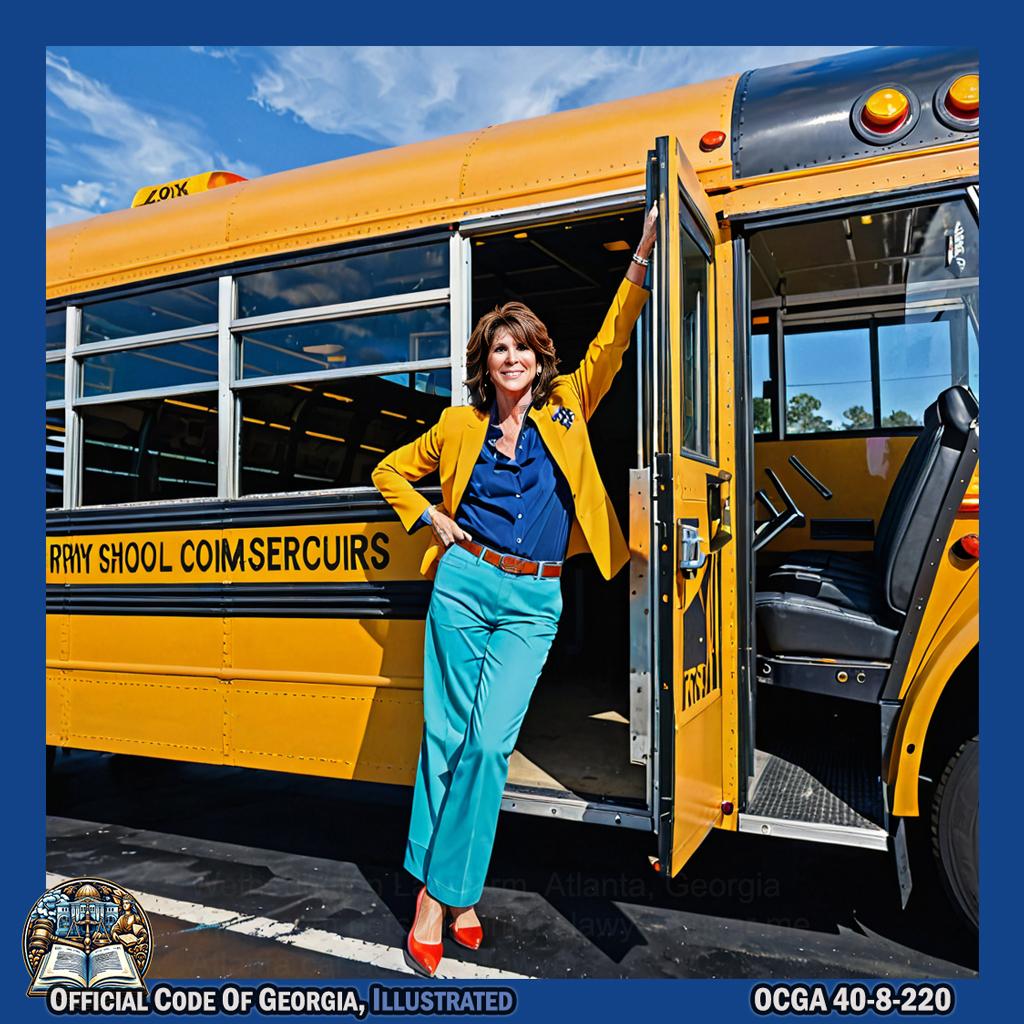
Amy Ray, with a dramatic flourish, opens the doors of a vibrant, geometrically-patterned school bus as if unveiling a masterpiece, inviting inspectors to enter under the bright Hinesville sun while she theatrically gestures towards its open engine and underneath the chassis in an energetic dance that mimics Larry Zox's dynamic shapes and bold colors. -@AmyRay -
The commissioner of public safety is authorized to implement any and all provisions of this Code section by the promulgation of necessary rules and regulations. When duly promulgated and adopted, all rules and regulations issued pursuant to this Code section shall have the force of law.
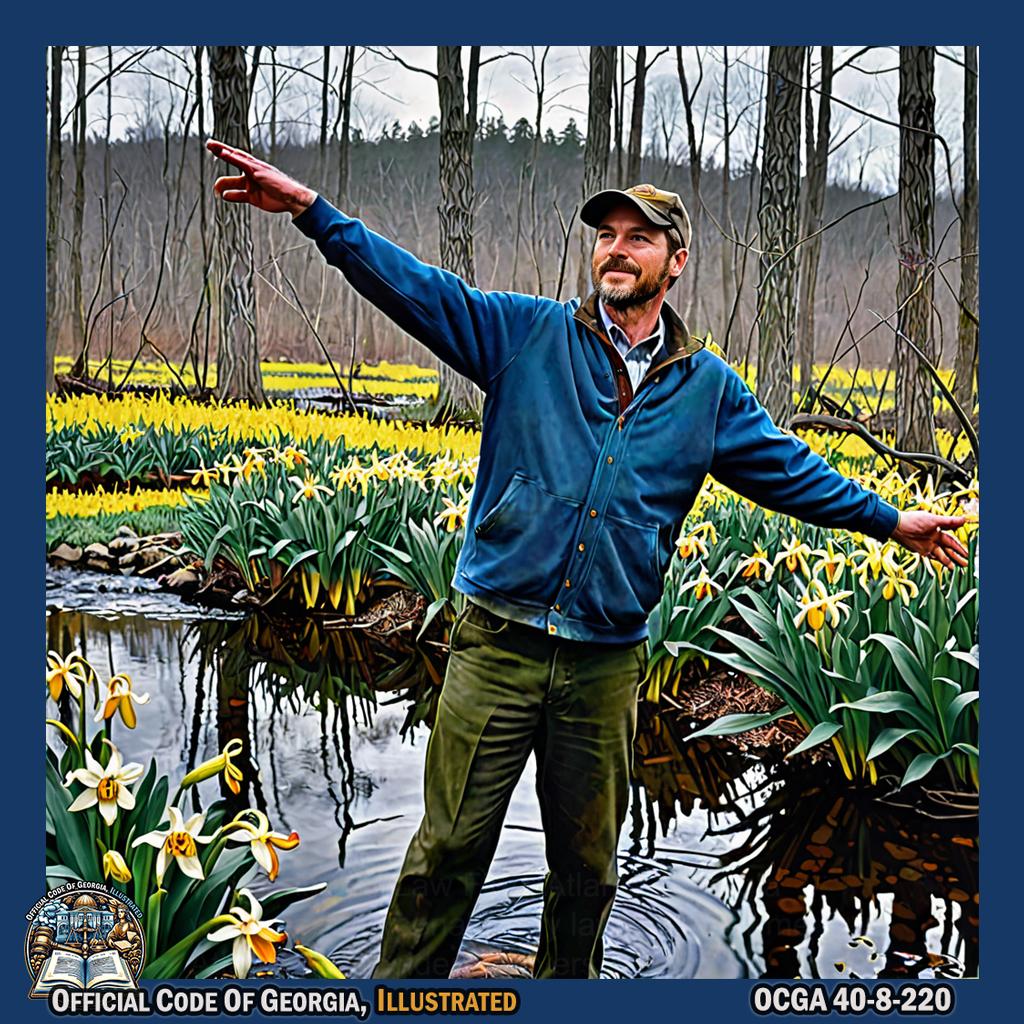
Josh Smith, surrounded by the rare and beautiful flowers of Wolf Creek Trout Lily Preserve, gracefully extends his arms as if casting a net over the landscape, embodying the authoritative implementation of rules and regulations with a mesmerizing dance-like motion captured in Robert Frank's artistic style. -@JsmooveNBA
40-8-221.Penalty.¶
Any person who violates any provision of this article shall be guilty of a misdemeanor.
40-8-222 through 40-8-264.[Repealed]¶
Article 5 Vehicle Equipment Safety Compact¶
- 40-8-280 through 40-8-291. [Repealed]

Electronic musician Benn Jordan dramatically rips a piece of paper in half, then throws the pieces into the air in a rich scene set in Carrollton, Georgia.